R
|
|
| Radulomyces confluens (a corticioid with no English name) |
 |
Jan 31, 2022.  In woodland near Jordans Village Jesper Launder noticed this typical corticioid on unidentified fallen deciduous wood. The species is described as having a rough lumpy surface, pale watery white when fresh but becoming drying with a pinkish tinge as here. A useful field character, noticed by Jesper, is its distinct smell of Phenol when scratched, but Jesper also confirmed his identification checking its distinctive spores. It is quite common but a first for our Finds pages. In woodland near Jordans Village Jesper Launder noticed this typical corticioid on unidentified fallen deciduous wood. The species is described as having a rough lumpy surface, pale watery white when fresh but becoming drying with a pinkish tinge as here. A useful field character, noticed by Jesper, is its distinct smell of Phenol when scratched, but Jesper also confirmed his identification checking its distinctive spores. It is quite common but a first for our Finds pages.
|
Radulomyces molaris (Oak Tooth Crust)  |
 |
Nov 5, 2022. In Austenwood Common near Chalfont St. Peter Jim Wills found this corticioid species on a fallen Oak branch. The species is often found after strong winds and favours Oak branches high up in the canopy which then end up on the ground. |
 |
Feb 25, 2022. On fallen Cherry at Stampwell Farm Jackie Ewan picked up this resupinate fungus - one which favours dying branches high up in the canopy so tends not to turn up until after strong winds (of which there've been plenty recently!). It is commonest on Oak but is not unheard of on other deciduous woods and is quite similar to Basidioradulum radula (Tooth Crust)though not so pale and more distinctly toothed also. |
| Ramaria flava (no English name) |
  |
Sep 13, 2020.  Richard Fortey found this very rare coral fungus in litter under Beech at Pullingshill Wood (photo Andrew Padmore), a new species for Bucks with extremely few recent records in the UK. We commonly find Ramaria stricta (Upright Coral) in our woodlands and can identify it in the field but seldom find other species of the genus, all of which need careful work with a scope to identify here undertaken by Richard. Richard Fortey found this very rare coral fungus in litter under Beech at Pullingshill Wood (photo Andrew Padmore), a new species for Bucks with extremely few recent records in the UK. We commonly find Ramaria stricta (Upright Coral) in our woodlands and can identify it in the field but seldom find other species of the genus, all of which need careful work with a scope to identify here undertaken by Richard.
|
| Ramaria stricta (Upright Coral) |

|
Oct 22, 2025. In Tinkers Wood John Catterson noticed this coral fungus suddenly starting to make an appearance. It favours our Beech woodlands and though there are many quite similar species in this and the closely related genera they are mostly very rare and this is by far the commonest, sometimes fruiting in colonies of clumps in thick litter as here. |
  |
Dec 12, 2023. At Stoke Poges Memorial Gardens Penny noticed a large patch of Coral Fungus in thick woodchip amongst shrubs and noticed they looked surprisingly vinaceous reddish. It was not until getting nearer and finding a typical-looking fresh clump (photo 2) that she realised it was R. stricta but just well weathered and frosted - mostly not appearing in its more familiar guise as seen earlier in the season. It was also unexpected as she's not found the species here over the last 10 years or so. |
  |
Sep 24, 2020. Sarah Ebdon found this attractive Coral in woodland litter in Bradenham Wood. There are many species of Ramaria, all rare except for this one which is quite common and favours Beech woodland. The wine red bruising visible at the front of the cluster tends to occur as it ages or dries out. Note the digitiform branching tips to each stem. On collection one finds at the base a mass of white mycelial threads attached to the substrate. (Paul Goby took photo 2, a lovely example, in Bottom Wood on Oct 09.) |
| Ramariopsis kunzei (Ivory Coral) |
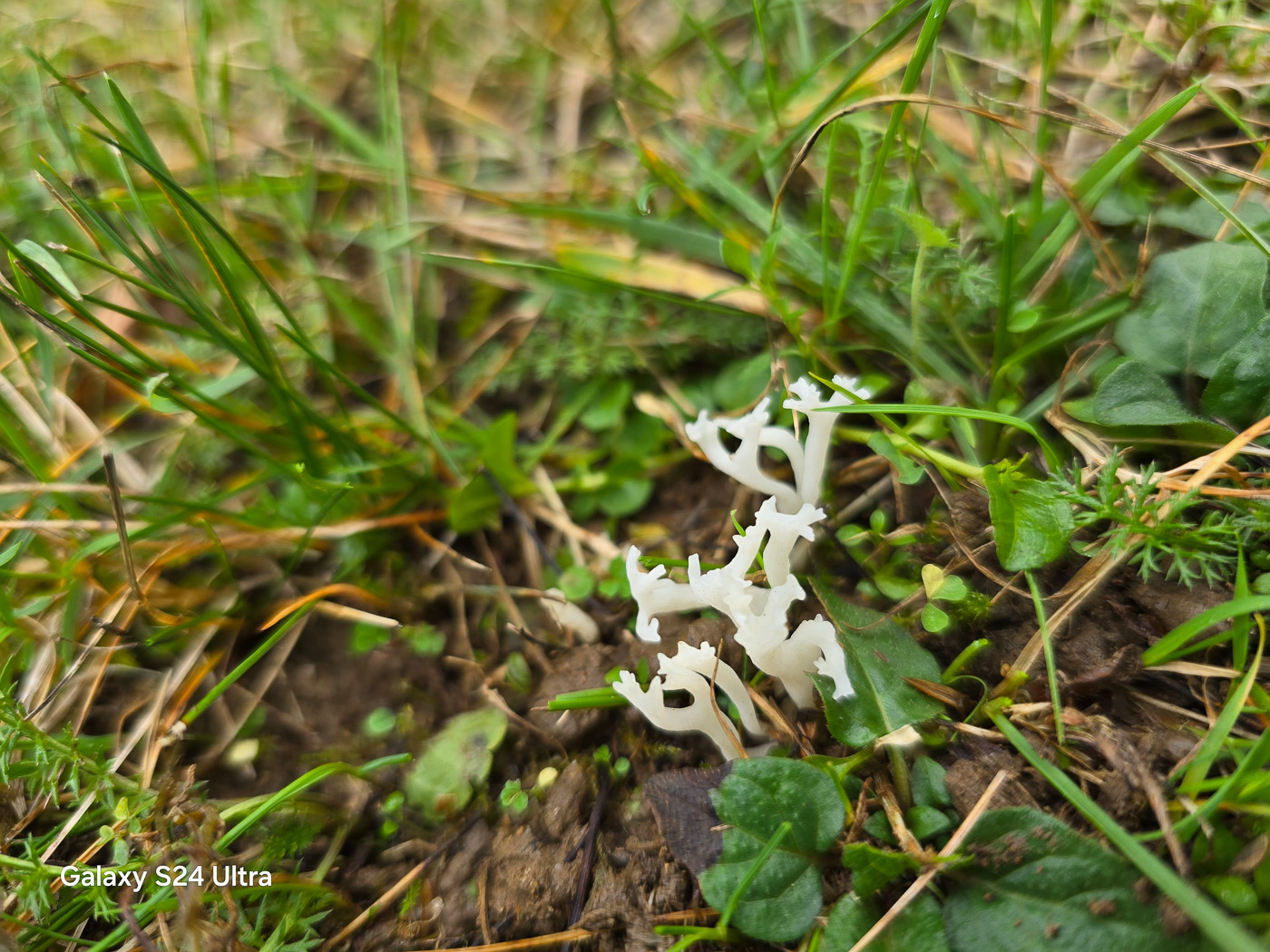 |
Oct 14, 2024.  In Jordans Village Jesper Launder found this delicate branching coral in a grassy patch, recognised it as having a very different jizz from the woodland Clavulina coralloides (Crested Coral). This is an a unusual grassland species though we now have quite a few records in recent years. In Jordans Village Jesper Launder found this delicate branching coral in a grassy patch, recognised it as having a very different jizz from the woodland Clavulina coralloides (Crested Coral). This is an a unusual grassland species though we now have quite a few records in recent years. |
 |
Dec 6, 2022.  In St. Giles Churchyard Penny and Claire Williams found two or three clusters of this attractive but small white grassland Coral - a species which is not that common though easily overlooked or misidentified. Rather like a white version of Clavulinopsis corniculata, it is not related and there are several quite similar white species hence the need to check which of these you have by the size, shape and ornamentation of the spores. (The photo is Claire's.) In St. Giles Churchyard Penny and Claire Williams found two or three clusters of this attractive but small white grassland Coral - a species which is not that common though easily overlooked or misidentified. Rather like a white version of Clavulinopsis corniculata, it is not related and there are several quite similar white species hence the need to check which of these you have by the size, shape and ornamentation of the spores. (The photo is Claire's.) |
 |
Nov 17, 2022.  In Prestwood Churchyard Penny found three nice clumps of this unusual white grassland coral species. It is one which needs a scope to check as there are other possibilities, but the colour, the branching tips, the stems arising from a single thick base together with subglobose finely ornamented spores distinguish it. The clumps were about 6 cm high. We have just a handful of previous records, this being the third from here. See also 2021 December 1st when I found it here previously. In Prestwood Churchyard Penny found three nice clumps of this unusual white grassland coral species. It is one which needs a scope to check as there are other possibilities, but the colour, the branching tips, the stems arising from a single thick base together with subglobose finely ornamented spores distinguish it. The clumps were about 6 cm high. We have just a handful of previous records, this being the third from here. See also 2021 December 1st when I found it here previously. |
  |
Dec 1, 2021.  In Prestwood Churchyard Penny noticed this white Coral just poking up through the grass and suspected it was something quite unusual so took it home to check. Sure enough the spores confirmed this as R. kunzei and were warty, small and subglobose with clamps present in the tissue also. We have just a handful of previous records for the county and it was new to the site - one which is proving extremely productive for interesting grassland species and still a site worth a visit now with fresh Waxcaps appearing despite the chilly recent conditions. In Prestwood Churchyard Penny noticed this white Coral just poking up through the grass and suspected it was something quite unusual so took it home to check. Sure enough the spores confirmed this as R. kunzei and were warty, small and subglobose with clamps present in the tissue also. We have just a handful of previous records for the county and it was new to the site - one which is proving extremely productive for interesting grassland species and still a site worth a visit now with fresh Waxcaps appearing despite the chilly recent conditions. |
| Ramariopsis subtilis (Slender Coral) |
 |
Oct 23, 2023.  At Stampwell Farm in longish grass Jackie Ewan found this unusual Coral - not one she's seen here before and it therefore took time plus microscopic examination to identify. The species has been placed in various different genera making it quite hard to track through our old records but we appear to have only a few county records. At Stampwell Farm in longish grass Jackie Ewan found this unusual Coral - not one she's seen here before and it therefore took time plus microscopic examination to identify. The species has been placed in various different genera making it quite hard to track through our old records but we appear to have only a few county records. |
 |
Oct 31, 2020.  Claire Williams found several clusters of this delicate white Coral in grassy vegetation in Prestwood Churchyard. On discovering that it was impossible to name without proper examination she delivered a sample to Penny C. the next day. Worth doing because the tiny warty spores proved to be those of this possibly not rare but certainly rarely recorded grassland species. The branching fragile 'antlers' are only up to 4 cm high and it is somewhat similar to Clavulinopsis rufipes (see photo dated Oct 25), also rare, but that species not only is rusty brown at the base but has smooth spores, not warty as here, hence the reason it's in a different genus. We have only a couple of previous county records of R. subtilis so this was a nice find. Claire Williams found several clusters of this delicate white Coral in grassy vegetation in Prestwood Churchyard. On discovering that it was impossible to name without proper examination she delivered a sample to Penny C. the next day. Worth doing because the tiny warty spores proved to be those of this possibly not rare but certainly rarely recorded grassland species. The branching fragile 'antlers' are only up to 4 cm high and it is somewhat similar to Clavulinopsis rufipes (see photo dated Oct 25), also rare, but that species not only is rusty brown at the base but has smooth spores, not warty as here, hence the reason it's in a different genus. We have only a couple of previous county records of R. subtilis so this was a nice find. |
| Resinicium bicolor (Hallowed Crust) |
 |
Nov 16, 2023.  On a conifer log in Bernwood Forest Jesper Launder noticed this patch of corticioid fungus and took a sample home to examine. Though quite similar to many other species found on fallen wood in the field, under the scope this species is very distinctive and has some cells tipped with snowflake-like crystals which make it quite easy to confirm its ID if you can find them. This is quite an unusual species and is a new entry for Finds. On a conifer log in Bernwood Forest Jesper Launder noticed this patch of corticioid fungus and took a sample home to examine. Though quite similar to many other species found on fallen wood in the field, under the scope this species is very distinctive and has some cells tipped with snowflake-like crystals which make it quite easy to confirm its ID if you can find them. This is quite an unusual species and is a new entry for Finds.
|
Resupinatus applicatus (Smoked Oysterling)  |
  |
Jan 6, 2023. On rotting fallen deciduous wood at Burnham Beeches Claire Williams spotted this tiny 'pleurotoid' fungus though it was not a species she recognised. Obviously similar to genus Crepidotus, of which there a quite a few different species - all also named Oysterlings, this was a different shape with no sign of a stem and with gills radiating from a central rather than an eccentric point as in that genus. It was only about 5mm across with another even tinier example beginning to develop and visible just underneath it in both her photos. When mature the species tends to turn greyish - hence its common name, but when fresh as here it is typically this beige colour. |
  |
Nov 7, 2022. In his garden on some broken bits of garden chair left under a hedge, Russell Ness noticed what looked initially like a swarm of tiny grey cups, but on closer inspection once they started to open up they had gills. A scope revealed small round spores and from there he was able to key out this species, one for which we have a smattering of county records but it is a new entry for Finds. |
Resupinatus trichotis (Hairy Oysterling)  |
   |
Jan 15, 2023. In Burnham Beeches on a fallen rotting Beech log Russell Ness noticed these tiny greyish fungi and took them home to work on. Similar to the genus Crepidotus in both size and shape, Resupinatus is a small genus with grey rather than white fbs, under 1 cm across, with two species which occur on deciduous woods - today's being much less commonly recorded than R. applicatus. Note the hairy black area near where it joins the substrate - this being indicative of the species and lacking in the commoner species though the two can be hard to separate and both have similar sized spores. To compare, see Finds 2020 Feb 3rd for an earlier collection of this species, also 2021 November 7th for R. applicatus. |
  |
Feb 3, 2021. In his veg patch at home, Barry Webb noticed these tiny little dark grey stemless caps growing in a tier out of a crack in a bamboo cane supporting his broccoli! They were strikingly hairy but at most 4 mm across and the concolorous gills had a white edge. Posting his photos online for a possible name, he received a couple of suggestions: a species of Hohenbuehelia or Resupinatus trichotis. He then sent the fresh specimens to Penny and the microscopic details quickly confirmed this was not Hohenbuehelia but was indeed the suggested Resupinatus - a species unfamiliar to Penny. Our county database reveals just three previous records, all on rotting deciduous wood of one sort or another, but Penny suspects the substrate here is somewhat unusual and noteworthy! |
| Reticularia lycoperdon (Moon Poo / False Puffball) |
  |
Apr 3, 2023. At Stampwell Farm Jackie Ewan spotted this large Slime Mould on the trunk of an old Plum tree, taking a series of photos over the space of three days to show its development. Photo 1 is of an early still very soft and slimy plasmodium stage, followed by photo 2 at the 'eyeball' stage having dried off when its similarity to a puffball gives rise to is species name, and finally photo 3 as the outer skin starts to disrupt revealing the cocoa brown spore mass beneath. |
 |
Apr 2, 2021. Jesper Launder found this large slime mould in Hodgemoor Woods growing on Hazel - one of several examples he's seen in the last few days. Contrary to most slime moulds which are tiny and inconspicuous, this one can indeed get to the size of a puffball (hence its common and species name). It starts out at the plasmodium stage as many others: a large bumpy white blob looking a bit like insect eggs - this is the slimy stage. Then instead of developing into many separate tiny sporangia (fruit bodies) as it dries off and matures, it stays as a large white lump (an eyeball!) becoming smooth until eventually splitting open to reveal the brown spore mass within. Jesper's example is just at the beginning of the smooth stage. |
  |
Sep 20, 2020. This slime mould was first noticed by Paul Goby on a Beech log in Naphill Common two days earlier (see first photo) when at the slimy undeveloped stage and still unidentifiable (ie looking exactly like many others). He was surprised to find how different it appeared today! It is only once a slime mould has dried off and taken its final form that spores and other microscopic features reveal its identity. This particular species, forming a round white blob about 4cm across with a skin which breaks down to allow the brown spore mass to disperse, can be named in the field once at this stage. |
| Rhodocollybia asema (Pale Butter Cap) |
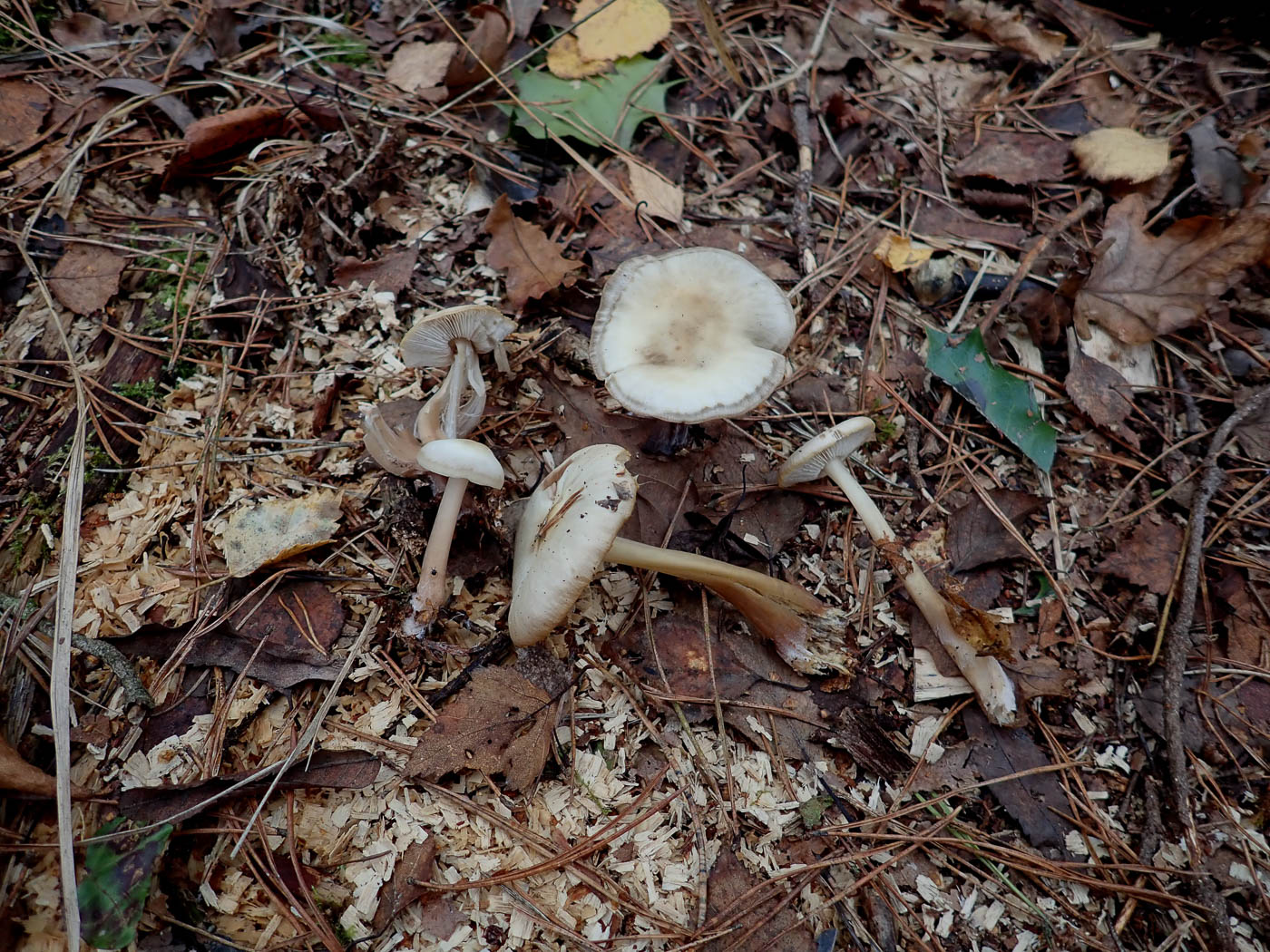 |
Nov 4, 2024. In Burnham Beeches under mixed trees Penny found a patch of very pale capped Butter Caps, and having just learnt from Geoffrey Kibby that though previously considered just a pale variety of R. butyracea, this var. asema has apparently now been raised to specific status. So in effect this is a new species name for the county but will not count as such because we've been well aware of the wide variety of cap colour in specimens for some time. There will no doubt be intermediates found which are tricky to decide which name to apply, but for now this pale collection seem to fit the bill as R. asema. Previous entries for R. butyracea certainly include one other which should now be moved to R. asema in due course.
|
| Rhodocollybia butyracea (Butter Cap) |
  |
Jan 1, 2023. In Bradenham Churchyard there was surprisingly little fungi about: only a few Fragrant Funnels (as seen also above) and this pair of very dark capped Butter Caps. Turning the larger cap over revealed the expected hollow rather swollen stem with purple tendencies which contrasted with the very pale gills - enough to confirm the ID. See the Masterlist for more examples - the cap colour is very variable in this species. |
 |
Jan 1, 2022. At Turville Heath in grassy litter under Birch Penny found just this one rather atypical clump and was in doubt as to its identity till she felt the greasy cap surface and saw the white gills with the correct attachment for this common late season species. |
 |
Nov 13, 2021. At Turville Heath under Birch Penny found various examples of this species which, though one of our commonest woodland mushrooms, often causes confusion amongst the less experienced, being very variable. The cap colour can be anything between deep reddish brown to almost white (when dry) but typically has a greasy feel to it - hence its common name. The gills are whitish, almost free and contrast markedly with the stem colour, often with purple tints lower down and also tapering upwards. These features are visible in the photo - note also the far right cap which has a white deposit from its overlapping neighbour (before Penny moved it!). |
  |
Oct 22, 2020. We do already have this species, dated Oct 13th, but the photo is of rather pale washed out material. Today both Paul Goby in Naphill Common and Paul and Penny in Hodgemoor Woods found beautiful fresh collections showing the features well. Photo 1 from Hodgemoor shows the smooth greasy caps which have a central umbo and are paler towards the margin; photo 2 from Naphill shows the pale crowded gills contrasting with the darker hollow tapering stem which often has a purplish tint. This is a very common and very variable species and often fools people but the underside view is usually diagnostic. Tip: feel the surface of the cap with your finger for the greasy buttery texture. |
 |
Oct 13, 2020. Previously in the genus Collybia, this species is normally considered a late season fruiter so its appearance at Pulpit Hill in Conifer litter today , found by Penny Cullington, could indicate that our fruiting season is winding down already? This is a deceptive species and often causes confusion over its identity in the field because the cap colour is extremely variable, from dark reddish brown when fresh and moist to almost white when drier. The stem is often a useful pointer, however, and is hollow (pinch it to feel this) and typically tapers upwards with a darker lower part which tends to have a purple hue. The young specimens at the bottom show this nicely. The common name arises from the very greasy feel to the cap surface if you stroke it, but be aware that when really dry this will be far less obvious! |
| Rhodocollybia maculata (Spotted Toughshank / Cocoa Spot) |
 |
Sep 15, 2020. Penny Cullington found a large patch of this quite common species fruiting under Pine at Burnham Beeches. More familiar as Collybia maculata, its key characters are the white cap which develops chocolate spots as it matures (hence its older but more descriptive common name), its very crowded and tightly packed white gills and the rubbery flexible stem typical of what used to be the genus Collybia (now split into either Rhodocollybia or Gymnopus). It mostly occurs under Pine but also under deciduous trees.
|
| Rhodocybe fumanellii (a species of Pinkgill new to Britain) |
   |
Sep 28, 2020.  Penny C. found this species, only first described in 2018 from Italy, growing on a pile of Ash branches in Rushbeds Wood. She knew it was something unusual because it didn't key out as any of the known Rhodocybe species, so took the opportunity to have a sample sequenced and both its DNA sequence and her description matched that described for this species. Caps can get to 7 cms across or more and are reddish rusty brown, fading as they dry out but leaving a dark zone around the margin, gills are crowded and pale cream to pinkish with many lamellules (part gills which don't reach the margin), stems are concolorous with gills and have a mesh of mycelium at the base with attached debris. It has a sweetish fruity smell. As far as can be ascertained this is the second known world collection. Penny C. found this species, only first described in 2018 from Italy, growing on a pile of Ash branches in Rushbeds Wood. She knew it was something unusual because it didn't key out as any of the known Rhodocybe species, so took the opportunity to have a sample sequenced and both its DNA sequence and her description matched that described for this species. Caps can get to 7 cms across or more and are reddish rusty brown, fading as they dry out but leaving a dark zone around the margin, gills are crowded and pale cream to pinkish with many lamellules (part gills which don't reach the margin), stems are concolorous with gills and have a mesh of mycelium at the base with attached debris. It has a sweetish fruity smell. As far as can be ascertained this is the second known world collection.
|
| Rhodocybe gemina (Tan Pinkgill) |
 |
Dec 12, 2023. Under a large Cedar at St Giles Churchyard, Stoke Poges, Penny found this unusual species - not recorded her previously. Though not common, it is a regular fruiter at several sites, notably Rushbeds Wood and Bradenham Churchyard (where it is under Yew in several spots). The cap colour is more pink than tan, as are the gills (hence its common name though not related to Entoloma - the main Pinkgill genus). It is a chunky mushroom with thick flesh when mature and getting to anything up to 12 cm across. |
 |
Nov 1, 2023. In Bradenham Churchyard Penny was pleased to find this quite unusual species coming up under the Yew in a couple of places where she's found it in previous years. (In fact there's Yew berry having fallen onto the cap here!) This is a large chunky mushroom and seems to favour grassy path edges - we see it regularly in Rushbeds Wood though do not have that many sites for it. |
 |
Aug 19, 2023. At Rushbeds Wood Penny was hopeful of finding this unusual species which regularly occurs along the old tram track here. Though the grassy edges had unfortunately recently been shaved of vegetation she found it fruiting in several spots. This is a large chunky mushroom with a pinkish buff cap and pink decurrent gills, though is not closely related to the genus Entoloma despite its shared common name. Of the handful of county sites where we've found it half the records are from the tram track here. |
   |
Nov 18, 2021.  In Bradenham Churchyard Penny at first found this singleton under Yew (photos 1 and 2) but then under another Yew found several more though the darker cap colour made her doubt if it was the same species (photo 3). At home the microscopic features were identical and matched this quite unusual and chunky mushroom, considered an occasional fruiter and one which Penny had found here last year. In Bradenham Churchyard Penny at first found this singleton under Yew (photos 1 and 2) but then under another Yew found several more though the darker cap colour made her doubt if it was the same species (photo 3). At home the microscopic features were identical and matched this quite unusual and chunky mushroom, considered an occasional fruiter and one which Penny had found here last year. |
 |
Oct 13, 2021. In Rushbeds Wood Joanna Dodsworth found this unusual mushroom coming up beside a path in the same spot where we've recorded it in three previous years, the earliest being 2005 but with a gap then till 2019. The common name is perhaps confusing because this is not an Entoloma (also named the Pinkgills) despite having pink gills though its spores are pink but are not shaped like Entoloma spores. This is quite a big chunky mushroom with pinkish tones in the cap as well which is slightly hygrophanous (fades as it dries) and the gills are more or less decurrent and quite widely spaced. It seems to be becoming more common in the area with several records elsewhere in the county in the last few years. |
 |
Sep 10, 2020. Penny found several collections of this sometimes rare species at Rushbeds Wood growing beside a path in grassy soil. It has 'good years' but in other years is hardly recorded at all though it seems to turn up quite frequently at this particular site. So it's one to look out for locally at the moment. |
| Rhodotus palmatus (Wrinkled Peach) |

|
Sep 27, 2025. In Tinkers Wood John Catterson noticed the first fruiting of this species which seems to be a regular here, presumably indicating a good supply of Wych Elm though it appears to be possible that though described as host specific with Elm it is now beginning to transfer to other fallen deciduous woods. |
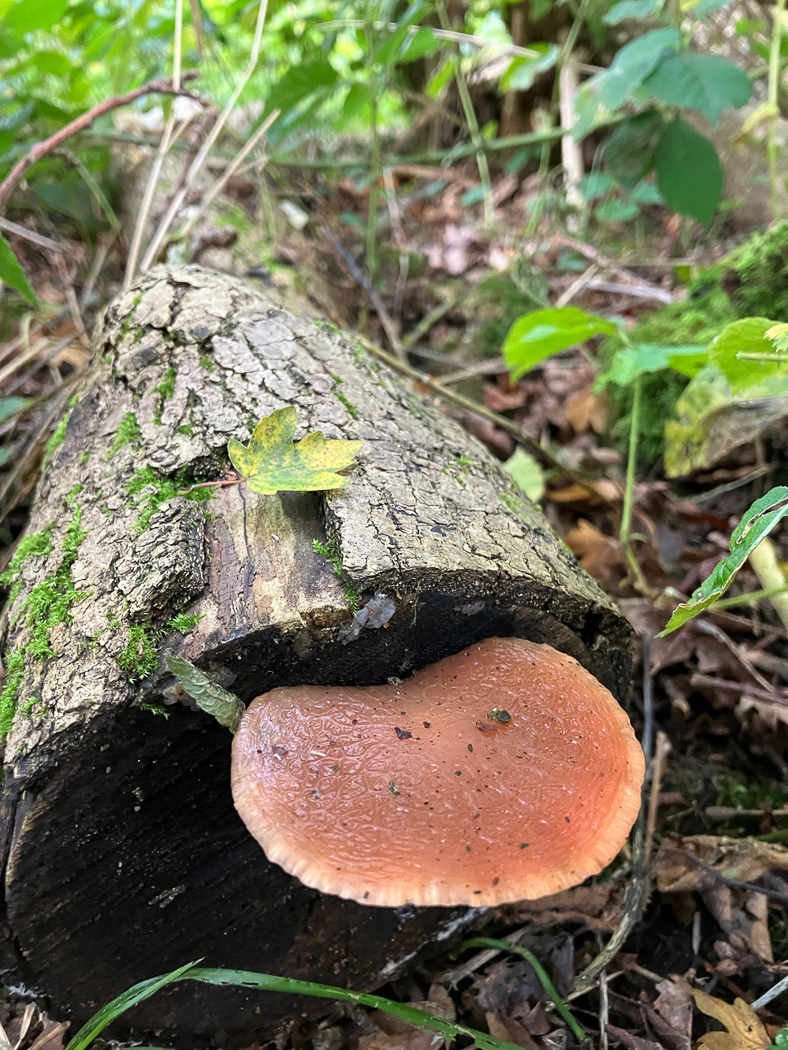    |
Oct 5, 2024. At Linford Wood Justin Long spotted this attractive and unusual species in two separate spots, the mature specimen being on the end of an Ash log rather than on Elm with which it traditionally associates. Since the demise of Elms in the UK this species became something of a rarity but now seems to be making a comeback with increasing reports of its occurrence on other fallen deciduous woods. In fact a week after this find of Justin's on Ash Peter Townsend reported finding it on Beech at Ragpits Reserve (photo 4). In damp conditions and when fresh and just developing it tends to have these coloured droplets, and the wrinkled surface is showing beautifully in photo 3. |
   |
Oct 22, 2023. Several people have recently reported this species doing well, but this collection sent in by Laura Patterson takes the biscuit! In Tinkers Wood she estimates there were 60 fruitbodies on the one Elm trunk - amazing. In damp weather the droplets are very much a feature of the species and if present leave one in little doubt as to its identity. |
   |
Dec 28, 2022. In Bernwood Forest new member Chris Grimbly came across this distinctive species presumably fruiting on fallen Elm (though there are now records of it occurring on hardwoods other than Elm). The typical reticulation is nicely visible on these mature caps - a nice find so late in the season. |
  |
Dec 1, 2022. In Hughenden Valley, presumably on Wych Elm, Claire Williams noticed a small cluster of this beautiful and uncommon species just starting to emerge - a species she's found at this spot before. Photo 2 is Barry Webb's, taken a couple of weeks earlier at Hedgerley Common. See the Masterlist for further examples. |
 |
Nov 16, 2021. In Piggots Wood Claire Williams found this stunning cluster of an unusual species showing off all its attributes at their very best! The wrinkling on the top of the cap and the slightly ribbed stem with moisture droplets glistening make it unmistakeable. It favours fallen Elm / Wych Elm but is occasionally now found on other woods but is always a special thing to find. |
 |
Oct 1, 2021. In Disraeli Woods, Downley, Claire Williams noticed these tiny little specimens just appearing on some fallen Wych Elm which has produced this species in previous years. More or less host specific with Elm, it has become increasingly rare with the demise of Elm in the UK but is possibly adapting as there are now a few UK records on other woods. Fallen Wych Elm is still ones best bet to find it, however. |
  |
Oct 27, 2020. We have a beautiful photo of this species of fallen bare wood from very early on in the season, dated Sept 06, but it is still around as Penny C. discovered today in a wood near Ibstone. It is fussy about the wood it inhabits, in years gone by being host specific with Elm which would account for its rarity nowadays. However, it is happy on fallen Wych Elm but today it was somewhat surprisingly growing on what appeared to be Elder. Though bare, the branch could be identified by the presence not only of Auricularia auricula-judae but also Hyphodontia sambuci (Elder Whitewash), both species which frequent that particular wood. (The Elder Whitewash can in fact be seen on the wood in the photo.) Maybe this species is adapting and having to change its allegienca in order to survive? To support this point, the next day Barry Webb found this stunning collection (photo 2) in Mousells Wood growing on fallen Oak. |
  |
Sep 6, 2020. Claire Williams found this beautiful and quite rare species in Little Tinkers Wood on Wych Elm. Its rarity is due to the demise of its host tree the English Elm though it does occur on Wych Elm and is occasionally reported from other deciduous trees. A further specimen is shown (though much drier reflecting conditions), found at Mousells Wood on Sept 24th by Penny Cullington, also on dead Wych Elm. |
| Rhopographus filicinus (Bracken Map) |
 |
Oct 11, 2021. At Stampwell Farm Jackie Ewan found this extremely common Ascomycete species which occurs on last year's bracken stems. It hardly protrudes from the stem almost appearing as part of its surface creating this distinctive pattern. Often it is hard to find a dead stem without it! |
 |
Dec 7, 2020. In Penn Wood Penny C. found examples of this very common Ascomycete which grows on old stems of Bracken. Not the most exciting fungus but a useful species to bump up numbers on any foray list if Bracken is present - it's quite tricky to find a patch of Bracken without it! |
| Rhytisma acerinum (Sycamore Tarspot) |
 .jpg) .jpg)
|
Sep 17, 2025. In Lacey Green churchyard Sarah Ebdon saw this very common pyrenomycete asco dotted all over the Sycamore leaves, both attached and fallen. Though often overlooked, it falls into the category we affectionately describe as 'Bums on seats' ie species which serve to fill up our foray lists when fungi are in short supply - if the host tree is present one can almost list the species before seeing it because it's bound to be there! Unlike the tiny cup fungus responsible for Ash Dieback, however, it is apparently unharmful to the host tree. |
 |
Nov 4, 2020. Joanna Dodsworth picked up this fallen Sycamore leaf in Brill Common as it was such a good example of this very common Ascomycete literally covering the upper surface. It is the exception rather than the rule to find a Sycamore tree without this apparently harmless fungus in evidence on its leaves. They appear from July onwards on living leaves forming their typical black patches which do not release their spores till the following spring.
|
| Rickenella fibula (Orange Mosscap) |
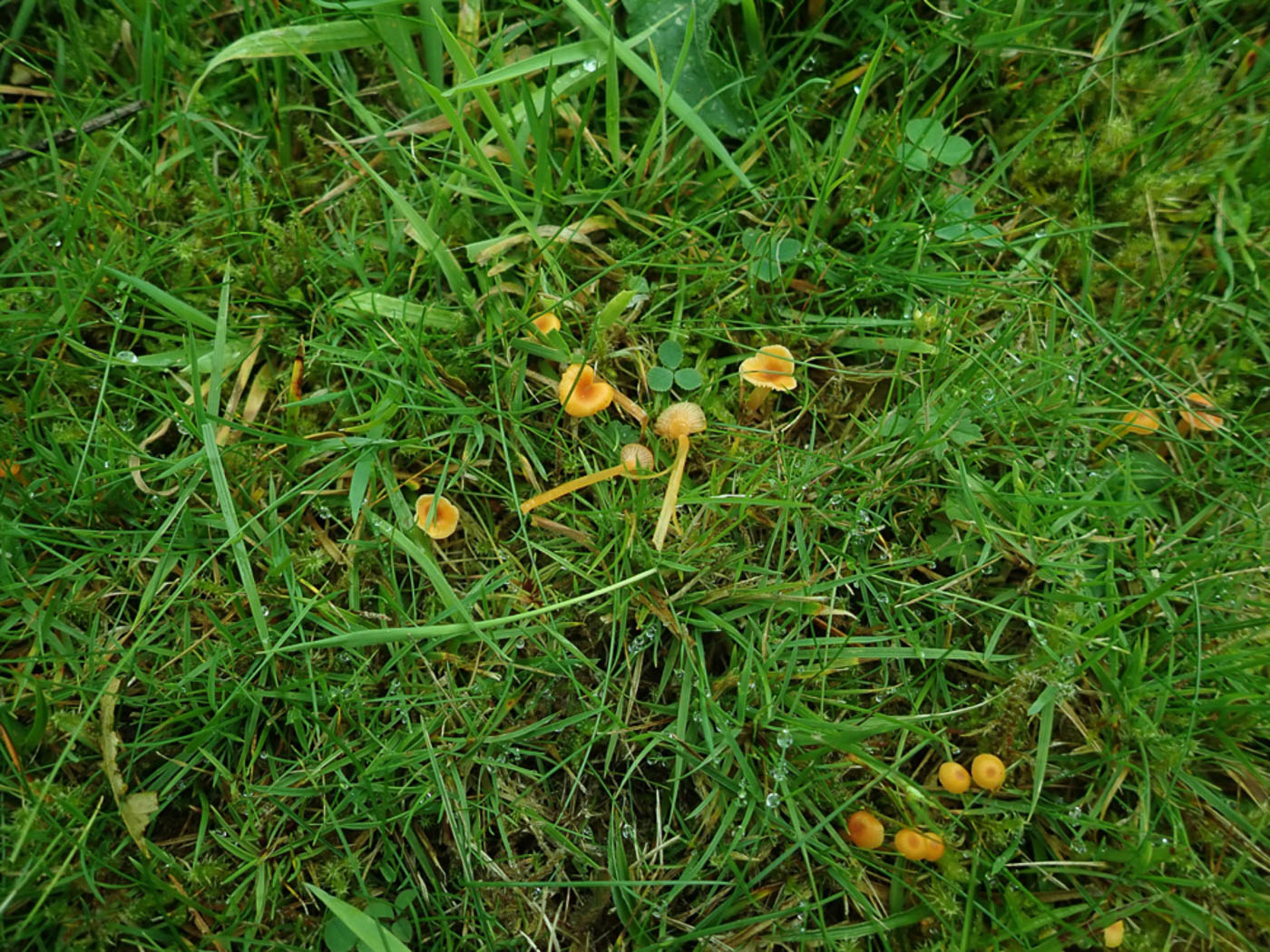 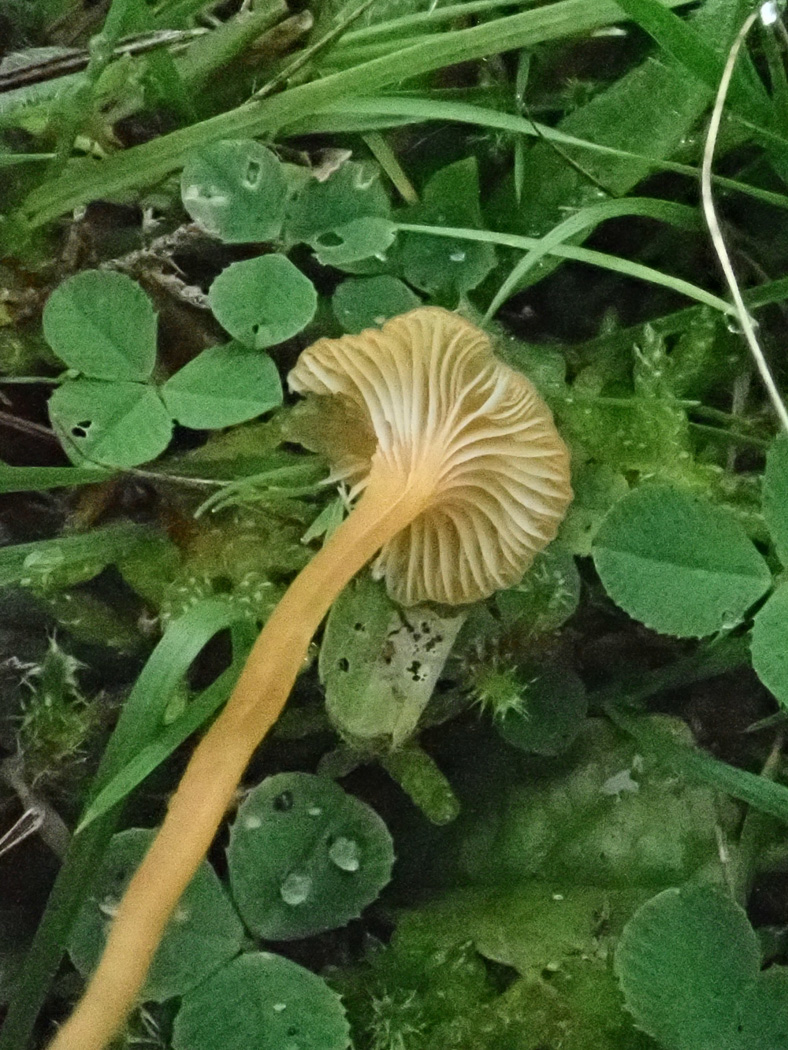
|
Sep 18, 2025. In Prestwood churchyard Penny found very little of interest but these bright orange Mycena-like fungi in the mossy lawn caught her eye and seemed worthy of mention. Their colour can fade to almost white when in bright sunlight when they appear even more Mycena-like but the strongly decurrent gills and occurrence in moss should alert one to their identity. They are much more common than the closely related R. swartzii which is similar in shape and size, also occurs in moss but is very different in colour. |
 |
May 31, 2024. This attractive little Mycenoid mushroom was found by Jackie Ewan at Stampwell Farm growing in mossy grass. It can also occur on fallen wood but only if it is moss-covered - the moss being essential for this species. To separate it from the quite similar Mycena acicula (Orange Bonnet) note both the clearly decurrent gills and stem concolorous with cap, not yellow as in the Mycena which favours woody debris and is often much smaller too. |
 |
Jul 9, 2021. In short mossy grass at Stampwell Farm Jackie Ewan found this tiny and common species, one that at first glance could be a small Mycena (Bonnet) especially M. acicula which also has an orange cap, It differs, however, in lacking the contrasting bright yellow stem of that species and also has remarkably decurrent gills. It is common in moss everywhere. See also the less common R. swartzii (in Finds 21 Jan to June dated June 30th) which is similar but a completely different colour. |
  |
Oct 24, 2020. Penny C. found these young and tiny fruit bodies just emerging though the moss on a stump in Gussetts Wood. A common species always found in moss, it looks like a small orange-capped Mycena (Bonnet) but has strongly decurrent and rather widely spaced gills (best seen with a hand lens). Today's specimens were well under 5 mm across but it can get to more than 1 cm across. There is another much less common but equally small species called R. swartzii which also grows in moss but is greyish with a dark purplish centre and has greyish decurrent gills. Worth looking out for. |
| Rickenella swartzii (Collared Mosscap) |
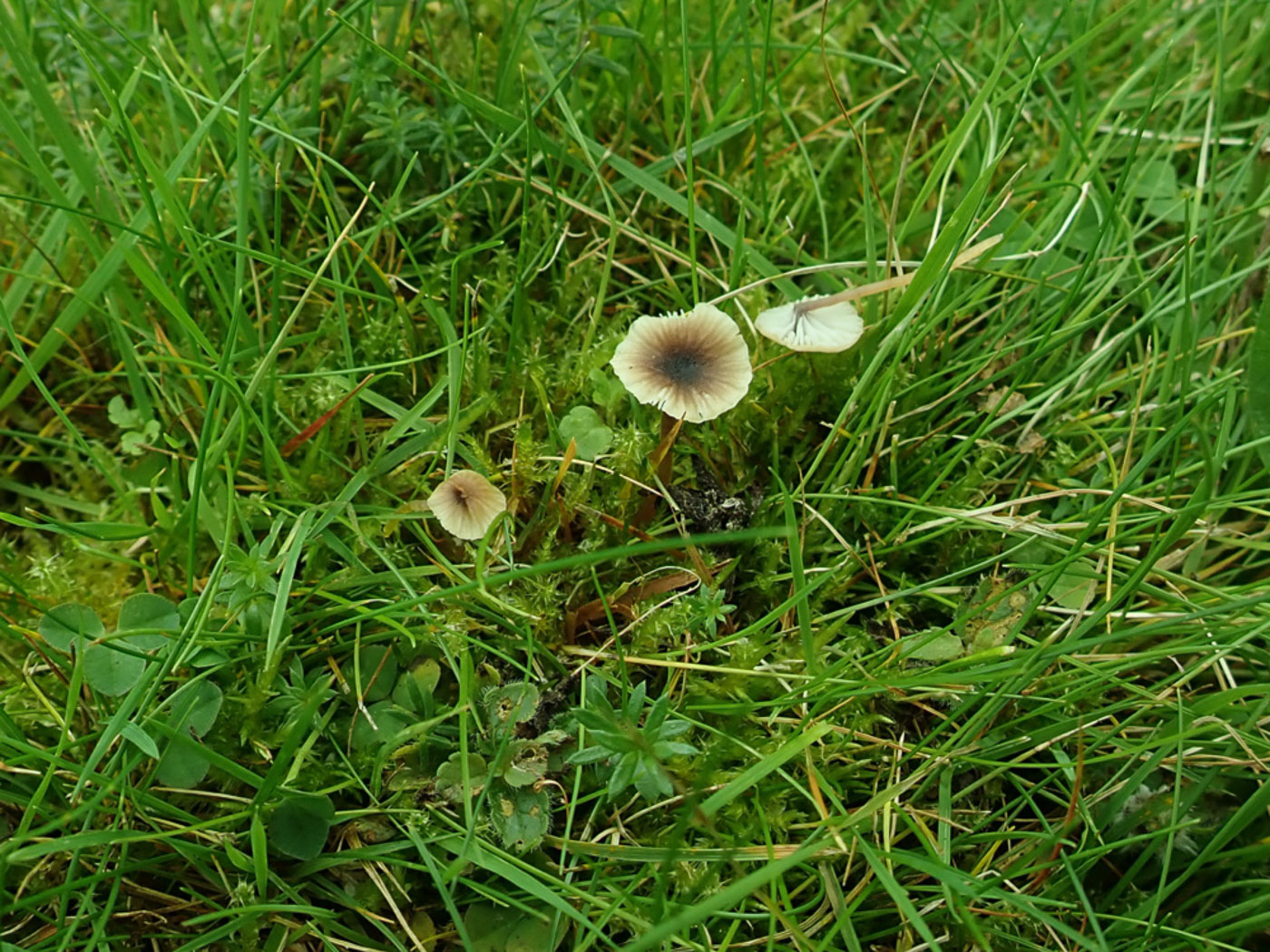
|
Sep 18, 2025. In Bradenham churchyard Penny noticed just a very few of these Mosscaps in the mossy lawn. They are very like the much more common R. fibula (Orange Mosscap) in shape and size, sharing the decurrent gills though these are less pronounced, but have a dark purplish brown sunken cap centre with pale surround, and the stem apex - rather than actually collared - is purplish brown in contrast to the white gills. |
  |
Apr 24, 2023. At Stampwell Farm in moss Jackie Ewan found these somewhat insignificant 'Mycenoid' mushrooms. The species could easily be mistaken for a small grassland Mycena and is far less common than the bright orange R. fibula (Orange Mosscap) but the decurrent gills together with the dark purplish area collaring the top of the stem make it an easy one to recognise once you're familiar with it. The caps are often not as brown as seen here, the paler specimens being more typical. This is BFG's first April record and we have just a few from June and January, the rest all from the Autumn months. |
  |
Dec 6, 2022. In St. Giles Churchyard Penny found just this one singleton in the moss. This is a pretty little Mycenoid species, similar to R. fibula (Orange Mosscap) but with a dark cap centre, pale decurrent gills and also a dark stem apex. It is far less common than the orange species. |
 |
Jun 30, 2021. In short mossy grass at Stampwell Farm Jackie Ewan found this tiny mushroom, it being much the less common of the two species of Mosscap. At first glance this could be a small Mycena (Bonnet) but it lacks the microscopic features of that genus and is notable for its strongly decurrent (sloping) gills and the dark purple dot in the sunken cap centre, clearly visible in the photo. The much more common and orange R. fibula is the same size and shape and both species are found in moss. See R. fibula for comparison in Finds 21 July to Dec dated July 9th. |
  |
Nov 2, 2020. Penny C. found just one of these tiny mushrooms in thick moss in Bradenham Churchyard, then several more on the neighbouring Cricket Pitch. Much less frequent than R. fibula (see photos dated Oct 24), this species is very similar in size and shape (the caps here were only 5 mm across) but instead of bright orange the caps are pale cream with a dark purple brown sunken centre, gills are white and strongly decurrent, stems are very flimsy with a purple apex. Both species occur in moss. |
| Rigidoporus ulmarius (Giant Elm Bracket) |
  
|
Aug 8, 2025. In a garden in Bledlow Sarah Ebdon saw this bracket, about 20 cm across, at the base of a Horse Chestnut tree and at first glance thought it might be a Ganoderma from its shape and bumpiness but on closer inspection realised it was different and unfamiliar to her. The texture was firm, yes, but rubbery rather than woody like Ganoderma, also the pores had a peachy tint and the line left by a scratch was not the typical chocolate brown of that genus. This suggested that the spores were not cocoa-coloured (they are in fact whitish in this bracket) and breaking a piece off revealed distinctly orange layers in the tubes (immediately under the outer pore surface). Research at home brought her to the Rigidoporus, this confirmed for her by Claudi Soler a day or so later, an uncommon bracket seen frequently on dying Elm stumps during the Dutch Elm disease era then decreasing with the demise of that tree though also found on various other deciduous trees and perhaps now most frequent on Horse Chestnut. It can grow to enormous proportions - up to a meter across! - when often coated in green algi, its size then making it unmistakeable but when smaller as here it can be confused with other similar shaped species. |
   |
Feb 18, 2024. On the banks of the Thames in Eton (apparently just within VC24!) Russell Ness came across this enormous and impressive bracket, about 3ft across, on a rotting stump - possibly Poplar. A passer-by informed him that it had been there for years. Once commonest on old Elm stumps (hence its species name) it can occur on several other broadleaved stumps including Poplar. There are examples online showing a coating of algi as here. This is a new entry for Finds though the species is not that uncommon.
|
| Ripartites tricholoma (Bearded Seamine) |
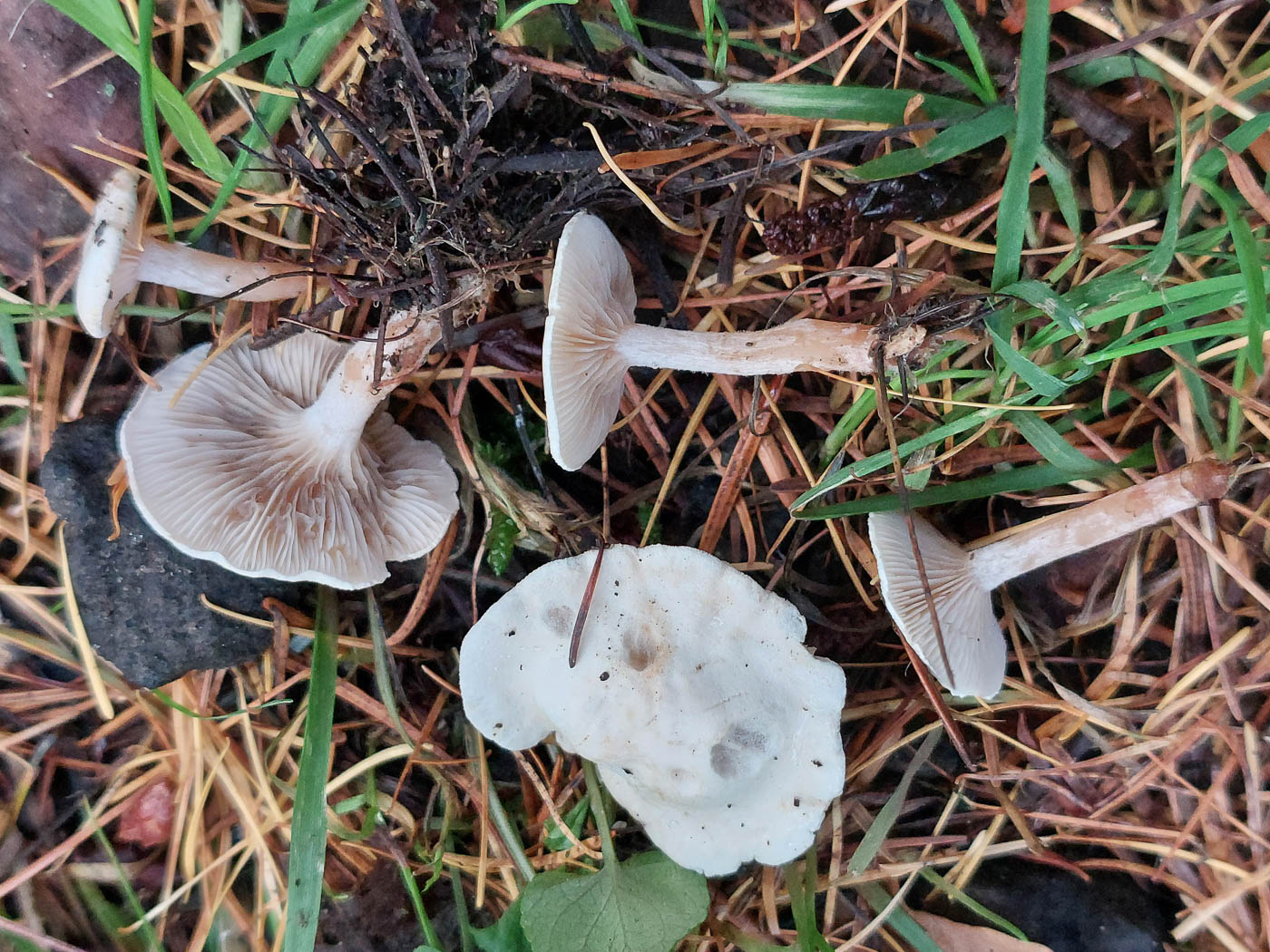
|
Nov 8, 2025.  In Greenacre Burial Ground (Beaconsfield) Jesper Launder found this unusual mushroom amongst the conifer litter. It is one which is very easy to mistake for a species of Clitocybe (Funnel) in the field. However, once under the scope the small pale brown subglobose spiny spores separate it from that genus, as also does the finely hairy cap margin though this feature is not always at all obvious. The name Seamine refers to the spores which are similar to maritime mines. In Greenacre Burial Ground (Beaconsfield) Jesper Launder found this unusual mushroom amongst the conifer litter. It is one which is very easy to mistake for a species of Clitocybe (Funnel) in the field. However, once under the scope the small pale brown subglobose spiny spores separate it from that genus, as also does the finely hairy cap margin though this feature is not always at all obvious. The name Seamine refers to the spores which are similar to maritime mines. |
  |
Jan 12, 2022.  At Lacey Green Churchyard Sarah Ebdon found just this singleton in conifer litter, took it home to work on, then tentatively (and correctly) suggested to Penny this name. Somewhat similar to a smallish Clitocybe species (for which it is most likely often mistaken) the gills are a bit too coloured for that genus and the cap is somewhat hairy - though Sarah noted that this feature became much less apparent a few hours after collection. The confirmation, however, comes from its small roundish and clearly but finely spiny spores (hence its common name) - not found in Clitocybe. We have extremely few records of this species. See also in the report for Bittam's Wood, October 31st 2021. At Lacey Green Churchyard Sarah Ebdon found just this singleton in conifer litter, took it home to work on, then tentatively (and correctly) suggested to Penny this name. Somewhat similar to a smallish Clitocybe species (for which it is most likely often mistaken) the gills are a bit too coloured for that genus and the cap is somewhat hairy - though Sarah noted that this feature became much less apparent a few hours after collection. The confirmation, however, comes from its small roundish and clearly but finely spiny spores (hence its common name) - not found in Clitocybe. We have extremely few records of this species. See also in the report for Bittam's Wood, October 31st 2021.
|
| Roridomyces (previously Mycena) roridus (Dripping Bonnet) |
 |
Nov 20, 2023. On a small fallen Beech branch at Burnham Beeches Barry Webb noticed these very slime-coated Bonnets and recognised them as this species – previously in genus Mycena. Thee species is unique amongst Bonnets in having a thick glutinous layer of slime covering the stem and also having distinctive decurrent gills. (Others may have a sticky stem but not this clear glutinous layer which when held against the light is unmistakeable.) it favours acidic areas (hence its occurrence here) and can often be found on thin woody stems such as Bramble though does also occur on fallen wood as here. It is not rare though has not been found previously this year in the county. |
   |
Nov 27, 2022. At Turville Heath Penny found this little cluster of Bonnets in woody debris on the ground and took the first photo thinking the species was quite possibly M. speirea (see that species below). It was not until she turned it over, noticed the prickly substrate was an old Bramble stem and that the stems of the collection were glistening with slime that she realised her error! There are clear similarities between the two species, notably the small size, the pale off-white caps with slightly darker centre (see photo 3) and the clearly decurrent gills. But R. roridus (previously in genus Mycena) is alone amongst Bonnets in having a thick layer of shiny slime (really thick after recent rain as here!), making it unmistakable once it's noticed. Rather than mossy logs it favours woody debris and Bramble stems in particular. This is a first entry for Finds though the species is considered not rare but occasional and is always nice to find. |
   |
Oct 15, 2022. On a dead Bramble stem at Holtspur Bank Penny found these small whitish Bonnets and at first glance thought they were Mycena speirea, then noting the prickly host stem she wondered if it just might be this Roridomyces (until recently in Mycena), for which the diagnostic characters are the decurrent gills and layer of thick slime all over the stem. Sure enough, with a hand lens the slime was obvious, confirming its ID. The species is not rare but is one that is easily overlooked if one doesn't notice the glistening slimy stem, and it often seems to be found on Bramble as here. This is new for Finds, and apologies for the quality of the photos - not Penny's best! |
 |
Nov 3, 2020. Russell Ness noticed this single specimen growing in vegetation in Egypt Woods, Burnham Beeches. Here is more proof that this particular part of S. Bucks has acidic soil in a predominantly calcareous area, this Bonnet being one which mainly occurs in heathland and acid woodland. On first glance it is a typical pale capped Bonnet having decurrent gills but the stem is covered in a layer of slime (even more apparent after rain) which is the diagnostic field character. Look for it on bramble stems in thick vegetation. |
| Rubroboletus legaliae (Bilious Bolete) |
 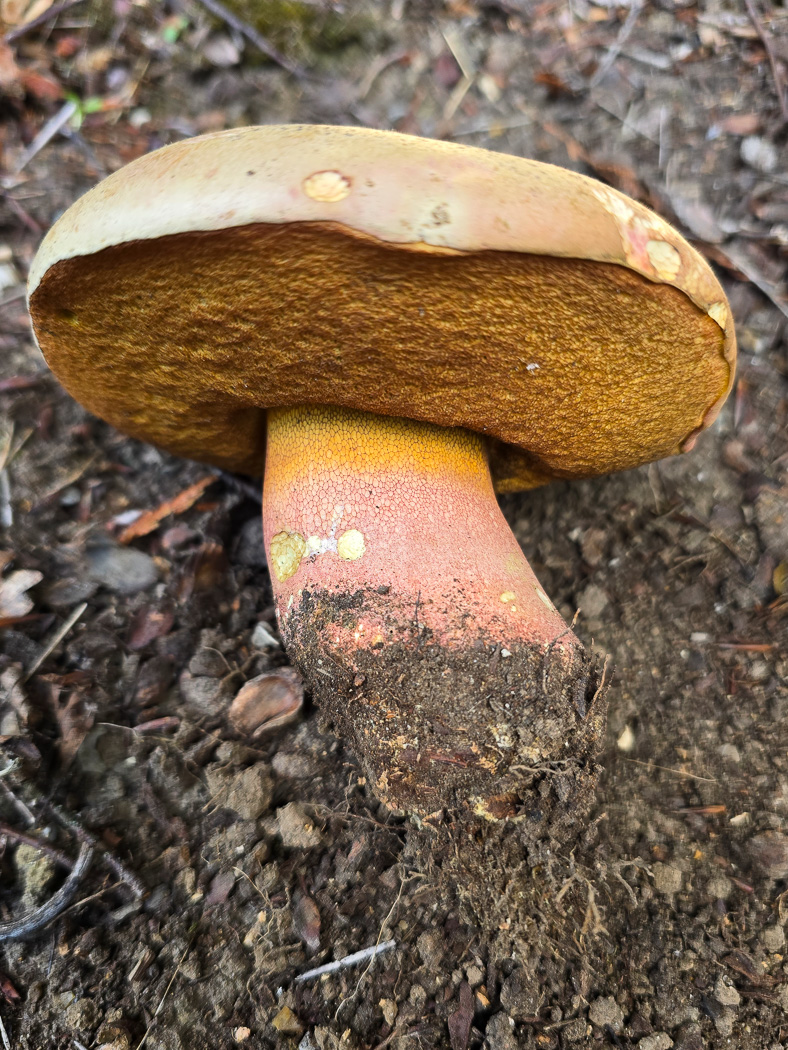 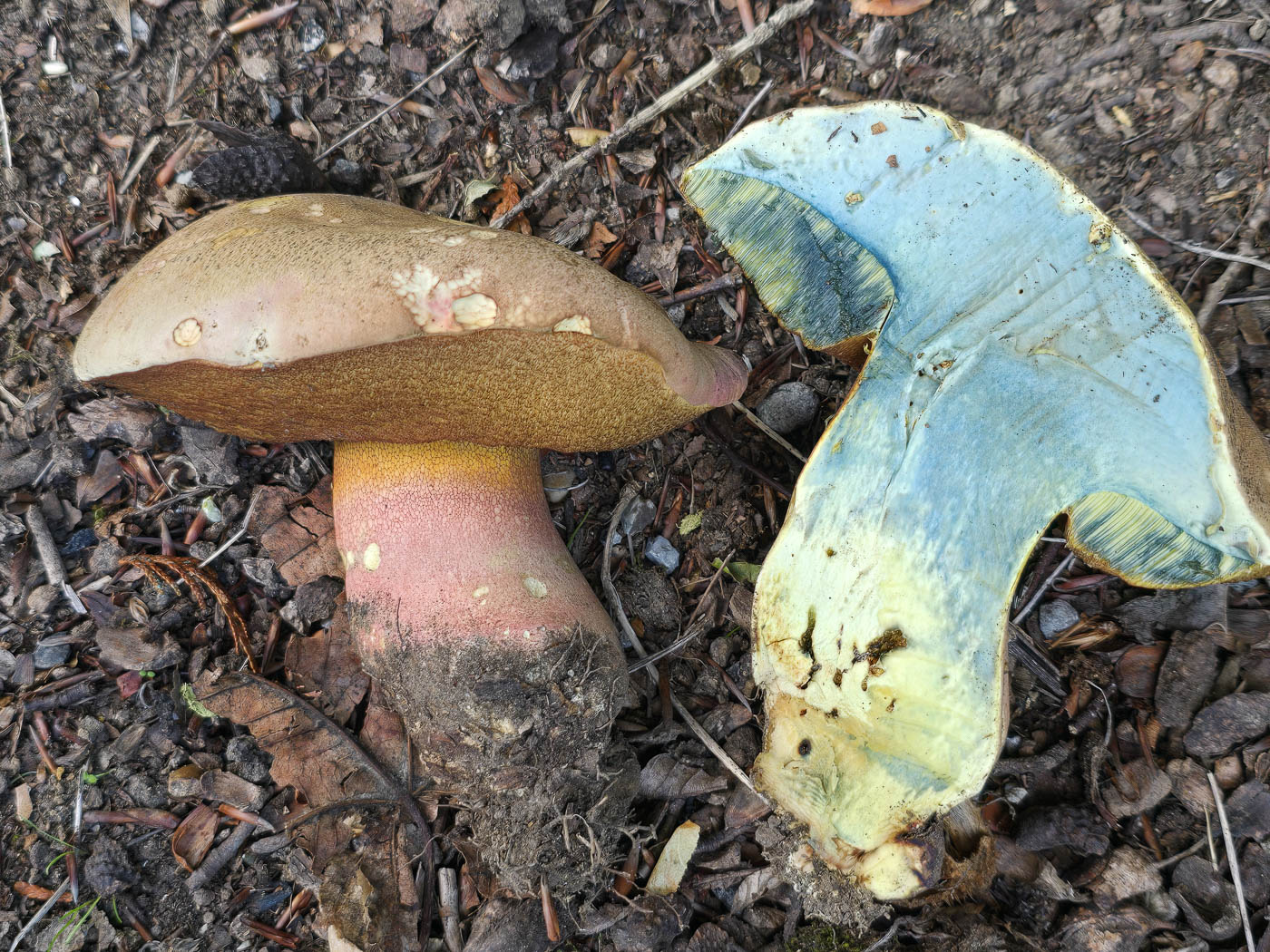
|
Sep 22, 2025. In a roadside verge Chalfont St. Peter Jesper Launder found this rare and unusual bolete, one he'd not seen before. Growing usually under Oak, it at first glance has the pale ivory white cap similar to R. satanas, also the deep red pores bruising blue, stem with a network and chunky general appearance of that species, though later it develops pink cap tones. The main diagnostic feature in the field is its pleasant smell of chickory and not of garlic becoming repulsive as in R. satanas. We have just one previous Bucks records back in 2005 so this was a significant find. |
 |
Oct 10, 2023. On a bank under Beech near Pullingshill Wood Noel Murray found these beauties - a rare Bolete for which we have only one previous county record in 2009. (What an unfortunate common name!). Somewhat similar to and easily mistaken for R. satanas (Satan's Bolete), today's species develops a pinkish tinge to the cap, has a longer much less pronounced clavate stem and a pleasant smell - all characters in contrast to R. satanas. Realising this was not that species but unable to identify it satisfactorily, his lovely photo went first to Penny, then on to Geoffrey Kibby who made the identification. This is obviously a first for Finds. |
  |
Sep 13, 2020. A rare species of bolete (previously in Boletus), this was found by Richard Fortey under Beech / Oak in Pullingshill Wood, then shown to Penny Cullington for whom it was a new species - new to Bucks. As the Latin name suggests, this is another bolete having unusually coloured pores and is very similar to (possibly sometimes mistaken for) the even rarer Rubroboletus satanas (Devil's Bolete). The pale ivory cap tends to develop pink tones (these became apparent after collection) - not present in R. satanas, the gills have orange tones rather than red and the stem is less clavate in shape - prominently clavate in R. satanas. |
| Rubroboletus satanas (Devil's Bolete) |
 |
Sep 10, 2022. In Marlow Common Andrew Padmore came across this somewhat uncommon but beautiful and distinctive species - one of the first Boletes to appear in late summer. The combination of its large size with very stocky stem, ivory white cap and intensely red pores and stem make it instantly recognisable. It apparently develops a repulsive smell of rotting garlic at is ages and is also very poisonous. We have only three previous county sites, one being Wotton Park Estate - the main reason why we arrange to visit that site in late Aug / early Sept. Sadly the drought conditions this year caused us to cancel, however. Today's entry is the first for Members' Finds.
|
| Rugosomyces (previously Calocybe) persicolor (a rare Domecap with no English name) |
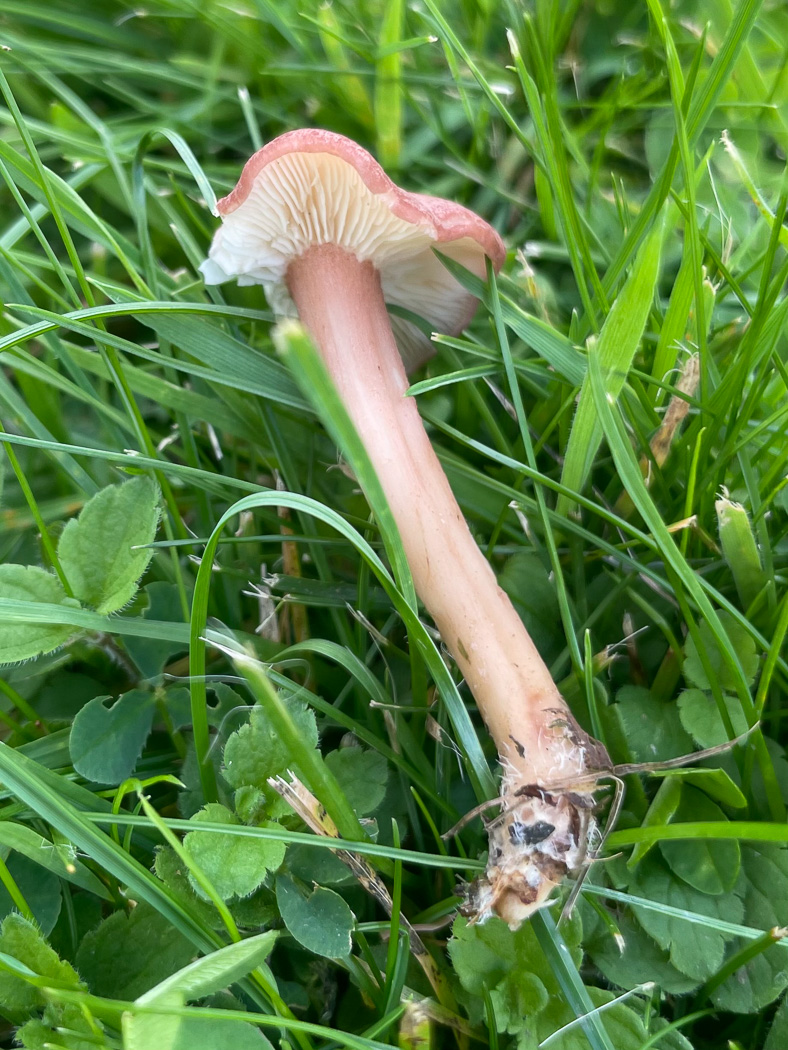 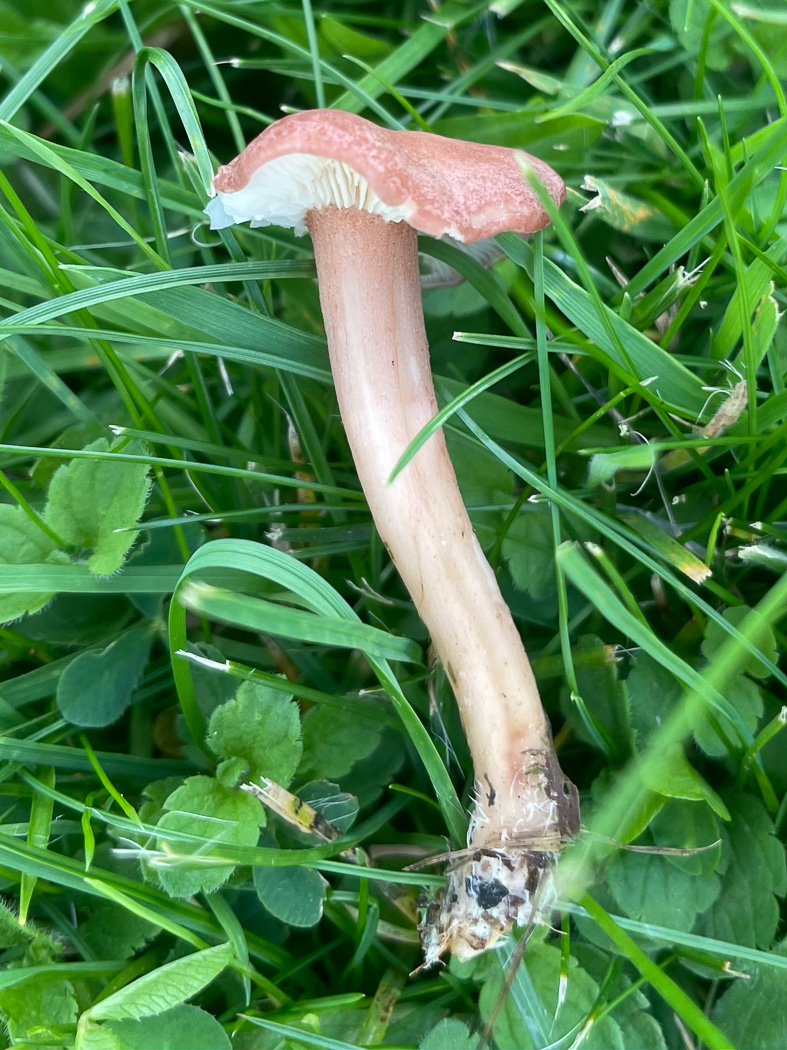 |
Sep 28, 2024.  In Bradenham Churchyard Sarah Ebdon spotted this little pink beauty in the shortish grass, and checking it at home came to the conclusion that it must be this particular species on account of its decidedly strigose (hairy) stem base which according to Kibby vol 2 separates it from the common grassland species Calocybe carnea (Pink Domecap, now also moved and named Rugosomyces carneus). What Sarah didn't realise (as there's no mention in the text) is that this is a rare species with extremely few UK records as yet! So the material will be sequenced to confirm or otherwise as if proven it is clearly new to the county. In Bradenham Churchyard Sarah Ebdon spotted this little pink beauty in the shortish grass, and checking it at home came to the conclusion that it must be this particular species on account of its decidedly strigose (hairy) stem base which according to Kibby vol 2 separates it from the common grassland species Calocybe carnea (Pink Domecap, now also moved and named Rugosomyces carneus). What Sarah didn't realise (as there's no mention in the text) is that this is a rare species with extremely few UK records as yet! So the material will be sequenced to confirm or otherwise as if proven it is clearly new to the county.
|
| Russula aeruginea (Green Brittlegill) |
 |
Sep 15, 2020. Penny Cullington found this collection under Birch at Burnham Beeches. There are several green-capped Brittlegills which are quite common in deciduous woodland. Characters to look out for in this species are the rusty spots which can usually be found on the cap (here seen on the immature specimen) and the cream rather crumbly gills. The somewhat similar R. heterophylla (Greasy Green Brittlegill) has much more flexible gills, but the safest way to split them in the field is by rubbing a Ferrous Sulphate crystal on the stem which turns it weakly rusty in R. aeruginea (seen on the upturned specimen) but instantly strongly salmon pink in R. heterophylla.
|
| Russula amoenoides (a Brittlegill with no English name) |
| Russula amoenolens (Camembert Brittlegill) |
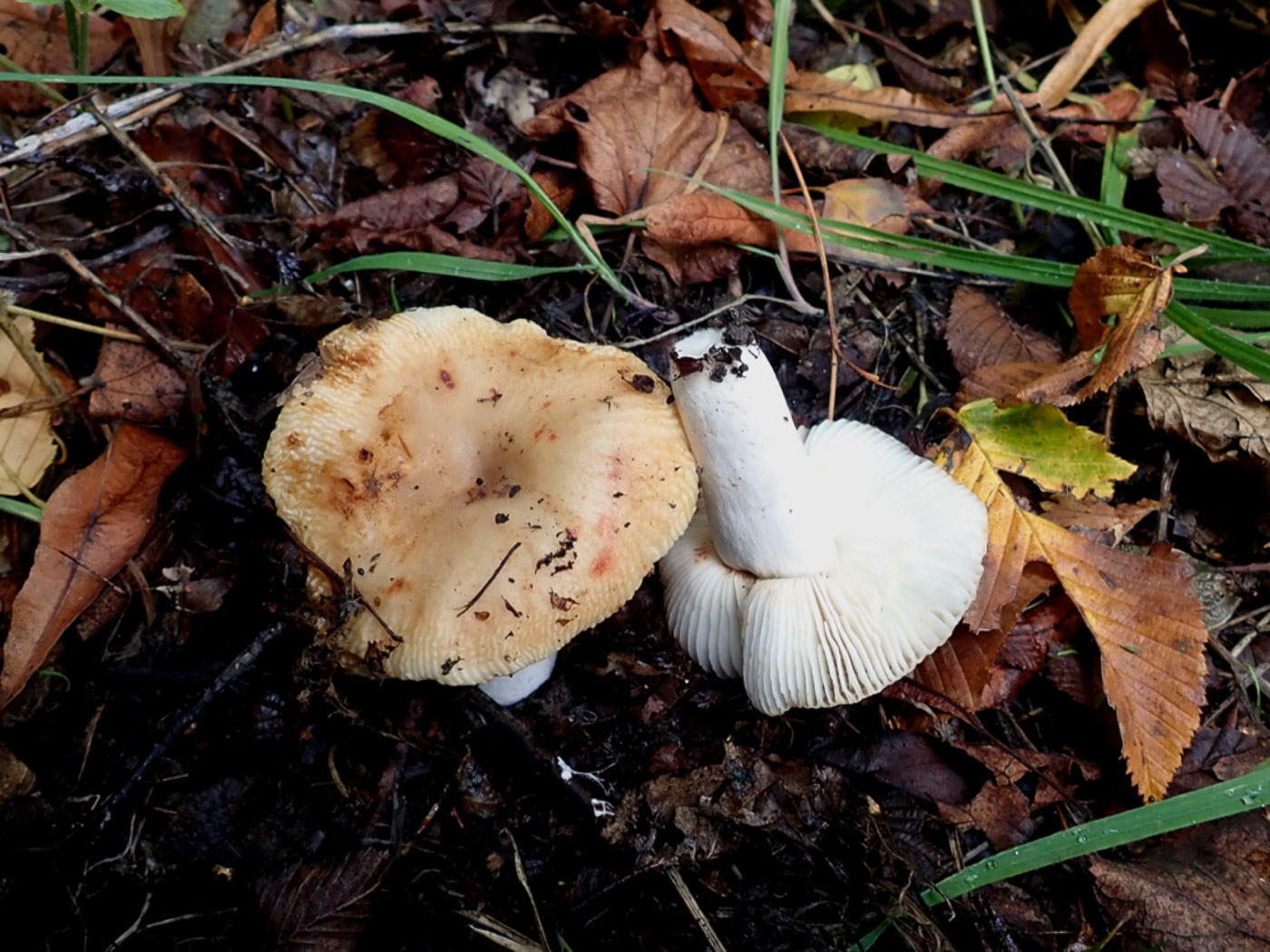
|
Sep 14, 2025. At Turville Heath under Birch Penny found this pair and noting the cap colour and clear 'fluting' around the margin she had a sniff to confirm the ID - definitely cheesy! At home she tested with a drop of the stain Guaiac which went instantly deep blue-green on the stem, this separating this commoner species from the more unusual lookalike R. sororia which fails to change colour even after a minute or so. Both are members of Section Ingratula affectionately known as 'the Smellies'. |
  |
Jul 18, 2023. In Gerrards Cross Common under Oak Jesper Launder noticed this red-capped Brittlegill and at first glance thought it was the very common R. atropurpurea (Purple Brittlegill). However, on closer inspection and noticing the somewhat velvety cap surface (more shiny in R. atropurpurea) he suspected it was something different, maybe from the xerampelina complex (see the entry below for more on this), and at home tried the FE crystal test on the stem which turned quickly dark dirty green confirming this. The species favours Oak and is uncommon with similar cap colours to R. atropurpurea - even to having patches of cream mixed in with the purplish deep red - and can have red at the stem base also. This is a first for Finds and only the fourth county record.
|
   |
Jul 21, 2023. In Marlow Common Penny spotted these well camouflaged brown caps pushing through the thick leaf litter under Oak (can you spot 6 caps in photo 1?). At home she tested the stem with Guaiac to confirm her ID (photo 2): instantly bright blue in this common species but with little or no colour change in the extremely similar and much rarer R. sororia (Sepia Brittlegill - see below on July 17th for Jesper's photo of that species). The two species are closely related, belonging to the so-called 'smellies' and with complex unpleasant smells - today's species with a cheesy component and R. sororia with a more rancid but fruity component. Photo 3 shows the rare entirely white form of this species, found by Jesper Launder in Gerrards Cross Common a few days later. |
  |
Sep 24, 2022. Under a large Oak at Cadmore Ends Penny found several different species including this rather dull grey coloured Brittlegill which (as its common name suggests) has an unpleasant cheesy smell. There are several very similar Brittlegills which favour Oak and often they are hard to separate. However, a drop of Guaiac on the stem makes this task much easier. Photo 2 shows the strong dark blue reaction - pretty well instant - to Guaiac seen in today's species whereas the lookalike R. sororia (Sepia Brittlegill) reacts hardly at all. |
  |
Jul 16, 2021. At Stoke Poges Memorial Gardens in grass under Oak Penny found this Brittlegill, a member of a group of this genus affectionately known as 'The Smellies'! They mostly are mycorrhizal with Oak, have brown cap colours and - needless to say - unusual or unpleasant smells. This particular species is very similar to R. sororia (Sepia Brittlegill) and in fact incorrectly named as this for many years until it became known that the two could be split with the use of Guaiac on the stem: no reaction in R. sororia but instantly strongly blue in R. amoeolens as seen in photo 2. We now know that today's species is by far the commoner of the two. They share the strongly striate cap margin, dull grey brown colours, association with Oak and an unpleasant sour to cheesy smell. |
| Russula atropurpurea (Purple Brittlegill) |
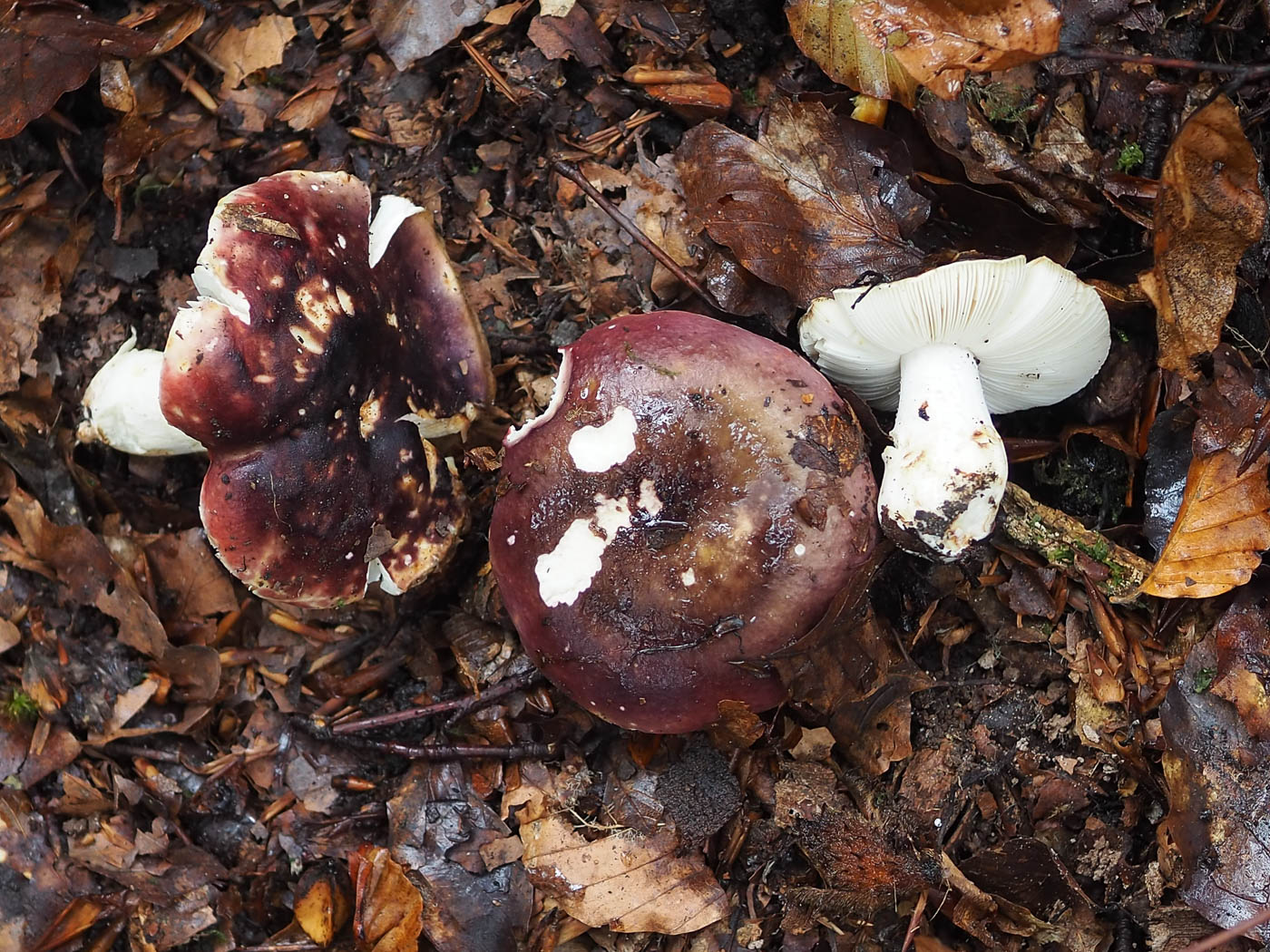
|
Sep 28, 2025. In Downley Common John Catterson found this common species now starting to appear. It frequents deciduous woodland associating with various tree species, most often Beech and Oak, and though not truly purple (as a few other much rarer Brittlegills are!) it is a purplish red compared to other common red species and often has cream patches as seen here. Pale cream gills and a white stem complete the picture. |
   |
Aug 25, 2021. In Downley Common Wood John Catterson found this singleton of one of our commonest Brittlegills under mixed deciduous trees. About 6 cm across, it is one of our darker red Brittlegills (having in fact only a hint of purple despite its name) but always darkens to nearly black in the centre. It often has yellow blotches (seen in photo 2) - these sometimes predominating and making identification confusing, and the gills are almost white as is the firm stem. Clearly a favourite with squirrels and mice, it is unusual to find an cap without nibble damage!
|
| Russula aurea (Gilded Brittlegill) |
  |
Sep 13, 2020. This rare and stunning Brittlegill, new to Bucks, was found under Beech at Pullingshill Wood by Penny Cullington (for whom it was new). Unmistakeable in the field, the intensely bright cap colour together with gill edges flushed golden yellow (a unique feature in the genus) alert one straight away that this is something unusual. The stem tends to flush yellow also. Sadly there was only one specimen.
|
| Russula betularum (Birch Brittlegill) |
 |
Jan 1, 2022. At Turville Heath in grassy litter under Birch Penny was somewhat surprised to find this species fruiting so late in the season - in fact this was her first January Brittlegill that she can remember! |
 |
Sep 30, 2020. Another common Brittlegill conspicuous by its absence so far this season, it was found under Birch, its host tree, at Turville Heath by Penny Cullington. All parts of the fruit body are very fragile thus making it difficult to collect without damage, so a pink capped Brittlegill under Birch which is fragile is one of the easiest to name in the field. Further confirmation is that the cap skin peels off almost completely. the cap colour can sometimes be almost white with only a hint of pink. |
  |
Nov 13, 2021. At Turville Heath under Birch Penny found several of this species dotted about and then placed them together to illustrate its delicate pink cap, sometimes really pale cream with only a hint of pink, and pure white gills - the whole fruitbody always very fragile and one only found under Birch. To separate it from other pink Brittlegills you can peel the cuticule right to the cap centre (and sometimes remove it completely!) |
| Russula caerulea (Humpback Brittlegill) |
  |
Sep 1, 2021. Under Pine in Burnham Beeches Penny found just this one specimen today. Only occurring under Pine it is not that common but quite an easy one to recognise having a purplish red cap, darker in the middle where distinctly umbonate (sunken but with a clear bump in the middle). The gills are pale at first but become primrose yellow as it matures - photo 2 shows this just developing. Also note the pink spot on the stem here where a drop of Sulphovanillin has been added (at home afterwards). This is one of a few species with this reaction to the chemical but the only one having a purplish red cap and found under Pine. |
  |
Nov 3, 2020. This species was the third of Penny C.'s Brittlegills host specific with Pine in Burnham Beeches today. Yes, it's another with a red cap! However, this is a dark vinaceous purple red and the cap is smooth and shiny and has a distinct umbo - a unique feature in the genus. The gills are deceptively pale to start with but in maturity are almost orange, producing a dark sporeprint, and the stem is plain white. The larger specimen was damaged today but in photo 2 the small fruit body in front shows the typical 'hump' in the middle which remains as the cap expands. We have only two previous county records of this species, so not at all common in this area because like most Pine loving Brittlegills it prefers acid soil. |
| Russula carpini (a rare Brittlegill with no English name) |
  |
Aug 4, 2023. Under Hornbeam in Hodgemoor Woods Penny found this singleton dull dingy green Brittlegill which she didn't recognise as one of the commoner green capped species; the FE crystal reaction was strong salmon and she put it in her basket and thought no more about it. It was not until two days later when she was about to discard any unsolved mushrooms from that visit now past their best that she saw the distinctly dark orange gills and twigged what it must be. Recalling that it had been found in the Hornbeam avenue, this had to be R. carpini - a Brittlegill with very varied cap colour ranging from green (as here) to purple or brown, even pinkish and often a mix of these colours. The two constant features: its association with Hornbeam and its really dark orange sporeprint (one of the darkest in the genus) thought the gills are known to darken only late on in its development - hence their cream colour here. We have just one previous record and this is new to Finds.
|
Russula (previously Hydnangeum) cereum (a very rare truffle with no English name)  |
 |
Jun 19, 2024. No, this entry is not misnamed! This very rare basidiomycete truffle was previously in genus Hydnangeum but has been transferred to the mushroom genus Russula owing to its DNA showing a direct microscopic link with that genus. It was found by Jesper Launder under an Oak in Jordan's Village which he's named his 'truffle tree' from past experience and where he found this species new to the county two years ago almost to the day. He reports that no truffle hound was needed to locate this one which was fully mature and detected today by the distinct and powerful 'aroma of heavenly fermented apple' - his words! |
 |
Jun 24, 2022. In Jordans village Jesper Launder knows of an Oak which regularly produces Summer Truffles (see entry below) but on his visit today he also found this real rarity, located in bare soil amongst the grass by the strong fruity aroma he detected. The hypogeous (underground) genus Hydnangeum, which included this species, has now been transferred - rather surprisingly - to Russula, the evidence for this being DNA based backed up by its spores which are identical to those found in Russula: not only typically covered in warts or spines but also strongly amyloid (turning black in the reagent Melzers - Iodine based). When Jesper sent her his photos, Carol Hobart (hypogeous fungi expert) said she has yet to find this species in Britain, and there are very few UK records. This was an exciting find and the identification has now been confirmed with sequencing. |
Russula chloroides (Blue Band Brittlegill)  |
  |
Jul 26, 2023. Under a mix of Oak and Birch in Bernwood Forest Jesper Launder found these - a really stocky and chunky firm Brittlegill species and often difficult to split from the almost identical R. delica. Both are occasional species, usually under Oak, and if you're really lucky R. chloroides displays a distinctive blue green band just under the gills (never present in R. delica) but more often than not it's missing (as here)! However, Jesper spotted (and captured) the faintest hint of blue on the gill edge (photo 2), enough to point to R. chloroides here, then confirmed his ID with the spores under a scope which are differently ornamented. |
  |
Sep 27, 2022. Under the limes at Turville Heath Penny found at least 7 or 8 specimens is this occasional species dotted about, the caps mostly covered with bits of soil and grass remnants. A chunky solid species having a very short stem and crowded gills, it is often pure white both above and below - though here the caps were mostly pale beige - and if you're lucky you find one displaying the blue-green band at the stem apex which separates it from the very similar R. delica (Milk White Brittlegill). Photo 2 is of an example Penny eventually found showing a faint greenish band though sadly her camera refused to detect it very convincingly! |
  |
Sep 21, 2020. Sarah Ebdon found this Brittlegill in Bradenham Wood under mixed deciduous trees. This is one of very few white capped Brittlegills which do not blacken when damaged. It's a large species and extremely similar to a few large white Milkcap species, the sunken centre and sloping gills being a feature they have in common. Damaging the gills and watching for milk is key to determining the genus, but if you notice this beautiful and unique turqoise blue band at the top of the stem (see second photo) then you know you have this particular Brittlegill. It is occasional and usually found under Oak. |
| Russula cicatricata (Ochrecrab Brittlegill) |
   |
Jul 18, 2023. In Gerrards Cross Common under Oak Jesper Launder noticed this distinctly coloured Brittlegill and, suspecting what it was, took it home to apply a crystal of ferrous sulphate to the stem whereupon it quickly stained dark dirty green rather than giving the normal pink salmon reaction. The species is one of the xerampelina species complex within this genus and, like the more common R. graveolens, occurs under Oak - the true R. xerampelina ss. occurs under Pine but is rare in the S. England. These (seven) species share in common two distinct field characters: the distinctive smell of cooked crab (which becomes very obvious once collected and as it dries out) and the striking dark green reaction to an FE crystal. In our area R. graveolens is the commonest and R. cicatricata is occasional - distinguished by its browner more olive colours and the tendency to develop concentric wrinkles (seen in photo 2) near the cap margin. The stem in photo 3 shows the blue green reaction to Guaiac above and the dark green reaction to an FE crystal below. See also the entry above for a third much rarer member of this complex. To compare, see the Masterlist for examples of both R. graveolens and R. cicatricata. (Footnote: it is likely that this species will be amalgamated into R. graveolens despite its clear differences in appearance because the DNA does not warrant its separation at species level.) |
  |
Sep 24, 2022. Under the Oaks at Cadmore Ends was this singleton Brittegill found by Penny, who recognising it knew to rub her crystal of Ferrous Sulphate on the stem! This is one of the 'xerampelina' group of Brittlegills which not only develop a strong smell of crabmeat but also turn dark green on the stem when rubbed with this crystal - most species turn dirty orange rust. Another of this group and much more common is R. graveolens (also no English name) which has pinker cap colours - see Finds 2021 August 17 - but today's species is a first for Finds. |
| Russula claroflava (Yellow Swamp Brittlegill) |
 |
Jun 9, 2021. In the Mire at Burnham Beeches Penny was somewhat surprised to find this autumn species just emerging in Sphagnum under Birch this early in the year. It can be distinguished from the several other Brittlegills which have bright yellow caps by its cream coloured gills when mature (not white nor orange), its occurrence only under Birch usually (but not exclusively) in damp areas and having a stem which blackens where damaged though this takes an hour or so to develop after handling / scratching. See Finds 2020 dated Sept 15th for photos (also from this site) of a mature collection and of the blackening stem. |
  |
Sep 15, 2020. Penny Cullington found this collection under Birch (with which the species is host specific) at Burnham Beeches. There are several yellow capped Brittlegills but this species is by far the brightest yellow and should not be confused with others, particularly with R. ochroleuca (Ochre Brittlegill) which is our commonest yellow species. If you think you've found R. claroflava, scratch the stem and within an hour or two the scratch will turn first pinkish and then grey-black - this is the only yellow species to show this colour change (see second photo). |
| Russula cuprea (Gnarled Brittlegill) |
 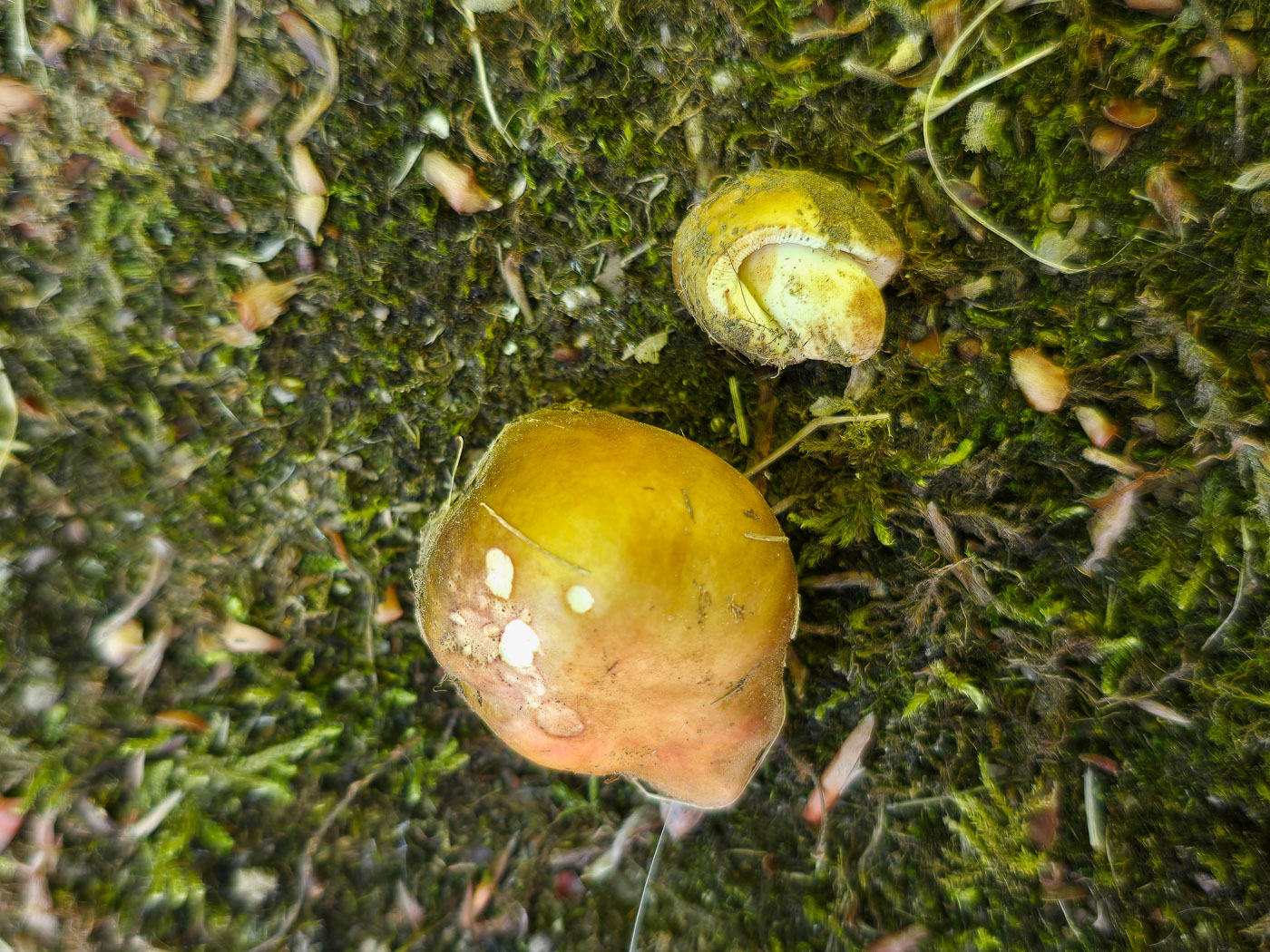
|
Jun 15, 2025.  In Little Chalfont whilst searching for truffles in a spot there which has proved very fruitful, Jesper Launder was surprised to find this unusual-looking Russula in moss under Beech and Oak. It is early in the season for this genus though not exceptionally so though somewhat unexpected considering the dearth of gilled fungi recently. However, the species is rare, also a tricky one to identify because the cap colour is renowned for its remarkable variability - a feature which adds to the challenge of this genus. The species epithet means copper-coloured, but caps can be anything between brown, vinaceous red to cinnamon or even green! A useful pointer is the extremely dark spore print colour - one of the deepest orange in the genus, but microscopic examination is essential for reliable ID. It was a new species for Jesper and Penny has found R. cuprea only once in the county but not confirmed with sequencing, so it would be useful to get this collection tested. In Little Chalfont whilst searching for truffles in a spot there which has proved very fruitful, Jesper Launder was surprised to find this unusual-looking Russula in moss under Beech and Oak. It is early in the season for this genus though not exceptionally so though somewhat unexpected considering the dearth of gilled fungi recently. However, the species is rare, also a tricky one to identify because the cap colour is renowned for its remarkable variability - a feature which adds to the challenge of this genus. The species epithet means copper-coloured, but caps can be anything between brown, vinaceous red to cinnamon or even green! A useful pointer is the extremely dark spore print colour - one of the deepest orange in the genus, but microscopic examination is essential for reliable ID. It was a new species for Jesper and Penny has found R. cuprea only once in the county but not confirmed with sequencing, so it would be useful to get this collection tested.
|
| Russula cyanoxantha (Charcoal Burner) |
  |
Nov 3, 2023. In a grassy patch under Oak at Cadmore End Penny found some huge Brittlegills with caps 12 cm across or more. The stem when rubbed with a crystal of Iron salts produced little reaction at first but eventually turned pale greeny grey, indicating this particular species which is easily confused with several others having similar coloured caps but with a salmon reaction to the crystal. |
 |
Oct 7, 2022. In Marlow Common Penny found a group of these greeny capped Brittlegills and instantly took out her FE crystal to rub on the stem. Most of this large genus quickly turn dirty rust where rubbed with this useful ID tool, but today's species eventually turns very slightly greenish grey, if anything. The patch on the stem where it was rubbed is hardly visible here. This is one of our commonest Brittlegills. |
 |
Jul 28, 2021. In a roadside verge in Chalfont St. Peter Jesper Launder spotted this nice specimen of one of our commonest Brittlegills. The species is happy under any deciduous trees though is easy to confuse with several others having caps with a mix of green, blue, violet and pink shades. It is unclear where its traditional common name originated but one way to separate it from others is with a ferrous sulphate crystal: the stem when rubbed has a slow almost negative reaction, turning not rusty salmon as in many species but if anything very pale greenish grey. |
| Russula decipiens (a rare Brittlegill with no English name) |
 |
Jul 25, 2023.  In Jordan Village under Oak Jesper Launder found a good number of this Brittlegill - one for which we have just two sites and only four previous records. The cap colour is similar to several other species (Penny describes it as peaches / strawberries and cream!) but it differs in having distinctly darker gills and therefore a deep orange sporeprint which in one stroke eliminates the commoner species (like R. vesca, for instance) with caps this colour. Microscopic characters are distinctive as well. It occurs under Oak, Beech and Sweet Chestnut. This is anew entry for Finds. In Jordan Village under Oak Jesper Launder found a good number of this Brittlegill - one for which we have just two sites and only four previous records. The cap colour is similar to several other species (Penny describes it as peaches / strawberries and cream!) but it differs in having distinctly darker gills and therefore a deep orange sporeprint which in one stroke eliminates the commoner species (like R. vesca, for instance) with caps this colour. Microscopic characters are distinctive as well. It occurs under Oak, Beech and Sweet Chestnut. This is anew entry for Finds.
|
| Russula delica (Milk White Brittlegill) |
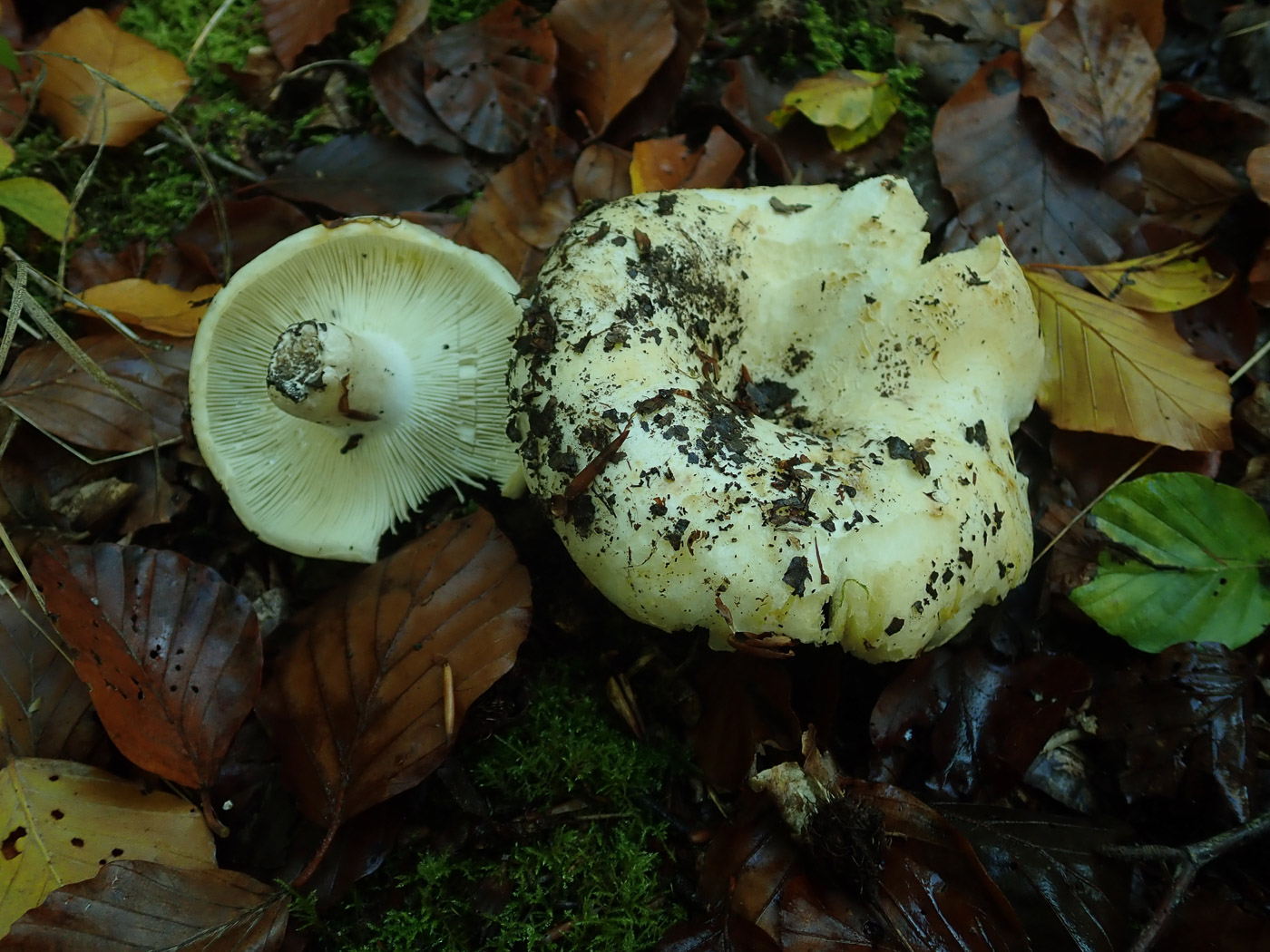
|
Oct 24, 2025. Under the Beeches in Gussetts Wood Penny and Paul found these two firm chunky fruit bodies and at first glance thought they were Milkcaps, but on slicing the gills and realising that no milk was forthcoming the light dawned that they must be members of Russula Section Compactae. R. delica and R. chloroides are in fact close lookalikes of several solid white capped Milkcaps, the commonest of which is Lactifluus piperatus (Peppery Milkcap). They share not only their white colour and chunky form but also the short stubby stem, decurrent gills and sunken cap centre, often filled with debris especially after rain as here. There is nothing delicate about them! Today's specimens lacked the blue green ring around the stem apex, thus eliminating R. chloroides. However, these two are known to be part of a species complex not yet fully sorted out. |
  |
Oct 30, 2021. In Prestwood Churchyard Penny noticed this large white lump amongst the litter under Pine and Oak (with which the species is mycorrhizal), suspected it was this species and carefully extracted it to confirm the equally white crowded gills and to see if there was a blue green ring around the stem apex - indicating a different species, R. chloroides. One further check: she sliced into the gills just to make sure there was no 'milk' because (surprisingly) there are several extremely similar species of Milkcap - though now moved to the closely related genus Lactifluus. (The genera Russula and Lactarius are in fact very close, both having spiny amyloid spores.) R. delica is anything but delicate in stature, being squat, solid and firm like R. nigricans (Blackening Brittlegill) and probably best described as occasional.
|
| Russula densifolia (Crowded Brittlegill) |
   |
Aug 4, 2023. In Hodgemoor Woods under Oak Penny spotted a couple of these, thinking they were further specimens of the much more common R. nigricans (see the entry below). On turning one over, however, she realised that the gills were crowded thus eliminating that species despite the fact that from above the caps appeared identical. She broke one in half and then kept an eye on it to ascertain whether it blackened directly or reddened first. R. albonigra - another lookalike belonging to the Compactae group of Brittlegills - turns black with no reddening, whereas R. densifolia turns red first as in R. nigricans (see the entry below for comparison). Photo 2 taken after 30 minutes gave the answer and photo 3 taken later at home shows it blackening. |
   |
Oct 5, 2020.  Penny Cullington found good quantities of this fairly common Brittlegill under Beech in Common Wood. There were many large fruit bodies of R. nigricans (see photo dated Sept 18) - virtually identical to our species when viewed from above - in evidence here that it was all too easy to assume that they were all the same. Not so! Turn one over and the contrast between the gills of R. nigricans and R. densifolia is immediately obvious (see photo 3 with R. nigricans on the left and R. densifolia on the right). There are in fact other quite common look-alike species with the same crowded gills as today's; The only safe way to determine which you have is with a scope. Penny Cullington found good quantities of this fairly common Brittlegill under Beech in Common Wood. There were many large fruit bodies of R. nigricans (see photo dated Sept 18) - virtually identical to our species when viewed from above - in evidence here that it was all too easy to assume that they were all the same. Not so! Turn one over and the contrast between the gills of R. nigricans and R. densifolia is immediately obvious (see photo 3 with R. nigricans on the left and R. densifolia on the right). There are in fact other quite common look-alike species with the same crowded gills as today's; The only safe way to determine which you have is with a scope. |
| Russula emetica (Sickener) |
 |
Oct 27, 2021. Also under the Pines at Stoke Common Penny found this bright red Brittlegill - one which is found only under Pine though preferring acid soil it is not common elsewhere in the county but a regular here. It is very similar to the common Russula nobilis (Beechwood Sickener) but with a brighter red cap which tends to be more domed than that species, also often has a taller stem in relation to cap size. |
 |
Nov 3, 2020. This species was another of Penny C.'s finds under Pine at Burnham Beeches. Yet another Brittlegill with a bright red cap, this one is very like the common R. nobilis (Beechwood Sickener) but only occurs under Pine and is far less common in the south of the country. If both Beech and Pine are present one cannot be sure which of the two species one has but there was no Beech anywhere near this area today. Furthermore, adding a drop of the reagent Guaiac to the stem turns instantly bright blue green in R. nobilis but has a negative effect in R. emetica, so this further confirmed today's identification. |
| Russula exalbicans (Bleached Brittlegill) |
 |
Aug 1, 2023. In a car park in Gerrards Cross Jesper Launder spotted this collection under Birch - a species he's not seen in recent years and not common in our area. This is a medium sized Brittlegill, one of many with pink colours but it tends to fade rapidly - often occurring in exposed spots - and can end up entirely greeny cream or whitish though often retaining a pink margin. It favours calcareous or sandy soils, almost always under Birch. |
 |
Nov 13, 2021. In the Pastures, High Wycombe, John Catterson found this nice cluster of Brittlegills under Birch in grassy soil, then took them home and successfully identified them. Though described as quite a common species occurring under Birch, it does not turn up that often in the Chilterns and is typified by having a smooth pink cap which regularly fades to pale cream but often retains some pink around the rim. This is seen in one of the collection though mostly they've faded almost completely. Compared to R. betularum (Birch Brittlegill) - another pink species found under Birch, today's species is larger and much more substantial, its cap peeling to only half way. See R. betularum dated Nov 13th for further differences. |
 |
Jul 25, 2021. In a roadside verge in Jordans village Jesper Launder spotted several species of Russula growing under a mix of Oak, Beech and Birch. This particular species associates with Birch and not that common in our area though we have a handful of sites where it's been recorded. The cap tends to fade, sometimes becoming a bit greenish to almost colourless except for a rim of pink around the margin, hence its common name. |
| Russula faginea (a Brittlegill with no English name) |

|
Oct 7, 2025. In Gussetts Wood Penny was pleased to find more than one of this rare Beech associate which is one of the Xerampelini group which develop a smell of cooked crab and if the stem is rubbed with an FE crystal it turns first salmon but gradually (after a few seconds) green from the outside in as seen here. We now have several Chiltern beechwoods where this large and chunky species has been recorded but it is always a thrill to find it. |
 |
Oct 21, 2022. In Gussett's Wood under Beech Penny found several fruitbodies of this rare species - one of the Xerampelina group of Brittlegills which have a smell of crab as they mature and also when rubbed with a crystal of Ferrous Sulphate the stem turns dirty green in about 10 seconds (seen on the lower left stem here). This is a chunky rather pale species with a pinkish tinge and only found under mature Beech. |
 |
Sep 27, 2020. This was found by Penny Cullington in Mousells Wood under Beech, its host tree. This is a robust (caps up to 14 cm across) and also rare Brittlegill belonging to the Xerampelina group that is distinguished by smelling distinctly of cooked crab when mature! This group has a unique colour change reaction when the stem is rubbed with a Ferrous Sulphate crystal: instead of the normal rusty orange they turn dark green, eventually black. R. faginea is not often found but regularly turns up at this particular site – a typical Chiltern beech wood. (Note the green FE reaction on the rather damaged LH specimen.) |
| Russula farinipes (Floury Brittlegill) |
 |
Jul 26, 2023. Under a mix of Oak and Birch in Bernwood Forest Jesper Launder found these Brittlegills but was in no doubt as to which of several species having yellow caps they belonged. Probably the least common of our yellow Brittlegills, it is one of only two to have an adnate cuticle (ie the cap skin refuses to peel but is elastic, often sticky) the other being R. violeipes which usually - but not always - has violet on the stem). Both species have a somewhat weak reaction to both Guaic and an FE crystal (seen here on the LH stem) but in today's species the cap is a slightly dirty ochre yellow though in R. violeipes it is a more lemon yellow. There's also a difference in spore colour and ornamentation. |
  |
Jul 25, 2021. Growing under Beech in Jordans village Jesper Launder noticed this unusual Brittlegill. It is probably the least common of the several species having yellow to ochre cap colours and in the field is easily separated from them by having a cuticle which doesn't peel at all. It tends to have a sticky cap and rather widely spaced whitish gills and favours Beech though can be found under other deciduous trees. |
 |
Sep 22, 2020. Penny found this collection growing in grass under Birch and Lime at Turville Heath. Not really rare but with only a few Bucks records, this is possibly overlooked as the very common R. ochroleuca (Ochre Brittlegill) due to its similar cap colour. However, on careful observation the rather asymmetrical shape and quite widely spaced gills should alert one that it's different. The main feature to note, however, is that the cap cuticle refuses to peel at all and has a rubbery feel - unique amongst the yellow capped Brittegills. |
| Russula fellea (Geranium Brittlegill) |
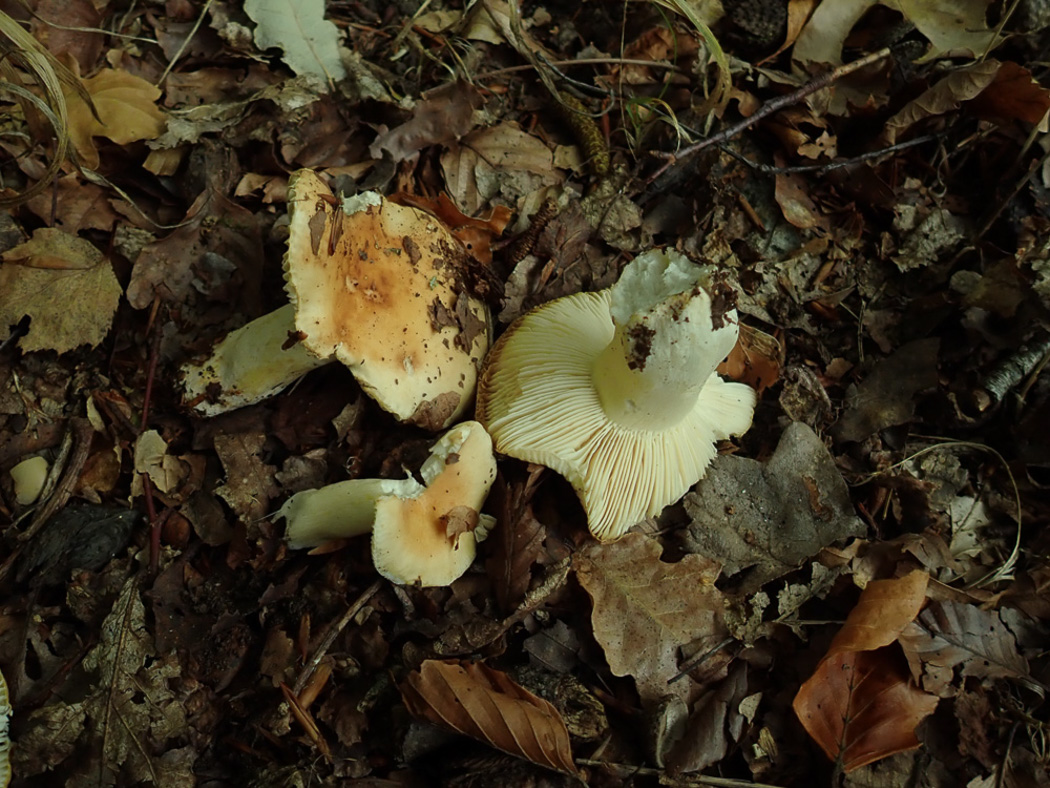
|
Oct 7, 2025. In Gussetts Wood under the many Beeches Penny found a few of this species, a Beech associate which often seems to be confused with the very common and ubiquitous R. ochroleuca (Ochre Brittlegill). So this difficulty arises when both are found together under Beech, as can happen. As both have yellow caps the clue to telling them apart is to look at the gill and stem colour: both gills and stem are white in contrast to the yellow cap in R. ochroleuca, but both are yellowish cream, much the same colour as the cap in R. fellea. Chemical tests also help: rapid blue on the stem with Guaiac in R. ochroleuca but negative in R. fellea, also KOH on the cap and stem base turns rusty red in R. ochroleuca but is negative in R. fellea. If chemicals are unavailable put a fruit body to your nose! Not much smell with R. ochroleuca but distinctly sweet and fruity in R. fellea though more like stewed apple than Pelargonium! |
 |
Nov 3, 2023. In Pullingshill Wood Penny found this group just emerging through thick Beech litter as the light deteriorated before a downpour! Often quite common, this species has not been prolific this season and is one which many get confused with the very common R. ochroleuca (Ochre Brittlegill). Note the orange tint which is repeated in both gills and stem - the commoner species has contrasting white gills and stem with no orange tint in the cap and furthermore lacks much smell. Once R. fellea starts to dry out it develops a distinct fruity sweet smell , to Penny of stewed apples though officially of Geranium leaves! |
 |
Aug 27, 2023. In Park Wood Ibstone Penny found just two small examples of this quite common Beech associating Brittlegill - the first time she's seen it this summer. One of the yellow-capped Brittlegills, it is regularly overlooked as R. ochroleuca but it should be quite easy to differentiate between the two species. Its softer more subtle honey colour is consistent over cap, gills and stem in contrast to the ochre yellow cap of the other species which also has contrasting white gills and stem. Furthermore, to clinch it put R. fellea in an enclosed pot for a few minutes to let its distinctive fruity smell develop: described as of Geranium but to Penny clearly of stewed apple! Compare today's photo with that of R. ochroleuca taken a few days ago (August 21st) |
  |
Sep 30, 2020. This quite common Brittlegill has been conspicuous by its absence so far this season but was found by Penny Cullington under Beech, its host tree, at Turville Heath. We now have for comparison a full house of the yellow capped Brittlegills which have white to pale cream gills: R. ochroleuca (Sept 16), R. claroflava (Sept 15) , R. farinipes (Sept 22) and now R. fellea. The second photo here shows how in R. fellea the paler outer cap colour more or less matches the gills and stem whereas in the others there is a clear contrast between darker cap and paler gills and stem. Our species today also has a very distinctive smell: sweet, of stewed apple or for some Geranium, hence the common name. |
| Russula foetens (Stinking Brittlegill) |
  |
Sep 27, 2022. Under Oak at Turville Heath Penny found just these two fruitbodies pushing up close together through the wet grass. The broken specimen on the left was then extracted to show the underside (photo 2). Though commonly recorded, the species is less common in the south than the (just as unpleasantly smelly) R. subfoetens (Least Stinking Brittlegill). The chunky size, golden brown and slightly striate sticky cap especially in damp weather and unpleasant rancid oily smell are common to both species, making them pretty well inseparable in the field unless you have a bottle of KOH to hand. At home Penny added a drop to the stem flesh which failed to turn golden yellow (an indication of R. subfoetens) and instead turned dirty brown, confirming this as R. foetens - a first for Finds. No doubt our many county records of this species are in fact a mix of the two. See the Masterlist to compare with entries of R. subfoetens.
|
| Russula fragilis (Fragile Brittlegill) |
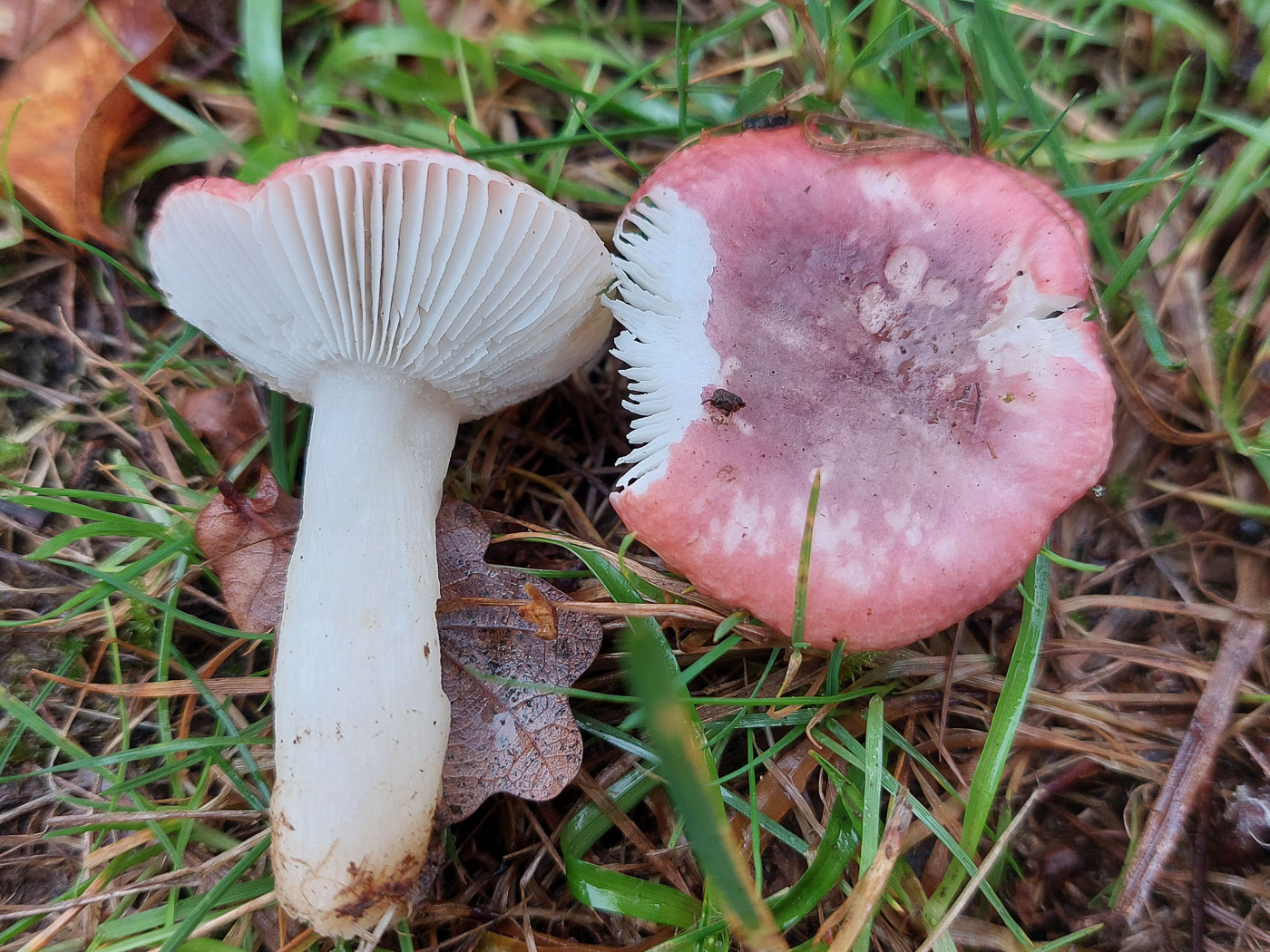
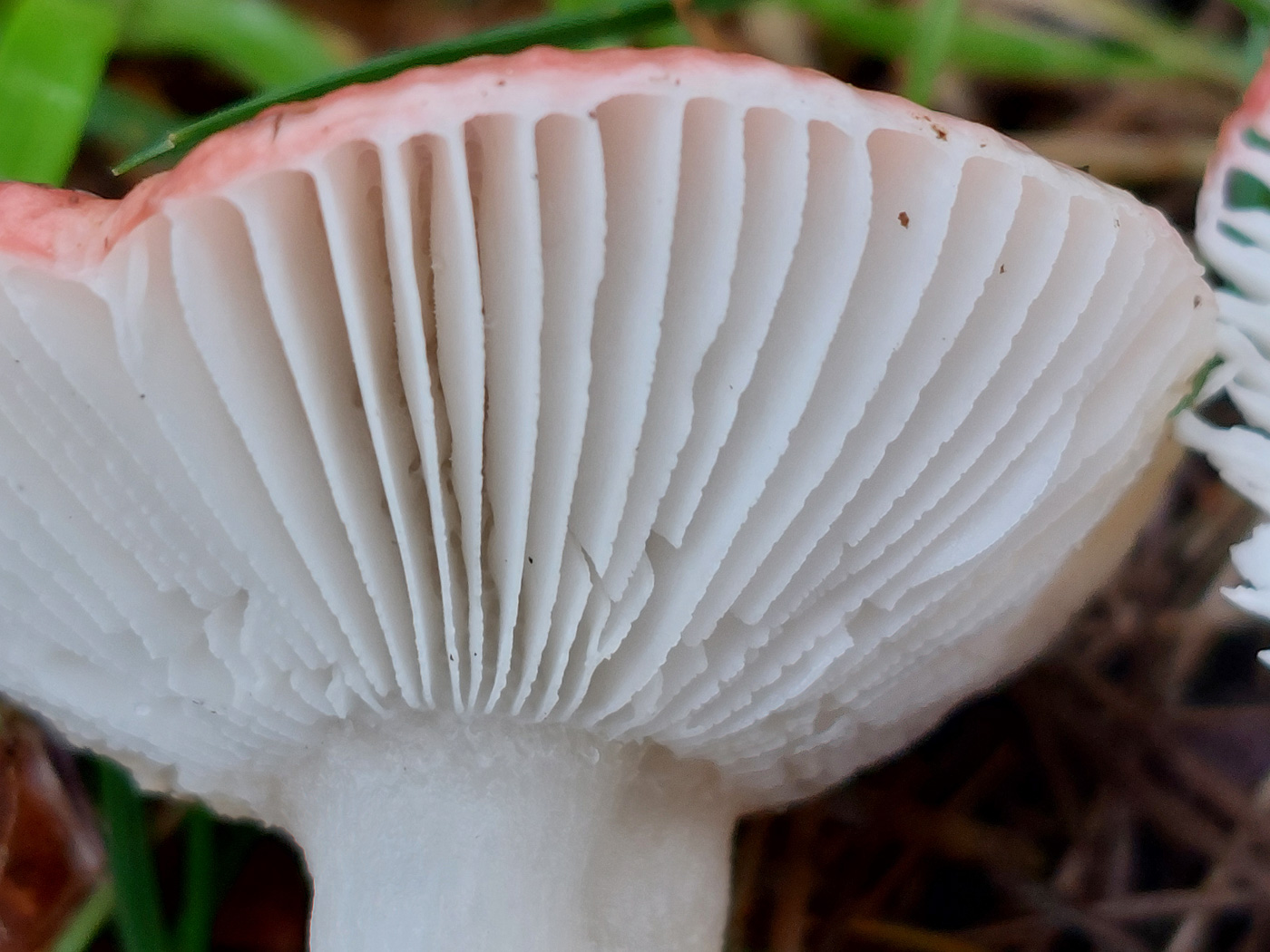
|
Dec 8, 2025. At Stoke Poges Memorial Gardens Jesper Launder was surprised to find this Brittlegill still fruiting under the Oaks (December is somewhat late for this genus to be appearing). However, the species has been one of the commonest Brittlegills this autumn though it is often difficult to name as the cap colour is amazingly variable. Photo 2 shows the key feature clearly here: the jagged gill edge, best seen with a x10 handlens in the field though even then it can be tricky to see and in fact is not always present! |
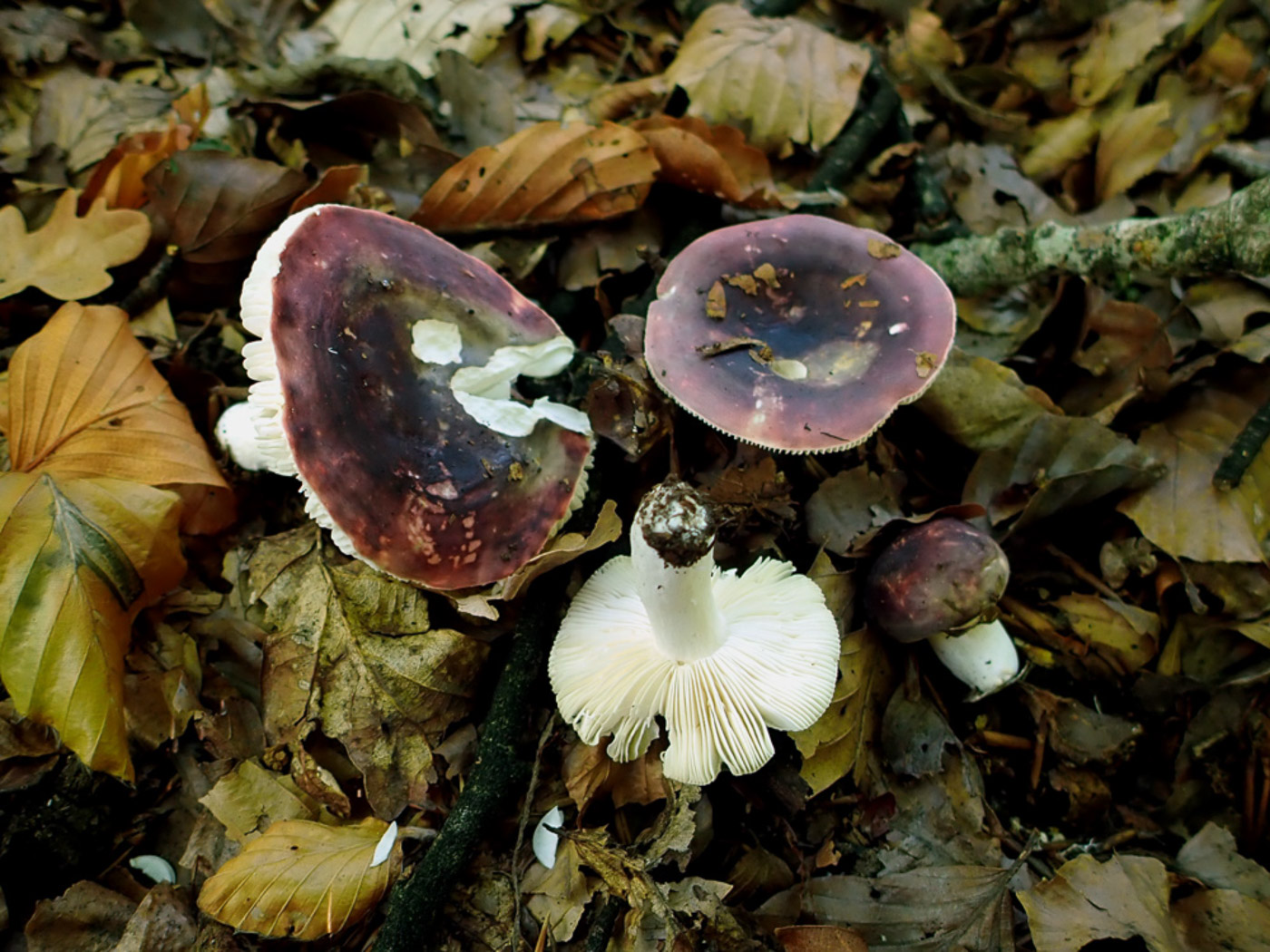
|
Sep 29, 2025.   In Gussett's Wood Penny came across a dark purplish red Brittlegill under Beech and Oak which confused her both in the field and later at home. The general jizz just didn't match up with R. atropurpurea, nor with R. fragilis: it lacked both the telltale serrate gill edge of that species and the cap appeared far too dark, also at home the cap cuticle cells hardly stained at all in sulphovanillin though other features tallied. It seemed worth having a sample sequenced, and this was then checked by Russula expert Felix Hampe who confirmed it was indeed 100% R. fragilis. So this result underlines just how difficult this genus can be to identify when cap colour can be so inconsistent and variable. In Gussett's Wood Penny came across a dark purplish red Brittlegill under Beech and Oak which confused her both in the field and later at home. The general jizz just didn't match up with R. atropurpurea, nor with R. fragilis: it lacked both the telltale serrate gill edge of that species and the cap appeared far too dark, also at home the cap cuticle cells hardly stained at all in sulphovanillin though other features tallied. It seemed worth having a sample sequenced, and this was then checked by Russula expert Felix Hampe who confirmed it was indeed 100% R. fragilis. So this result underlines just how difficult this genus can be to identify when cap colour can be so inconsistent and variable. |
 |
Oct 24, 2023. At Stoke Poges Memorial Gardens Penny found quite a few of this species under Oak with which it often associates. One of the many pink-capped Brittlegills, it has white gills and stem and the cap colour is somewhat variable but often has purplish or green tints - the small cap at the bottom is almost entirely green here. With a hand lens one can see the rather jagged gill edge which is a unique feature of the species though sometimes can be tricky to see. We have several other images found via the Masterlist. |
  |
Nov 11, 2021. Under Oak at Stoke Common Penny came across a few red capped Brittlegills fairly close to a couple of those she'd just identified as R. atropurpurea (Purple Brittlegill). However, there was a hint of green in the cap colour indicating a different species and suspecting this might be R. fragilis she checked to confirm this by looking closely at the gill edge with a x10 lens. When held up to the light and looking across the gills one can see a finely jagged to serrated edge - a unique feature though not always easy to spot but clearly present here. |
  |
Oct 28, 2020. Alison Peace found and identified this Brittlegill which was fruiting under Oak at Stoke Poges Memorial Gardens. One of the many members of the genus with caps some shade of red, this species has two redeeming features which make it recognisable in the field: firstly the cap colour, though variable, is pink with a touch of lilac and often partly with a tinge of green also - seen in the top right specimen. Secondly the edge of the white gills is finely serrated - best seen with a handlens but just visible in photo 2. So if you find a pink-capped Russula under Oak and notice the lilac or green tints, it's worth checking the gill edge carefully for the jagged edge of this quite common species. |
| Russula gracillima (Slender Brittlegill) |
 |
Oct 27, 2021. In a mossy patch under Birch at Stoke Common Penny noticed these small specimens just emerging. An occasional species only found under Birch, it has a basically pink cap (as do many others!) but nearly always with a tinge of green. Also commonly under Birch is the pink capped R. betularum (Birch Brittlegill) and both species are equally fragile and quite small. The differences to look for: R. betularum is pink and pale cream and lacks green in the cap, the cuticle of which peels completely - a unique feature, the stem of R. gracillima often has pink patches and tapers towards the apex, neither of which are characters of R. betularum.
|
Russula grata (Bitter Almond Brittlegill)  |
 |
Aug 7, 2023. At Stampwell Farm Jackie Ewan found this pair under Beech - a new species for her and for the site. Previously R. laurocerasi, this is another of the 'smellies' but one with a beautiful smell of almonds / marzipan rather than the somewhat unpleasant smells of the otherwise very similar R. foetens and subfoetens (see July 30th for comparison with further examples elsewhere in Finds). The tightly closed sticky cap when young is typical, also the dirty ochre colour and often these species have cavities in the stem if sliced lengthways. They can get quite big, brittle and misshapen when older and though they favour Beech can also occur under other deciduous trees. This species is considerably less common that the other two, however. |
 |
Oct 1, 2020. Penny Cullington found this occasional Brittlegill under Lime and Oak at Turville Heath. This belongs to the group of Brittlegills known as the 'smellies' and is one of several large species which look almost identical in the field having sticky ochre caps and retaining their rounded shape until maturity (see also R. subfoetens dated Sept 22). Today's species, rather than having the rather unpleasant sour smell of the look-alikes - R. foetens and R. subfoetens - has a beautiful sweet smell of almonds or marzipan. It's always a pleasant surprise to put this one under one's nose because it is far less common than the sour smelling species. |
Russula graveolens (Oldcrab Brittlegill)  |
  |
Aug 4, 2023. In Hodgemoor Woods under Oak Penny spotted this well camouflaged cap amongst the litter and suspecting it was a member of the xerampelina group of Brittlegills she rubbed the stem with her FE crystal, watching it turn instantly dark green then eventually black (photo 2). Only members of this group have this unusual reaction and also develop a strong smell of cooked crab as they age or dry out - this smell was very apparent at home later. The species is our commonest member of the group, associating with Oak and often with purple or red shades mixed with brown as here. Like many of this genus at the moment it was well nibbled. See also in Finds 2021 August 17th. |
  |
Jul 13, 2023. In Gerrards Cross Common Jesper Launder came across this pair under Oak, and recognising from the cap colour that it might be this species, he tested it with a crystal of Ferrous Sulphate because this is one of the Xerampelina Brittlegills which, when the stem is rubbed with this crystal, turn dark dirty green rather than the normal pink salmon - see photo 2. They also develop a strong smell of cooked crab as they dry out once collected. This is by far the commonest of around six species in this group and is often under Oak. |
  |
Aug 17, 2021. In Jordans village under Oak with Willow and Birch nearby Jesper Launder found a singleton Russula which looked familiar and once he'd recalled the species he immediately put it to his nose and detected the telltale strong smell of cooked crab / fish! The species is one of several belonging to the Xerampelina group of Brittlegills, all of which develop this smell and also have a unique colour reaction on the stem when rubbed with a crystal of ferrous sulphate: instead of the normal dirty rust, they turn dark green after a few seconds, then almost black. Probably the commonest of this group in our area, it is found under Oak and has a cap colour not unlike R. vesca (see July 12th for comparison) but with browner tints, also a much darker sporeprint and very different reaction with a crystal (not shown here) from that species. |
Russula grisea (False Charcoal Burner)  |
   |
Apr 26, 2024. In Stoke Poges Memorial Gardens Penny was astounded to find two separate specimens of a Russula (Brittlegill) under Oak - in April?! She's been leading an autumn walk here for the last 15 years or so when a bothersome atypical Russula has often been present - usually recorded as R. parazurea though with some doubts. She never imagined it would show up here in April, however. Sporeprint colour amongst various other features eventually led her to this species though not quite all features were convincing, so for this reason - although it's not a rarity - this collection will be sequenced. Photo 3 shows the strong salmon pink reaction when the stem is rubbed with a crystal of Iron salts. |
  |
Jun 7, 2023. On Gerrards Cross Common Jesper Launder found this Brittlegill under Oak though already knocked over. It was displaying the typical solid flesh and blue / green / violet tints of the species but he took it home to check. This is not the only Russula to sport these colours, R. cyanoxantha (Charcoal Burner), R. ionochlora (Oilslick Brittlegill) and even R. parazurea (Powdery Brittlegill) can be very similar, but its stem has the strongest pink rusty reaction when rubbed with an FE crystal and it has the firmest flesh also. The genus is often one of the earliest to start appearing in Summer / Autumn. |
 |
Sep 16, 2020. Jesper Launder found this beautiful collection in Jordans Village growing under Hornbeam. This species is one of several common Brittlegills which frequent deciduous woods and have caps a mix of pink, lilac and green tones together with pale cream gills and white stem. Consequently they are not easy to separate in the field with any certainty. Using chemical tools, as Jesper has on the top right specimen, is the best way: A crystal of Ferrous Sulphate rubbed on the stem in most Brittlegills turns varying degrees of rusty orange. (See also comments on R. vesca dated Sept 17th). R. grisea has the strongest almost pink reaction of the three species with similar cap colours (the fourth, R. cyanoxantha, reacts hardly at all and if so turns pale greyish green). The blue stain on the top right specimen has been caused by testing with a drop of Guaiac - another very positive reaction. |
 |
Oct 28, 2020. Paul and Penny C. found good numbers of this Brittlegill – one which is quite common at Stoke Poges Memorial Gardens though has often caused Penny doubts when found here. Collections here tend to be rather paler and less colourful than usual, also with a rather weak reaction on the stem when rubbed with an iron salts crystal (seen on the RH specimen). It was not until a sample from here was sequenced in 2024 and confirmed as R. grisea that she felt confident that this wasn't just rather washed out R. parazurea. |
| Russula heterophylla (Greasy Green Brittlegill) |
 
|
Aug 14, 2025.  In Penn Wood John and Lesley Catterson found this green singleton which they thought was this species in the field but took home to check. Everything matched nicely: a white spore print overnight, somewhat small spores for the genus under the scope, a strong dark blue positive reaction to a drop of Guaiac and an even stronger salmon pink reaction to a rub with a Ferrous Sulphate crystal (both seen on the stem in photo 2). (The crystal reaction is equally positive on the gills as well - a unique feature to both this species and R. vesca.) The English name refers to the slightly greasy and bendable gills which one can test but rubbing with a finger as well as to the cap colour. In Penn Wood John and Lesley Catterson found this green singleton which they thought was this species in the field but took home to check. Everything matched nicely: a white spore print overnight, somewhat small spores for the genus under the scope, a strong dark blue positive reaction to a drop of Guaiac and an even stronger salmon pink reaction to a rub with a Ferrous Sulphate crystal (both seen on the stem in photo 2). (The crystal reaction is equally positive on the gills as well - a unique feature to both this species and R. vesca.) The English name refers to the slightly greasy and bendable gills which one can test but rubbing with a finger as well as to the cap colour.
|
 |
Jul 25, 2023. Under Oak in Bernwood Forest Penny spotted this rather pale greeny grey collection and, thinking it was likely to be R. aeruginea (Green Brittlegill), she rubbed the stem with a Ferrous Sulphate crystal expecting the slow weak rusty reaction of that species. What she got, however, was an instant deep salmon reaction on both gills and stem, making this R. heterophylla - one of just two Brittlegills with this unique reaction. (See the entry above for the other one!) Cap colour is variable in this quite common species but is rarely as pale as this, often having either brown or yellow tones as well. It can occur under a range of deciduous trees. See also in Finds 2022 November 23rd. |
   |
Nov 23, 2022. Under Birch and hiding in thick leaf litter at Turville Heath Penny noticed this strange looking Brittlegill, the odd disrupting cap surface of which rang a bell with her because something very similar turned up at Naphill Common several weeks ago. That collection turned out to be (very surprisingly) atypical R. heterophylla - normally with a green smooth cap but with a distinctive reaction when both gills and stem are rubbed with a crystal of Ferrous Sulphate: they turn quickly deep salmon orange. The reaction to the crystal on the stem here can be seen in photo 2 and was not particularly remarkable, so she didn't bother to try it on the stem till later at home when the stem had now turned suitably salmon. Clearly the specimen was very wet and consequently didn't react till it started drying out. Photo 3 shows both stem and gills reacting typically for this species. This is a first entry for Finds; see Penny's Naphill report for images of that collection. Both collections will be sequenced because it is very unusual to find the species looking like this. Is there maybe another species lurking here? |
| Russula insignis (a rare species of Brittlegill with no English name) |

|
Aug 4, 2025. At Stoke Common in the thin deciduous strip alongside Common Road Jesper Launder found around 50 specimens of this somewhat unusual Russula under both Aspen and Oak, new to the site and with few previous county records. Though similar in appearance (and belonging) to the group affectionately known as 'the smellies' (like R. amoenolens and R. foetens, both common) it differs in having a veil which leaves remnants both on the cap and the stem base - a very unusual feature in this genus shared also with R. ochroleuca (perhaps the commonest of them all). The veil is not always visible to the naked eye (but seen well here in the two central smallest caps) and a drop of KOH on the stem base will turn the veil remnants instantly bright red. Jesper says to note that the stem bases develop yellow patches (also seen here). He recognised his find in the field but confirmed it at home with the KOH test which proved positive.
|
  |
Jun 10, 2024. Under Oak at Stoke Common Jesper Launder found this pair of immature Brittlegills, suspecting at the time that it would turn out to be this species - an unusual member of the group affectionately known as 'the smellies', most of which favour Oak, and this one separated from others by the presence of veil when young and detected by a drop of KOH which turns instantly red when placed on the stem base (photo 2). |
   |
Jun 24, 2023. In Gerrards Cross under Oak with Beech and Aspen nearby, Jesper Launder found this cluster of Brittlegills, some just emerging through the somewhat dry soil. The mature specimen (photo 1) clearly was akin to either R. sororia or R. amoenolens - both very similar members of the 'Smellies' group which occur under Oak but are difficult to split without recourse to a drop of Guaiac on the stem (instant dark blue in amoenolens but only slowly pale blue in sororia). However, he noticed that the immature specimens in the cluster (photo 2) showed a distinct yellowish veil on the cap and also on the lower stem - a sure sign of the rare R. insignis. Testing with KOH later, however, at first failed to show the telltale and unique bright red reaction present at the stem base in this species - a good way to confirm ones ID. However, he had convincing success when applied to the immature specimen (photo 3). We have only three previous county records of this species which is a first for Finds. |
| Russula ionochlora (Oilslick Brittlegill) |
 |
May 19, 2023. At Stoke Poges Memorial Gardens Jesper Launder and Sarah Ebdon found several early fruiting mushrooms of which this Brittlegill was one. To be 100% positive of the ID Penny would have liked to see the rusty orange reaction on the stem when rubbed with a crystal of iron salts as there are several very similar Brittlegills which display the same range of cap colours (a mix of pink, violet, green tones), but Jesper is a very experienced mycologist and was confident on this one.Though this is a common species, it seems to be a new entry for Finds. (The photo is Jesper's.)
|
| Russula luteotacta (Yellowstaining Brittlegill) |
  |
Sep 27, 2020. An uncommon Brittlegill, this collection was found by Penny Cullington in a damp grassy track near Beech in Mousells Wood. It's odd that there is no English name for this species but the Latin name describes it perfectly: yellow when touched. The cap colour is variable but is a combination of pink and cream, also the cuticle (cap skin) hardly peels at all. But the unique feature is often not revealed for several hours after collection: any damaged parts turn brassy yellow (see second photo). So if you suspect you have this species, scratch the stem or break the gills, |
| Russula nigricans (Blackening Brittlegill) |
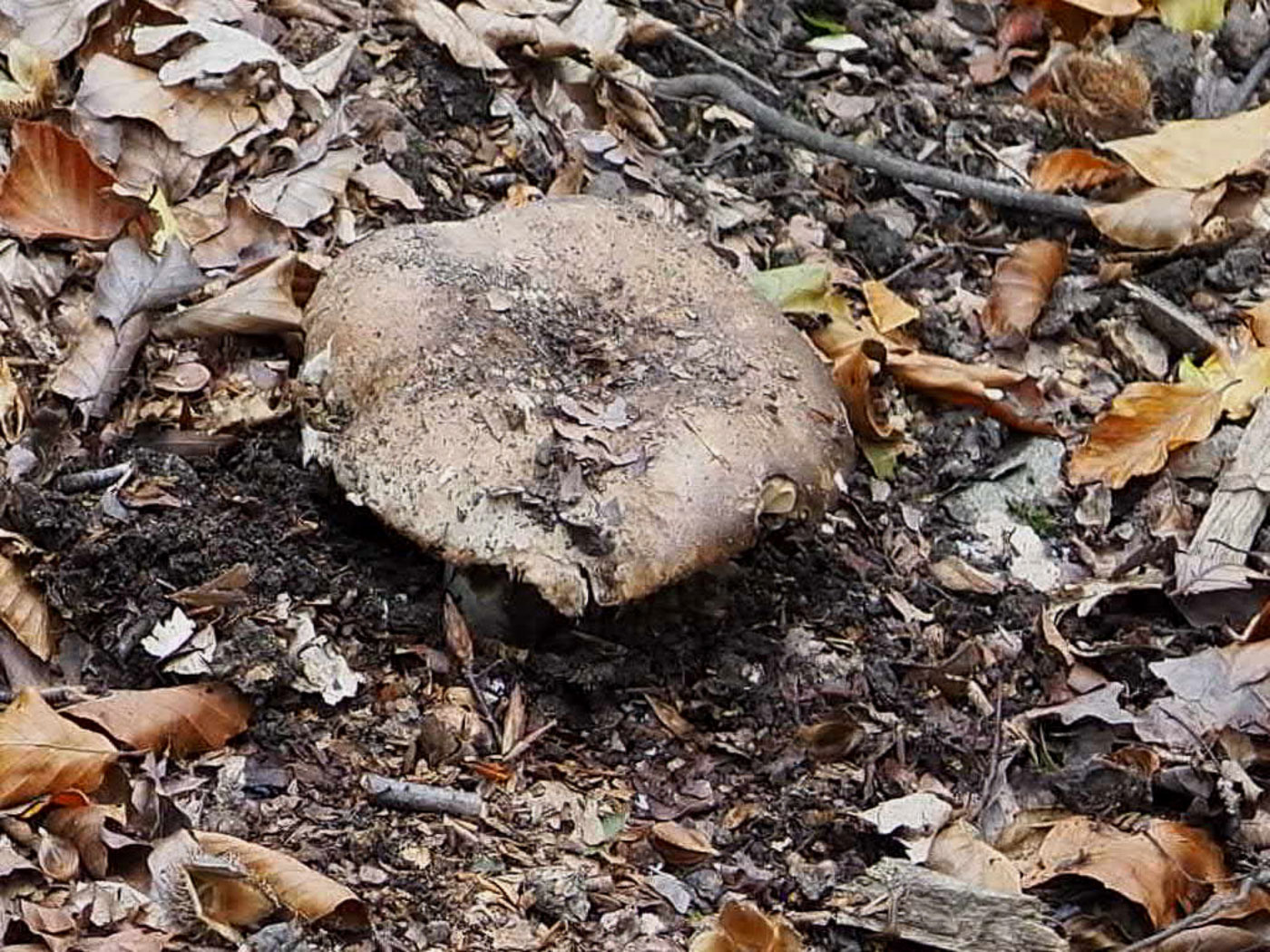  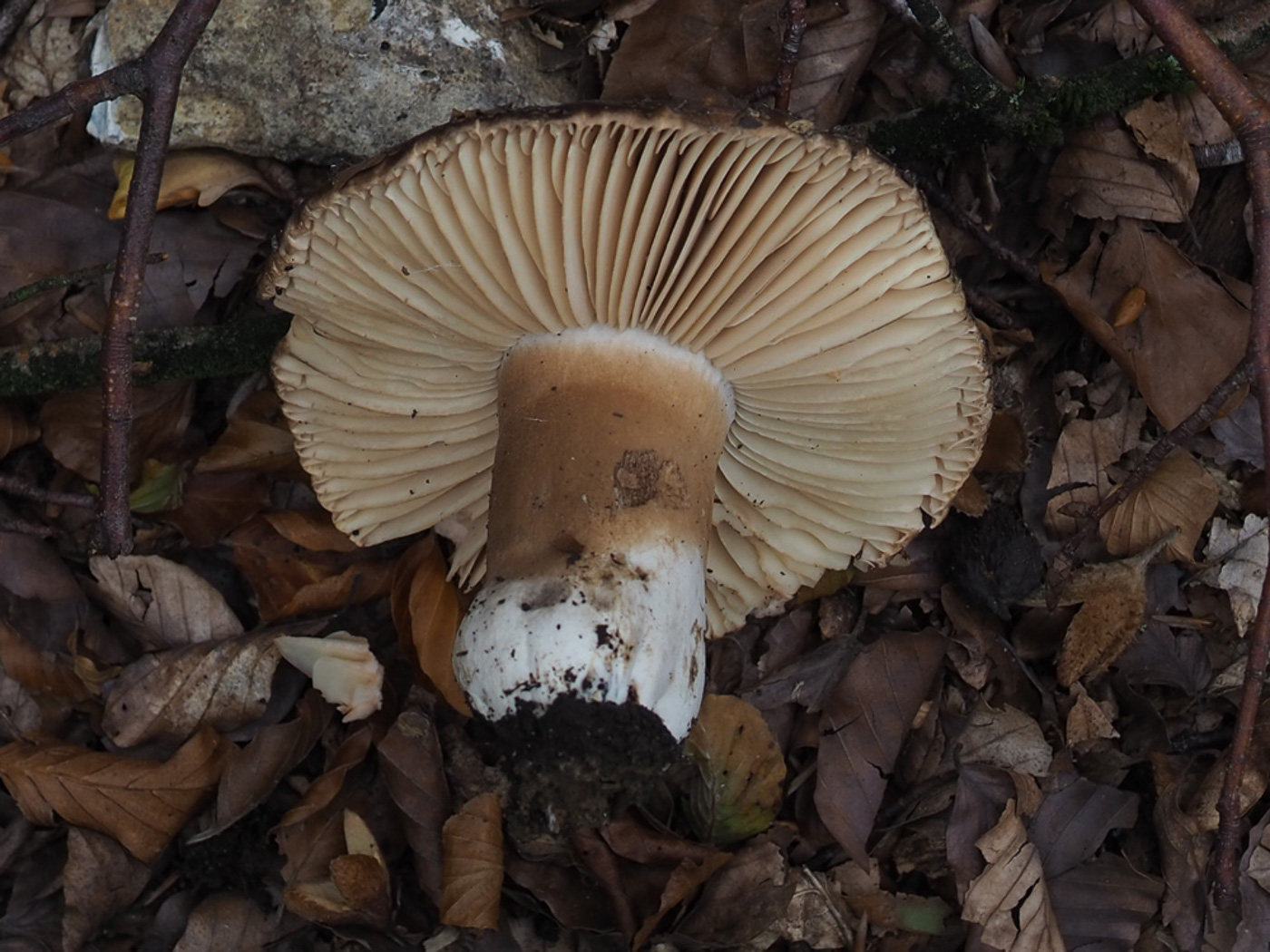
|
Oct 7, 2025. In Downley Wood John Catterson found this distinctive Brittlegill which, once turned over to reveal the strikingly widely spaced crumbly gills, cannot really be mistaken for any other. NB, a few others can look identical from above but have crowded gills. Cut this species open on collection and wait for 20 - 30 mins to see the inner flesh change from white through pink to reddish then eventually blackish (see photo 3). This a very common species found under both deciduous and coniferous trees. |
   |
Aug 4, 2023. In Hodgemoor Woods under Oak Penny found this very common species just beginning to fruit and easily recognised by its widely spaced gills and very solid brittle texture. On collection she broke one in half and then kept an eye on it and after 30 minutes the flesh had started to redden (photo 2). At home some time later the same specimen was beginning to blacken (photo 3). Several of the Compactae group of Brittlegills display this same colour change to the flesh but none have the widely spaced gills of this species. |
 |
Sep 18, 2020. A common Brittlegill usually but not exclusively under deciduous trees, this collection was found by Penny Cullington at Hodgemoor Wood under Beech, its commonest host. This is a large and solid Brittlegill, getting to 15cm across or more. It starts out with a whitish cap but soon darkens, eventually ending up entirely black (hence the common name). It has the widest spaced gills in the genus - a key feature especially as there are several others which look superficially similar from above but have crowded gills. If you collect one, break it open, retaining it for 15 to 30 minutes, and watch the damaged flesh turn first red and then gradually black. |
| Russula nobilis (Beechwood Sickener) |
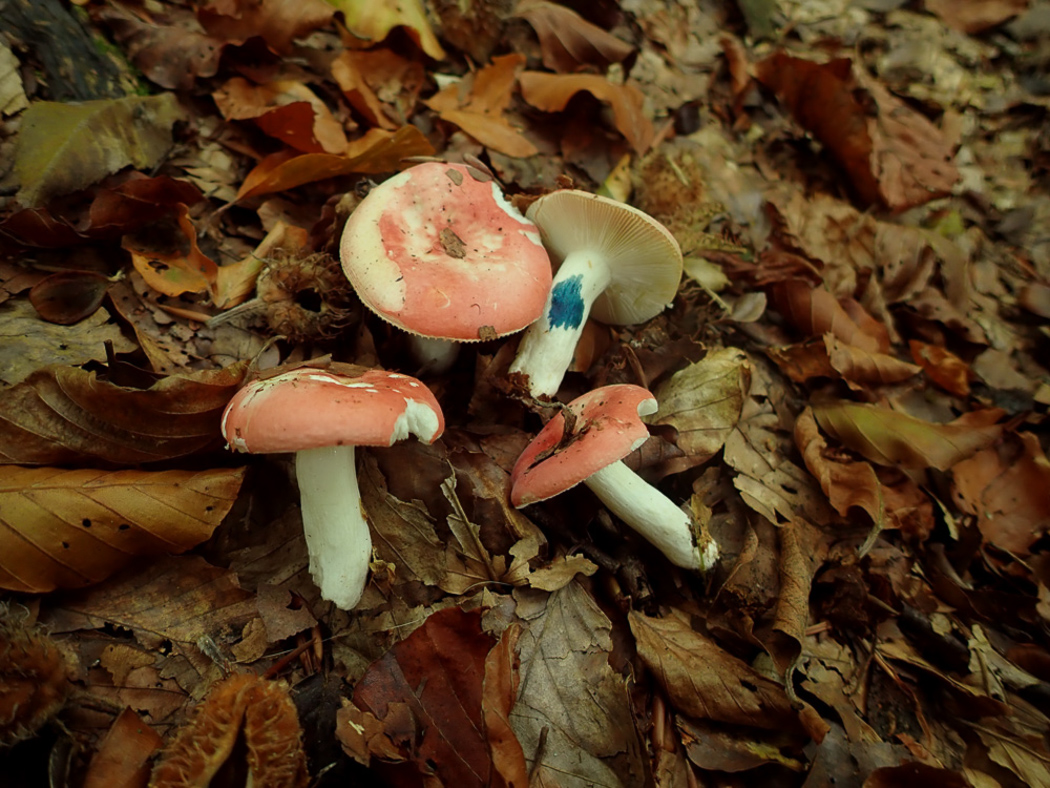
|
Oct 7, 2025. In Gussetts Wood there were many fruitbodies of this common but eye catching Beech associate. The cap can be pure pinkish red or have patches of cream as seen here, and though its English names refers to its inedibility to us humans it is clearly favoured by small mammals and slugs and often show signs of nibbling. There are many red capped Brittlegills but a drop of the resin Guaiac is useful and turns bright blue on the stem of this species within a few seconds whereas other lookalikes do not. (Incidentally the Latin epithet 'nobilis' is in the process of changing back to the previous 'mairei' though this is not yet universally accepted.) |
  |
Nov 24, 2022. In Bradenham Woods Penny uncovered a few of these bright red caps which were lurking in the thick leaf cover. Often one of our commonest Brittlegills under Beech, the species has been remarkably infrequent this season and made little appearance until well into October. As is often the way, many specimens are well eaten when you find them and are favourites with small mammals etc which obviously aren't detrimentally affected as we are by this species. |
 |
Oct 21, 2022. In Gussett's Wood under Beech Penny found a good selection of this Brittlegill though many caps were somewhat nibbled. Normally one of our commonest Brittlegills,it has been slow to get started this autumn. |
 |
Nov 3, 2021. Penny found this common Brittlegill under Beech in Hodgemoor Woods though like many of this genus it has been scarce this autumn. Told from other red-capped species by its pink-red cap which when peeled at the edge reveals pink flesh beneath, it has white gills and stem and is only found under Beech. |
 |
Oct 3, 2020. One of our commonest Brittlegills (previously R. mairei), only rather eaten singletons had been spotted until today in Penn Wood under its host tree and found by Penny Cullington. Yet another red-capped Brittlegill, this one has a much less firm feel than R. rosea (see dated 1st) and the cap skin peels readily from the edge to about halfway in, often leaving very pale pink flesh beneath. The colour is a soft pinkish rose red, often with cream patches, the gills are white and despite its common name most caps one finds have been eaten. |
| Russula ochroleuca (Ochre Brittlegill) |
 |
Aug 21, 2023. In Bradenham Woods Penny eventually collected enough specimens of this species which were not too chewed to show its characteristics. This is one of our commonest Brittlegills, found under both deciduous and coniferous trees, though many people regularly mistake it for one or other of our other yellow-capped species. Note how the dull greenish ochre yellow cap contrasts with white gills and stem - that's the best pointer. Host specific to Beech is R. fellea, also yellow but evenly honey coloured in cap, gills and stem. Host specific to Birch is R claroflava, bright yellow with cream gills but staining slowly reddish then black where damaged or scratched. A chemical trick: a drop of KOH on the cap centre or stem base of today's species uniquely stains it instantly bright red. See the Masterlist to make your own comparisons between these species. |
 |
Nov 13, 2021. At Turville Heath under Spruce Penny was surprised to find fresh fruitbodies of this common early season Brittlegill so took the opportunity to add it to Finds - many of our common Brittlegills are still missing and the genus seems to have been somewhat poorly represented this season. The species is happy under many different trees including conifers and its dull slightly greenish ochre colour contrast with its white gills and stem, helping to separate it from other yellow Brittlegills. |
 |
Sep 16, 2020. Probably our commonest Brittlegill, this collection was made at Penn Wood by Penny Cullington under mixed deciduous trees. This is not a fussy species and occurs under many trees, both deciduous and coniferous. Note the cap is rather dirty yellow with ochre tones in contrast to the bright yellow R. claroflava (see yesterday's photo). Another yellow species with which it is often confused is R. fellea (Geranium Brittlegill, host specific with Beech and not yet spotted this season). Note the white gills and stem of R. ochroleuca which clearly contrast with its cap colour, also it has no noticeable smell; in R. fellea the gills and stem are cream, not white, offering little contrast with the cap, also it has a sweet smell of stewed apple or Pelargonium leaves - hence its common name. |
| Russula odorata (Oak Brittlegill) |
 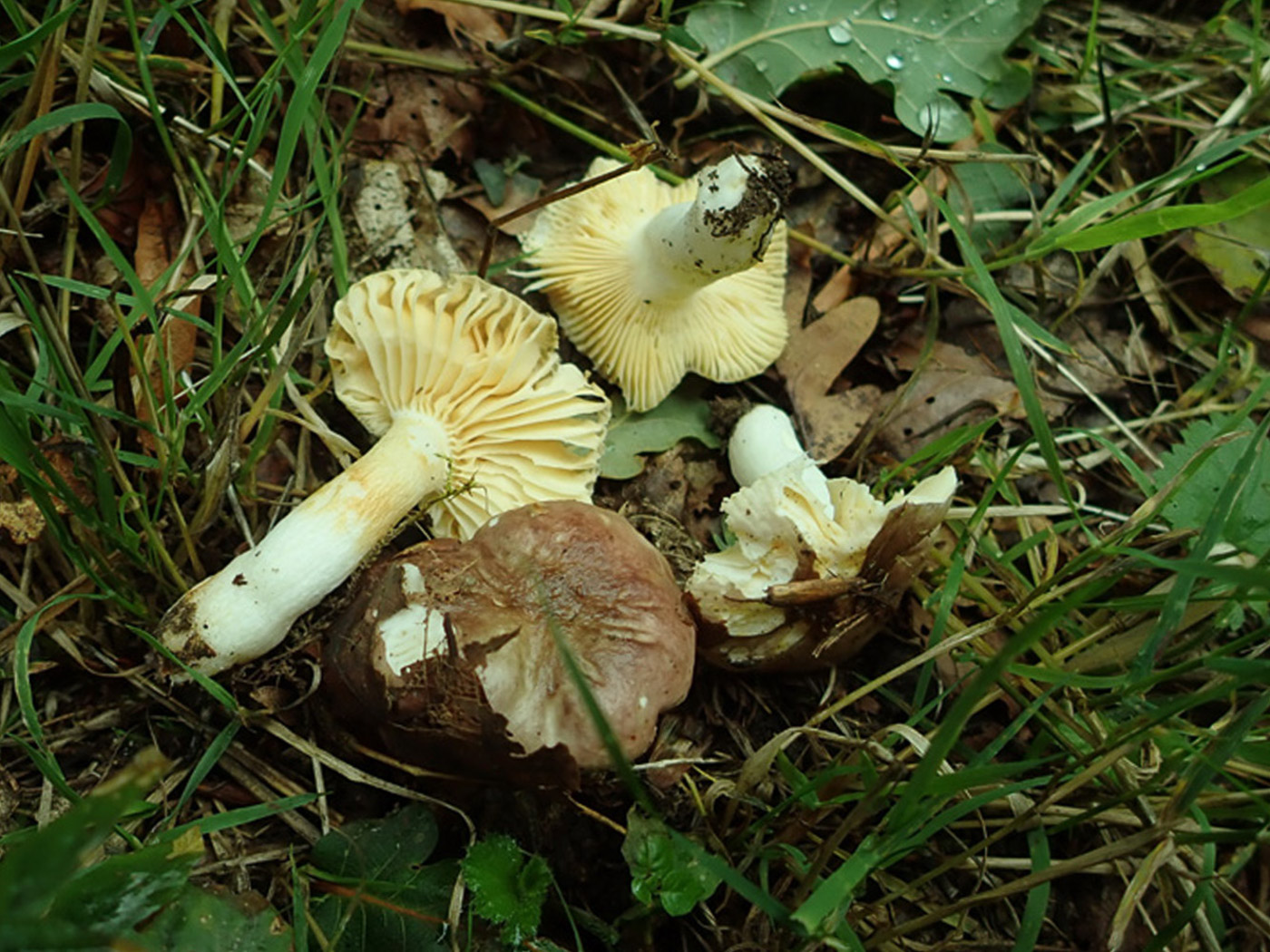
|
Sep 17, 2025.  Under the Limes at Turville Heath Penny came across a collection of small rather fragile Brittlegills with delicate peachy pink caps and remarkably orange gills. She didn't recognise them, took a couple of photos - two different collections - and when she collected them she noticed a really sweet fragrance. At home she worked on the microscopy and keyed it out to R. odorata, a species she was familiar with but only associating with Oak so had not considered this a possibility. However, the spore print dropped overnight was amazingly dark orange, correctly matching the species description, so she has confidence in her ID but will have the collection sequenced because Lime is not a recognised host. Under the Limes at Turville Heath Penny came across a collection of small rather fragile Brittlegills with delicate peachy pink caps and remarkably orange gills. She didn't recognise them, took a couple of photos - two different collections - and when she collected them she noticed a really sweet fragrance. At home she worked on the microscopy and keyed it out to R. odorata, a species she was familiar with but only associating with Oak so had not considered this a possibility. However, the spore print dropped overnight was amazingly dark orange, correctly matching the species description, so she has confidence in her ID but will have the collection sequenced because Lime is not a recognised host. |
  |
Jul 9, 2023. At Rushbeds Wood Penny was pleased to find her first Brittlegill of the season though few of this genus are recorded from here compared to our Beech woodlands where they abound. This is quite an uncommon species, one which favours Oak - a common tree here - and is small, often with pink colours (though completely missing here!), yellow gills with a surprisingly deep ochre sporeprint, a sweet smell and distinctive micro-characters which help with its ID. |
 |
Jul 15, 2021. At Cadmore End under a large Oak Penny found two specimens of a pink Russula and noticing that the gills were developing a deep cream colour she knew it was an interesting species. The reaction on the stem with a ferrous sulphate crystal was pale salmon (seen in the upturned specimen), with Guaiac at home was instantly bright blue, it had a sweet fruity smell, a mild taste and the cap cuticle peeled almost to the centre. These clues plus a sporeprint for colour and other microscopic features confirmed it as this unusual species, one which is mycorrhizal with Oak. Compare with Penny's photos of R. vesca, dated July 12th - another pink species! |
| Russula olivacea (Olive Brittlegill) |
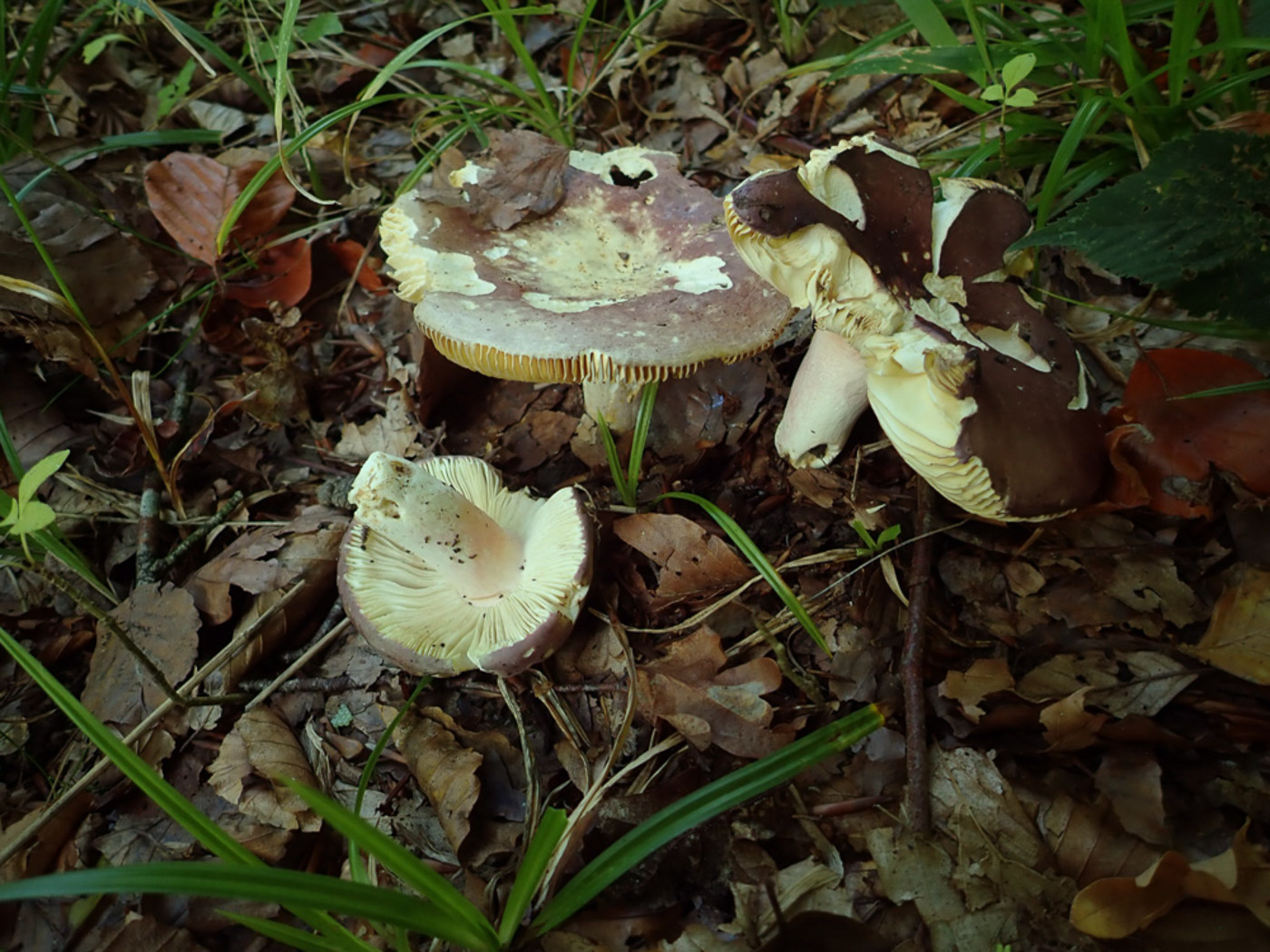 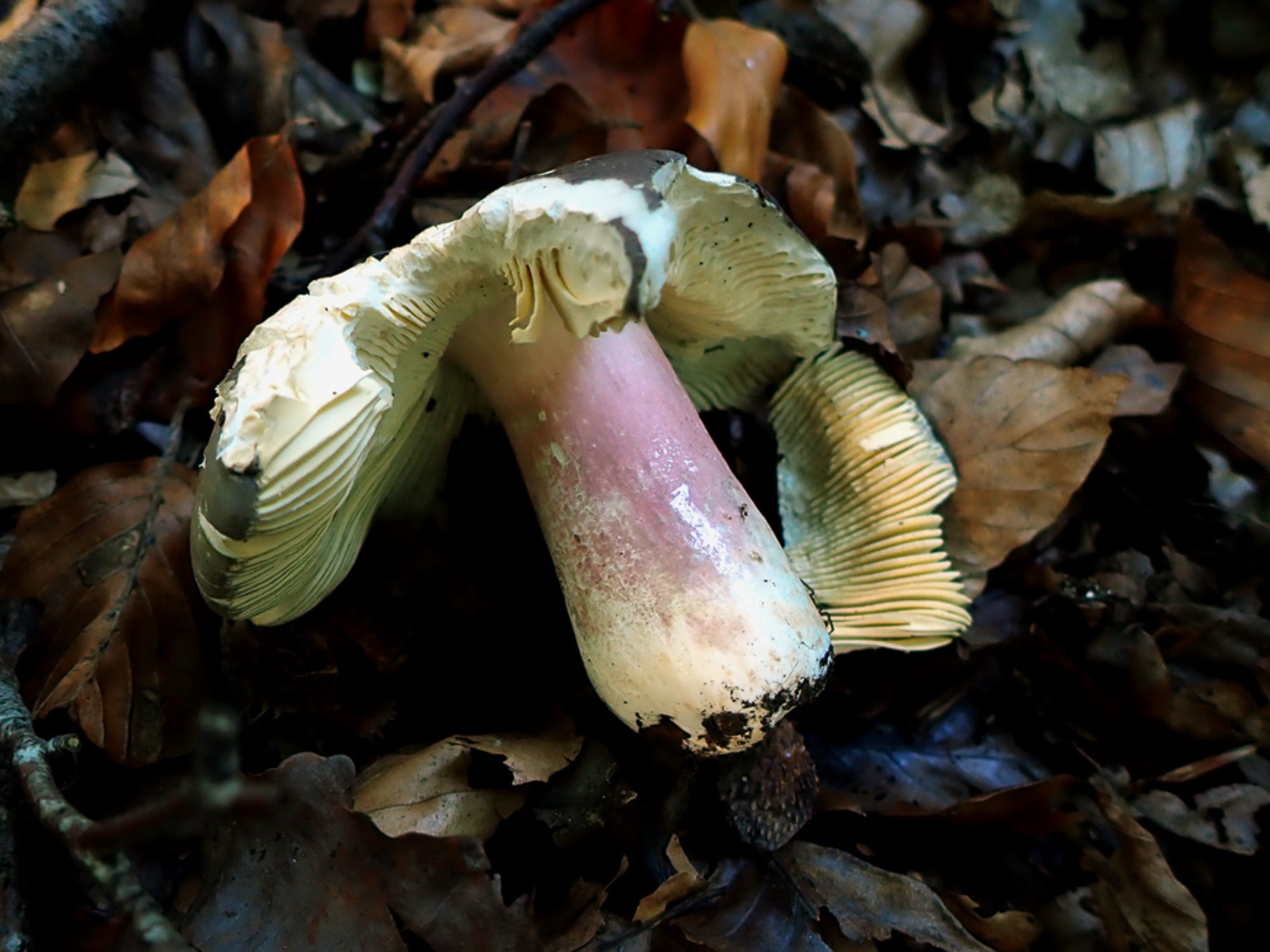 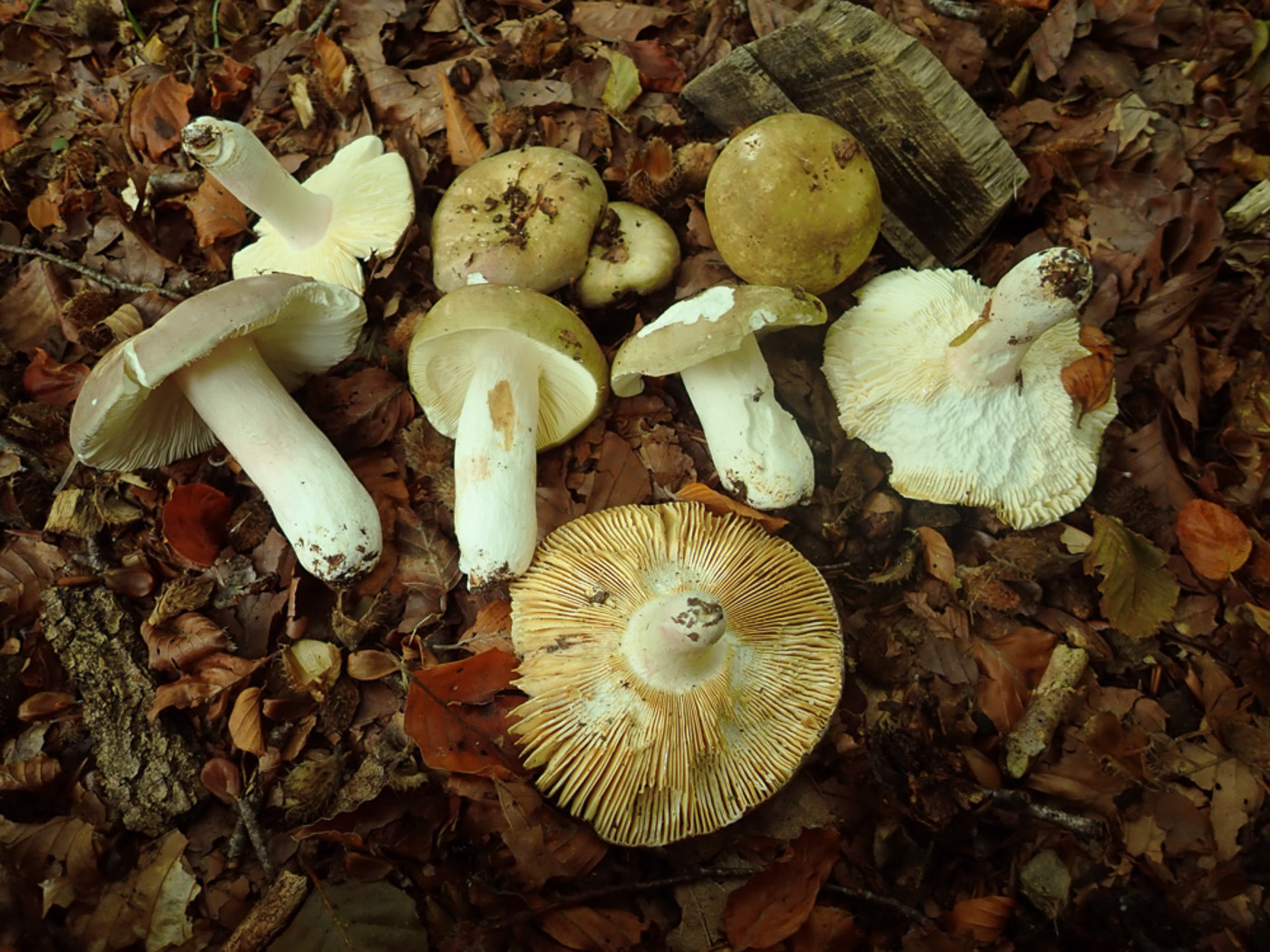 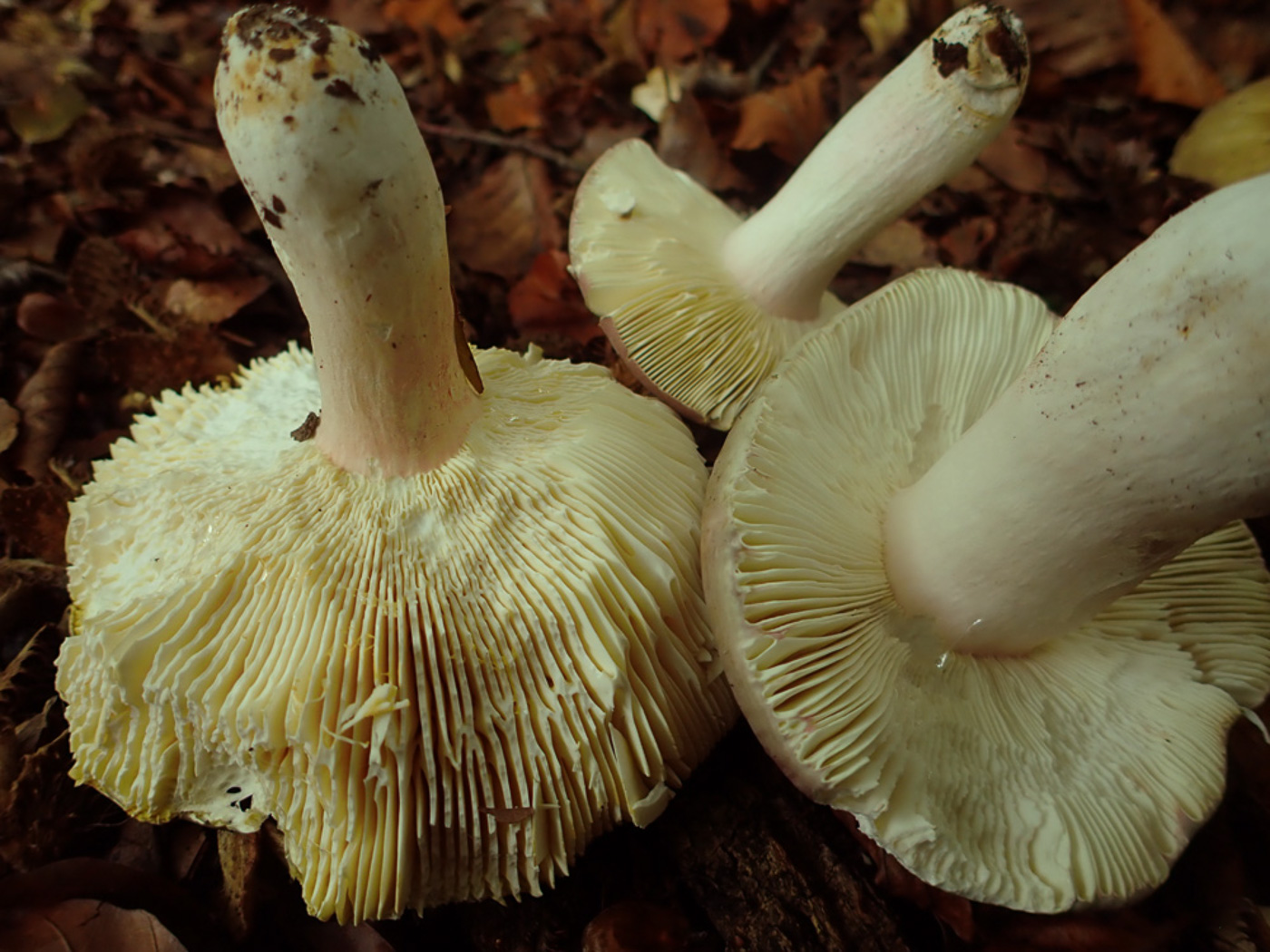
|
Sep 27, 2025. When Penny visited Gussetts Wood - a beautiful Chiltern beechwood - the floor was brimming with this large Brittlegill amongst many other things. Host specific to Beech, it is not uncommon in this area and is somewhat variable in cap colour, tending to have olive shades at first but soon becoming purplish pink, often with cream markings also. The gills are dark cream and the thick chunky stem, basically white, regularly develops a subtle and beautiful shade of pink which seems to glow and occurs just under the cap and sometimes lower down also (though this subtle colour seems reluctant to show really well in a photo). If in doubt over ID this feature together with the Beech association is the clincher. Her visit a week or so later produced further photo opportunities showing the olive shades of the young caps (photos 3 and 4). |
 |
Aug 16, 2023. Under Beech in Gussett's Wood Penny and Paul found this species in various places though all were somewhat damaged, eaten or past their best. The collection does at least show the range of cap colour which is by no means just 'olive' as its common name might suggest. This is a chunky Brittlegill - the largest cap here was 11 cm across - and only occurs under Beech, and despite its varied appearance it has one revealing field character: its solid white stem flushes a subtle shade of pink just under the apex, sometimes further down as well. This can just be seen here in the lowest RH upturned specimen but is not easy to capture on camera. |
  |
Oct 7, 2022. At Pullingshill Wood Penny found just this one large specimen of a beautiful and quite uncommon species which associates with Beech - the nut cupule which had landed on the cap gives a sense of scale. The cap colour is quite similar to some other species but the subtle pale pink blush on the upper stem is a unique feature of this species, and here it was surprisingly clear at the apex. |
  |
Sep 27, 2020. This occasional species was quite common under Beech (with which it is host specific) in Mousells Wood, found by Penny Cullington. Superficially similar to others in this large and tricky genus, it is a big firm species though the cap colour is very variable and often much more vinaceous pink than shown here. The give-away character in the field is the subtle pink flush right at the top of the stem (see second photo). Confirmation is the salmon reaction when the stem is rubbed with a crystal of Ferrous Sulphate and the almost unique blackcurrant stain with a drop of Phenol (other Brittlegills turn dirty brown). Both reactions are visible in the photo. |
Russula parazurea (Powdery Brittlegill)  |
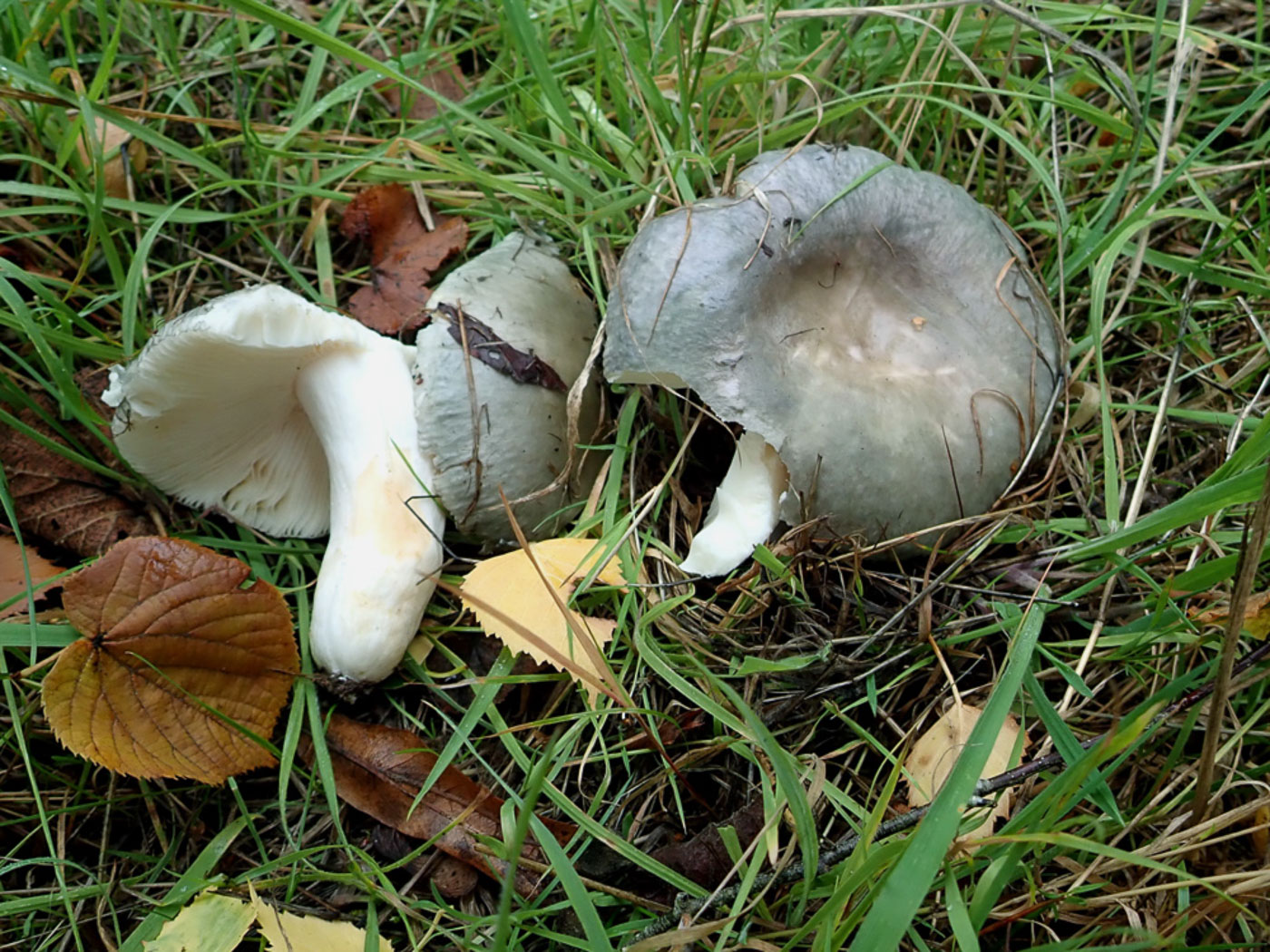 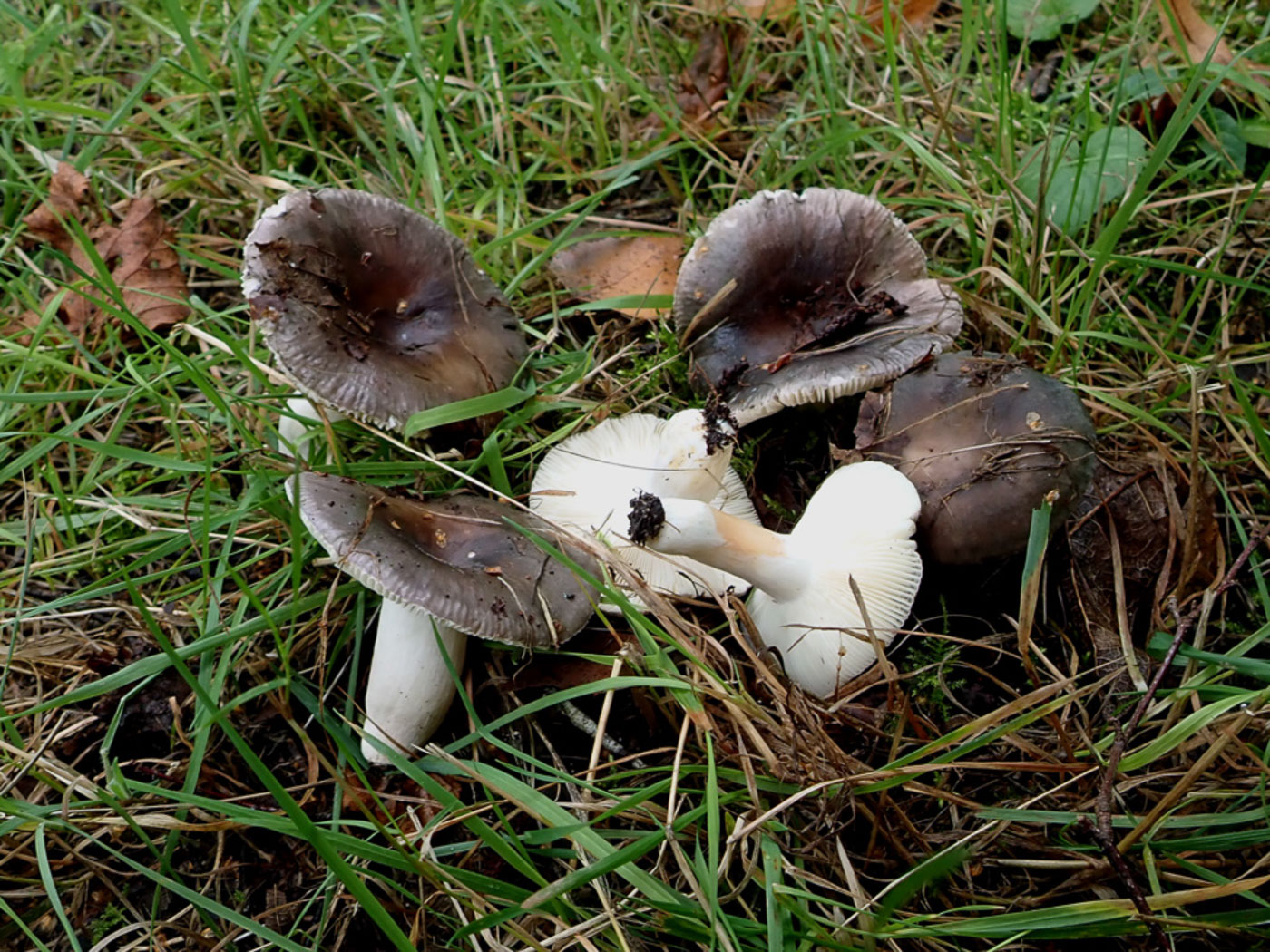 
|
Sep 14, 2025.  At Turville Heath Penny found a selection of rather different examples of this Russula under Birch and thought on collection that more than one species might be involved. However, checking the cap cuticle and spores revealed all three collections were indeed this species despite the lack of typical obvious 'pruina' (bloom) showing on the cap surface which is considered one of the key field characters. It is most commonly found under Oak but not today. At Turville Heath Penny found a selection of rather different examples of this Russula under Birch and thought on collection that more than one species might be involved. However, checking the cap cuticle and spores revealed all three collections were indeed this species despite the lack of typical obvious 'pruina' (bloom) showing on the cap surface which is considered one of the key field characters. It is most commonly found under Oak but not today. |
 
|
Aug 1, 2025. At Turville Heath Penny spotted this blue-green cap in a grassy path near a mix of deciduous trees, and the colour instantly looked right to her for this species. The rather dull 'pruinose' surface together with a mix of shades including some brown (seen here at the centre though sometimes much more dominant and sometimes completely absent) was typical, as were the cream gills and white stem when she turned it over. At home the negative Guaiac reaction on the stem together with spores having low warts and an almost complete reticulum (mesh of tiny black lines) confirmed her field ID. This is a common species though probably goes unrecognised by many and is frequently but not exclusively found under Oak
|
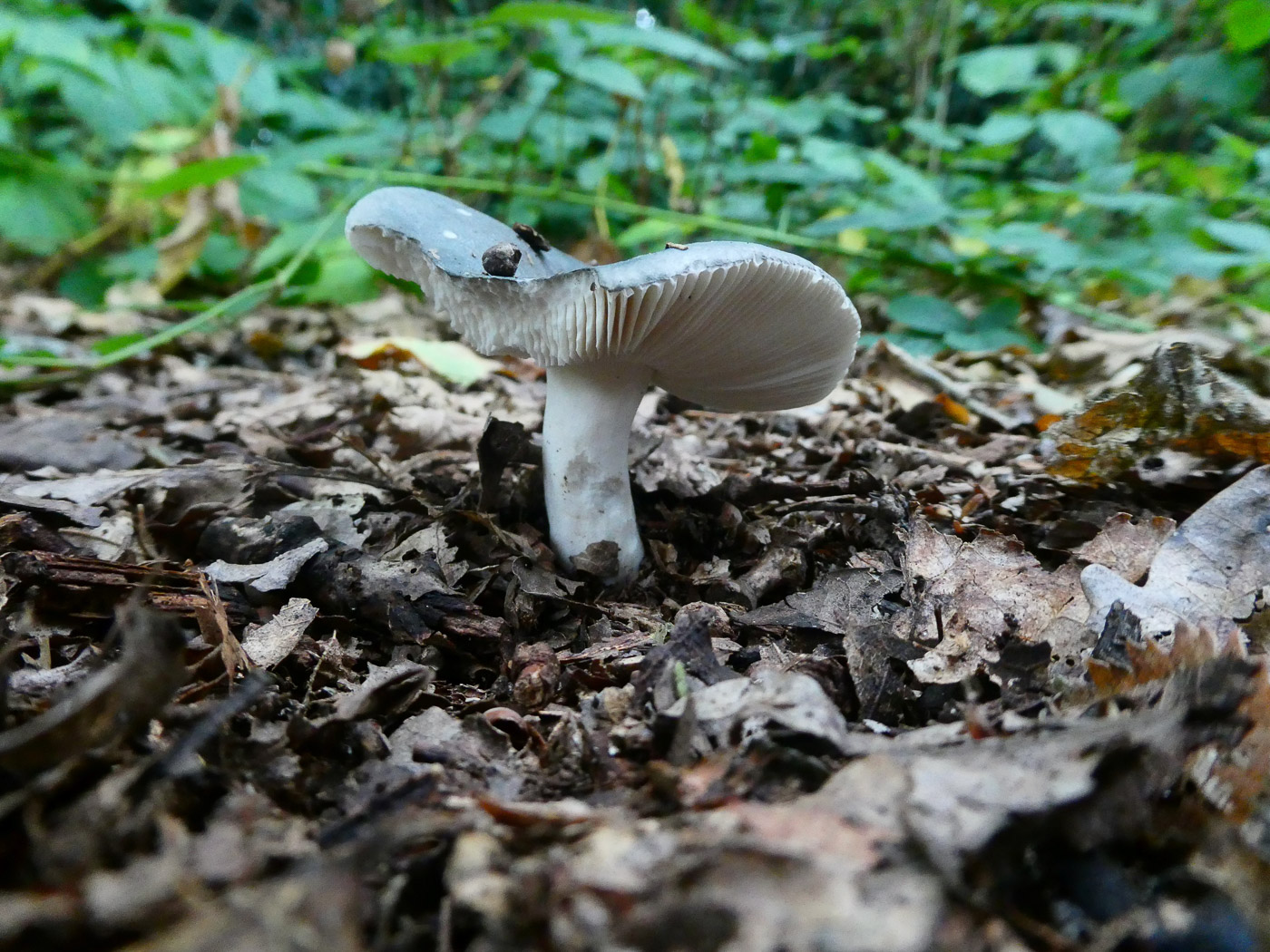 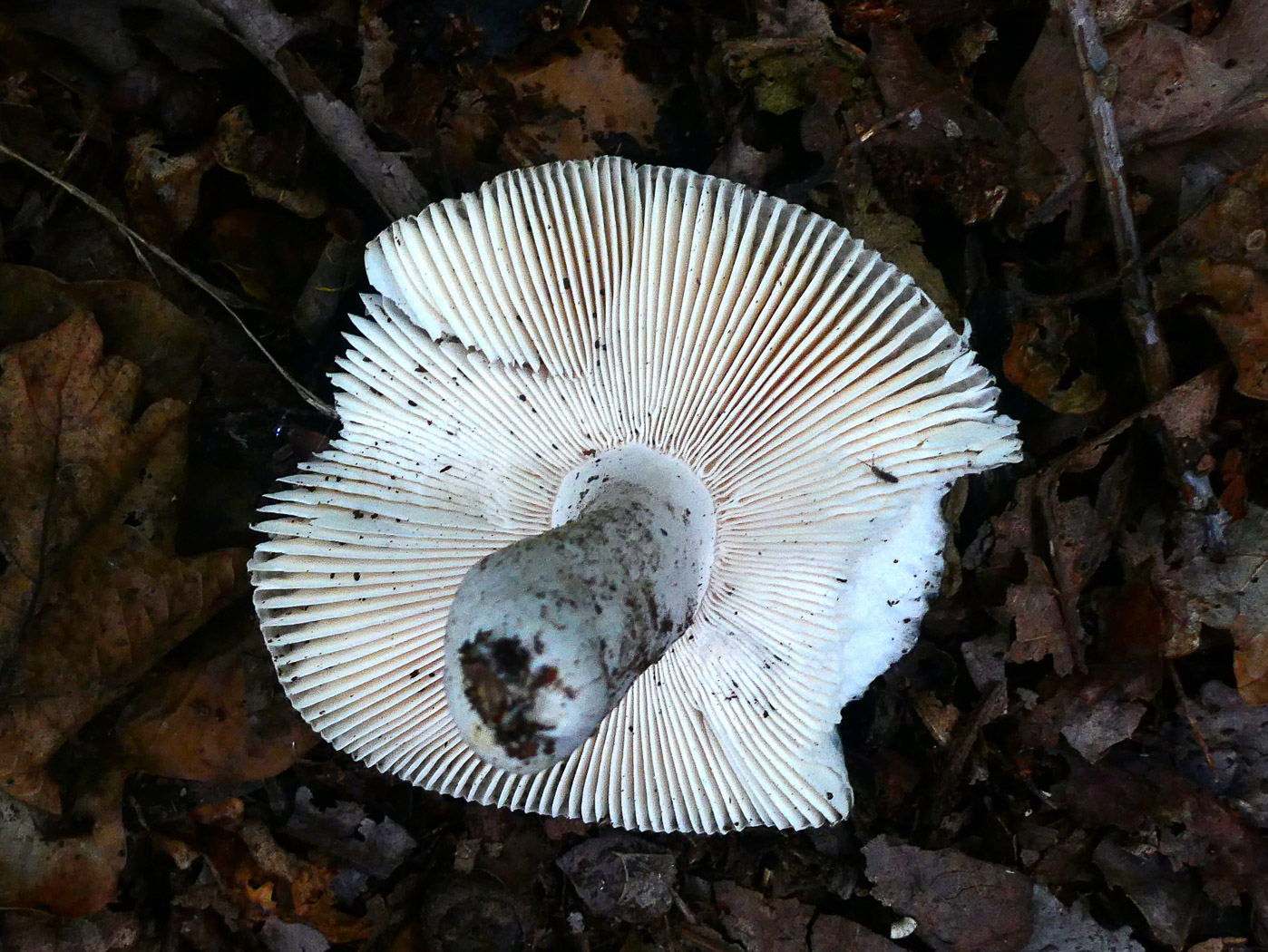 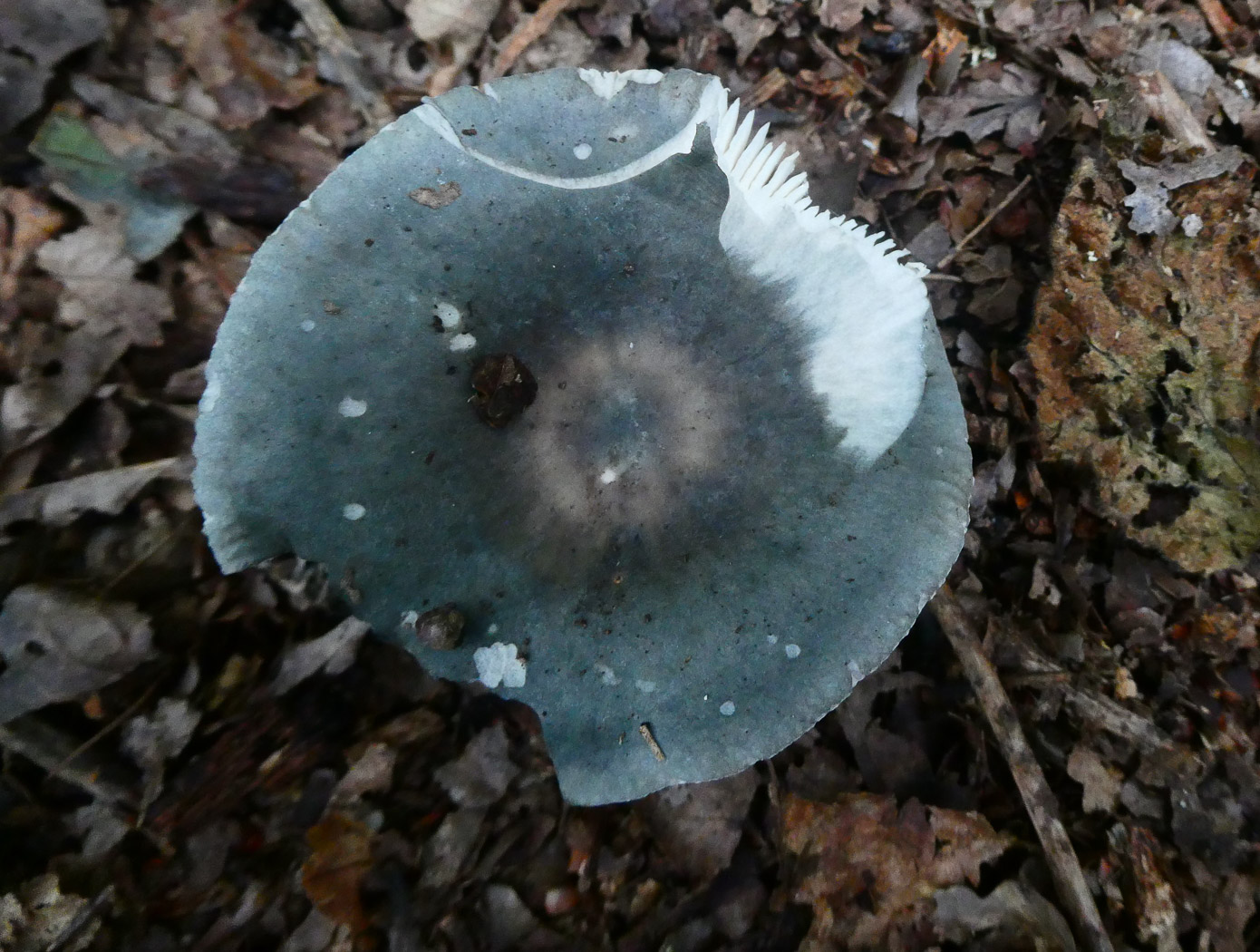 |
Sep 3rd, 2024. In Austenwood Common under Oak Jim Wills found this singleton green Brittlegill and correctly identified it noting the various clues. It is one of several green species (though can sometimes be much browner, like the colour of the cap centre seen here) and the salmon reaction when rubbed with a crystal of iron salts, also the cream gills, quickly eliminated both R. heterophylla and R. cyanoxantha. Other possible contenders were R. grisea and R. ionochlora, but its occurrence under Oak (its preferred host) together with blue-green rather than violet-pink flesh revealed by peeling the cuticle pointed to R. parazurea. Furthermore, the dull pruinose cap surface (as if with a bloom like a grape) confirmed it. |
 |
Jul 18, 2023. Under Oak in Gerrards Cross Common Jesper Launder noticed this Brittlegill which more often than not in our area has a greyish blue green cap with rather a matt 'pruinose' surface (having a 'bloom' as in a bunch of fresh grapes). It can also present with entirely brown colours or a mix of all these colours as seen here. Easy to confuse with R. grisea and R. ionochlora - described as have colours of spilt petrol, the flesh when revealed by peeling away a bit of the cap cuticle is greeny grey as opposed to mauvy pink in the other two. All three have cream gills and a similar salmon pink reaction when the stem is rubbed with a crystal of ferrous sulphate; they can be further compared via our Masterlist. |
 |
Sep 13, 2022. Under Oak in Naphill Common John and Leslie Catterson found several of these greyish capped Brittlegills. The cap colour of this particular species is quite variable, sometimes with a blue green tinge, sometimes yellow-green or even brownish green. The cap surface is dull and matt, often with a 'bloom', hence its common name, and it has pale cream gills and favours Oak - one of our commonest Brittlegills though not always readily recognised. |
| Russula persicina (an unusual Brittlegill with no English name) |
  |
Aug 19, 2023. In Rushbeds Wood along a muddy path edge under Oak Penny found this Brittlegill and instantly guessed it would turn out to be R. luteotacta from the cap colour and texture. 'Peaches and cream' is how she likes to describe it, also it is remarkably firm (both stem and cap) and the cuticle refuses to peel at all. It's unique feature is one you have to wait for, however: given several hours - sometimes overnight - any damaged parts turn brassy yellow (see Finds 2020 September 27th). However, there is a lookalike Brittlegill which has all the same features apart from lacking the brassy yellow staining though the sporeprint colour also differs: white in R. luteotacta but cream in the rarer R. persicina. Having left today's collection in a pot overnight and expecting to find it showing the telltale staining by morning, she found instead no staining but in the bottom of the pot a cream sporeprint! Both species favour damp clay soils under Oak and both have been found at Rushbeds though Penny had forgotten the Rushbeds collection here on August 3rd 2021 when it was new to the county - see that Finds entry (with apologies for the dreadful photos). So today's is the second county record (and thankfully also better photos!) |
  |
Aug 3, 2021. In deep grass along a wide ride in Rushbeds Wood Penny found this large and impressive Brittlegill, the nearest trees being Hazel and Oak. Two caps were about 9 cms across and a young specimen was nearby. The unusual cap colour (a real blotchy mix of pink-red and cream-white) together with cream gills and white thick stem suggested two possible species: R. luteotacta or R. persicina, the first occasional in the county, the second not yet recorded here. A sporeprint overnight was the first priority, followed by scratching the stem and cap surface and waiting for the telltale bright chrome staining of R. luteotacta to develop - also probably overnight. Other characters (the hot taste and cap cuticle not peeling) fitted well with both species but the spore ornamentation pointed to R. persicina, this confirmed in the morning by the deep cream rather than white sporeprint and the lack of any chrome staining where damaged. Not only new to the site but to the county, this is quite a rarity and was a pleasing find. |
| Russula praetervisa (Bypassed Brittlegill) |
 |
Aug 1, 2021.  In Jordans village Jesper Launder collected an inconspicuous Russula under Oak, recognising it as one belonging to the 'Smellies' group. (See other examples of this group dated July 16th and also today found by Penny). Taking it home to work on - often necessary with this genus - he noted the rusty stains on the lower stem as well as the mild taste and particular spore ornamentation which separate this species from another rarely recorded and very similar species, R. pectinata. Both occur under Oak, are yellowish ochre, have fluted cap margins and are viscid in moist conditionsas well as having unpleasant smells. We have just one previous record: from Hodgemoor Woods identified by Geoffrey Kibby. In Jordans village Jesper Launder collected an inconspicuous Russula under Oak, recognising it as one belonging to the 'Smellies' group. (See other examples of this group dated July 16th and also today found by Penny). Taking it home to work on - often necessary with this genus - he noted the rusty stains on the lower stem as well as the mild taste and particular spore ornamentation which separate this species from another rarely recorded and very similar species, R. pectinata. Both occur under Oak, are yellowish ochre, have fluted cap margins and are viscid in moist conditionsas well as having unpleasant smells. We have just one previous record: from Hodgemoor Woods identified by Geoffrey Kibby.
|
Russula pseudointegra (Scarlet Brittlegill)  |
 |
Jul 30, 2021. Whilst on a bike ride in Seer Green Jesper Launder spotted several brightly coloured caps on a bank under Oak and on close inspection recognised this beautiful Oak loving species which sports a shiny smooth red cap and develops deep orange gills as the spores mature - it has one of the darkest sporeprints in the genus. Taste can often be a useful character amongst Brittlegills: mild, hot, bitter or acrid depending on the species. Jesper confirmed the unique menthol acrid taste of this species and also checked other microscopic features plus the sporeprint. |
  |
Sep 30, 2020. This striking Brittlegill was found under Oak, its host tree, at Turville Heath by Penny Cullington. A large and not uncommon Brittlegill with caps up to 10 cm across, it is one of many having red caps but is possibly the most striking when shiny and fresh as it was today. Sadly the second specimen nearby was smashed but served to show the gill colour which starts out pale cream but eventually becomes yellow-orange in maturity. Just visible in both photos is the pale rusty salmon stem reaction when rubbed with a Crystal of Ferrous Sulphate. |
| Russula puellaris (Yellowing Brittlegill) |
  |
Jul 13, 2023.  In Jordans village under Oak Jesper Launder spotted this singleton apparently under Oak. This is a small and delicate species - not that common locally, having a pink cap which tends to turn yellowish with age, shiny and sulcate (furrowed) near the margin; the gills are yellow giving an ochre sporeprint and the white fragile stem also tends to turn yellow with age or damage. It occurs under a mix of deciduous trees and is a new entry for Finds. In Jordans village under Oak Jesper Launder spotted this singleton apparently under Oak. This is a small and delicate species - not that common locally, having a pink cap which tends to turn yellowish with age, shiny and sulcate (furrowed) near the margin; the gills are yellow giving an ochre sporeprint and the white fragile stem also tends to turn yellow with age or damage. It occurs under a mix of deciduous trees and is a new entry for Finds.
|
| Russula risigallina (Golden Brittlegill) |
  |
Jul 19, 2023.  In Kings Wood, Tylers Green, Penny found surprisingly little about but this attractive Brittlegill was just pushing through the thick Beech mast. The species is one of several with yellow cap colours but differs from others by having ochre gills rather than white or pale cream, also a deep ochre sporeprint. Photo 2 shows the immature central specimen with gills still pale cream but the more mature upturned specimen reveals the spores' true deeper colour. The cap is variable and can be both yellower and pinker than this example but the mature gill colour and spores are consistent. Despite this being a new entry for Finds, the species is quite common under a mix of deciduous trees but does seem to favour Beech. In Kings Wood, Tylers Green, Penny found surprisingly little about but this attractive Brittlegill was just pushing through the thick Beech mast. The species is one of several with yellow cap colours but differs from others by having ochre gills rather than white or pale cream, also a deep ochre sporeprint. Photo 2 shows the immature central specimen with gills still pale cream but the more mature upturned specimen reveals the spores' true deeper colour. The cap is variable and can be both yellower and pinker than this example but the mature gill colour and spores are consistent. Despite this being a new entry for Finds, the species is quite common under a mix of deciduous trees but does seem to favour Beech.
|
| Russula romellii (a Brittlegill with no English name) |
 |
Oct 5, 2022.  Under Beech at Whiteleaf Cross Penny was pleased to find this large and showy Brittlegill and even more pleased to turn it over and see the amazing dark orange gills. The species has one of the darkest spores prints in the genus and is not that common. We have just a handful of previous county records, the last in 2017, hence this is a new species for Members' Finds. Under Beech at Whiteleaf Cross Penny was pleased to find this large and showy Brittlegill and even more pleased to turn it over and see the amazing dark orange gills. The species has one of the darkest spores prints in the genus and is not that common. We have just a handful of previous county records, the last in 2017, hence this is a new species for Members' Finds.
|
| Russula rosea (previously lepida) (Rosy Brittlegill) |
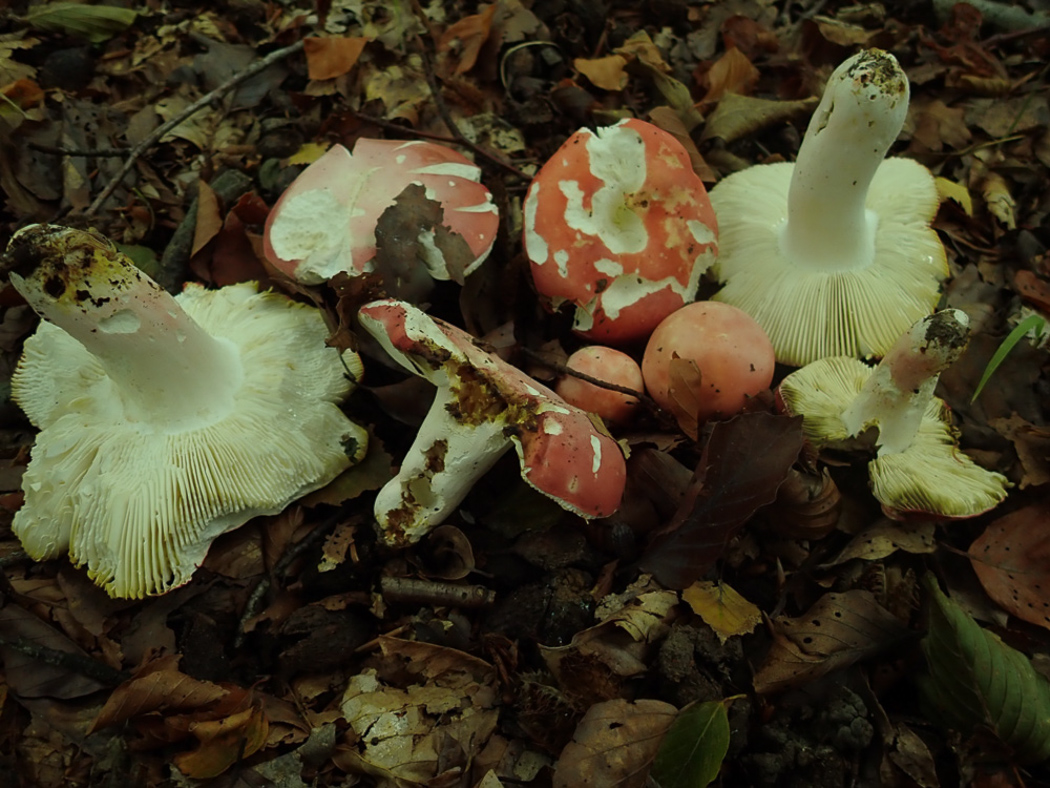 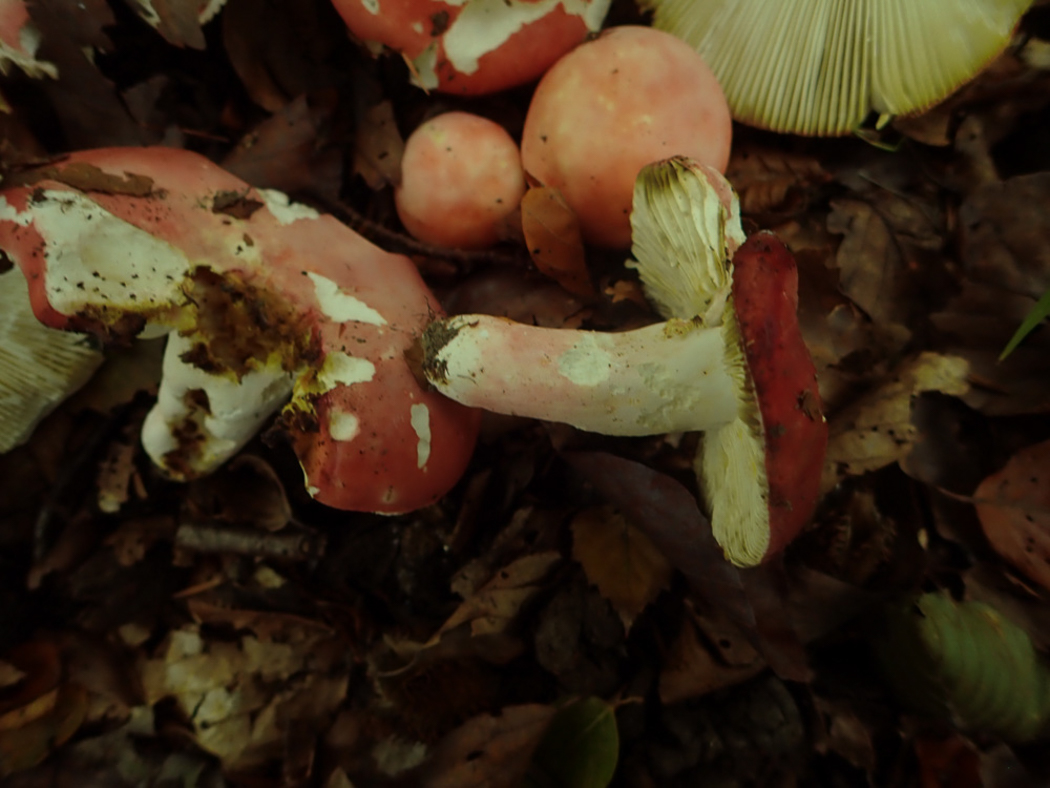
|
Oct 7, 2025. In Gussetts Wood under the many Beeches Penny found good numbers of this red capped species, one which can be confused with R. nobilis, commonly found under Beech as well. Differences to separate them: the cap cuticle in R. rosea is reluctant to peel off very far (described as adnate) whereas in R. nobilis it will readily peel, revealing pinkish flesh beneath. Perhaps even more obvious is the very firm texture of R. rosea - both cap and stem feel really solid and chunky, whereas R. nobilis is more fragile and will crumble quite easily. One more clue: if you see any red colour on the stem this eliminates R. nobilis but occurs quite commonly in R. rosea (see photo 2). (Just to complicate matters, R. rosea caps can have cream colours as well as red and can even be entirely cream! (This genus is not for the faint-hearted!) |
  |
Aug 27, 2023. Under Beech in Park Wood Ibstone Penny eventually found four examples of this quite common Brittlegill to assemble for a photo. This is one of many red-capped Brittlegills but its colour can vary considerably and somewhat confusingly from bright red through pink to entirely cream! It does have one redeeming feature which separates it from other lookalikes: it has a notably hard cap and stem - really solid, also the cap cuticle is adnate, ie it hardly peels at all unlike other red-capped species which will peel at least a quarter of the way in from the margin. It can also have red on the stem unlike others but this is an inconsistent feature. There is, however, a slight patch of red to be seen on the top left stem in photo 2. (Footnote: there has been much confusion over its species name because previously the name 'rosea' applied to a different species which was changed first to aurora and then to velutipes! It is possible today's species may revert to lepida to remove this less than ideal situation.) |
 |
Sep 1, 2020. One of many red capped members of this genus, this species (found by Penny Cullington under Oak and Beech at Wotton Park Estate) often has a red stem as seen on one specimen here, also has much firmer flesh than other similar species and a cap cuticle which hardly peels at all |
| Russula sanguinaria (Bloody Brittlegill) |
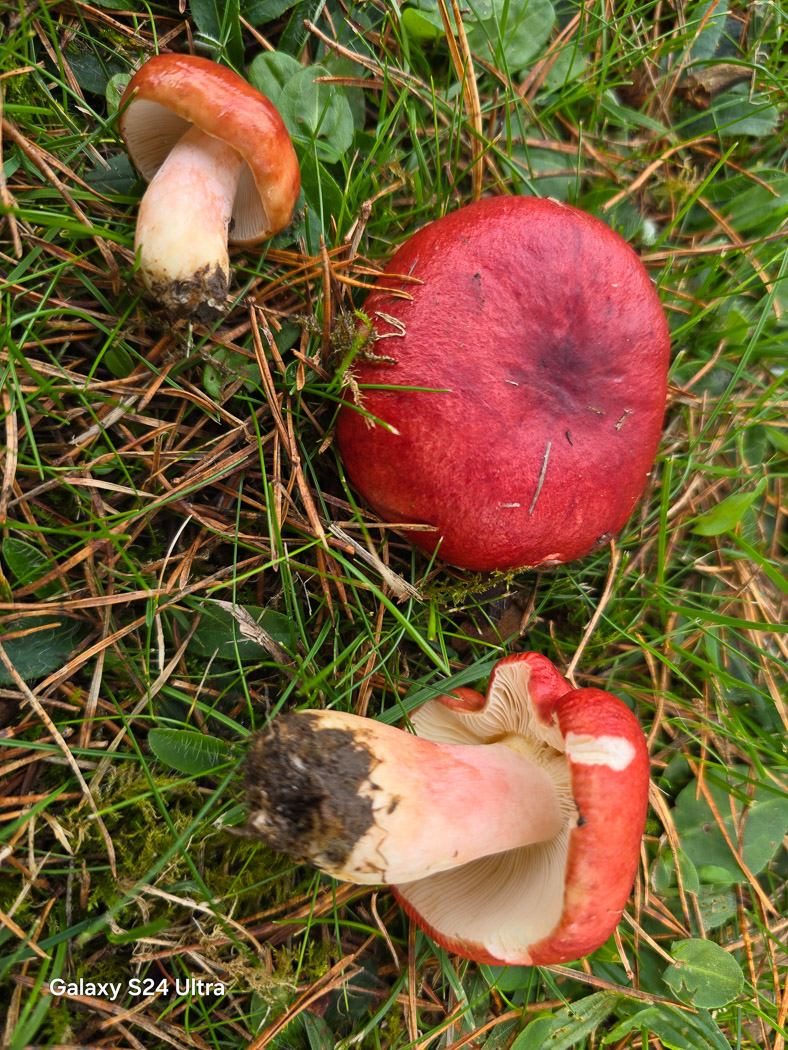 |
Oct 15, 2024. This genus has been extremely poorly represented so far this season. Jesper Launder was pleased, therefore, to find this collection under Pine at Audley Chalfont Dene retirement village. The species is host specific with Pine and the stem is characteristically cap coloured whihc helps to separate it in the field form other red-capped species. |
 |
May 24, 2024. In a church yard in Gerrards Cross under Pine Jesper Launder spotted this lone Russula which, though not in the best nick and having been well nibbled, was easily identifiable from its typical cap colour, white gills, pink stem and occurring under Pine. Though in some areas of the country considered a very common species wherever this tree is planted, this is not born out by our county records which number just two! In fact several fairly ordinary Brittlegills which occur only under Pine are notable by their scarcity in Bucks. So today's find was doubly unusual as May is not the month one would expect to come across this genus. |
  |
Nov 6, 2020. When Penny C. searched under Pine at Burnham Beeches a few day ago she found several of the red capped Brittlegills which are host specific but missed out on this one, found today by Paul C. It lacks the purple tints of R. sardonia and R. caerulea (both dated Oct 03) and is an intense pink red to blood red, sometimes with palish to white patches or fading at the margin as here. Gills are cream and when mature subdecurrent as here. Stems are variable: sometimes white, sometimes entirely concolorous with the cap as here, or anything in between! This species appears to be new to the site today and we've recorded it at only two other county sites, so though thought to be quite common under Pine that certainly isn't the case locally. |
| Russula sardonia (Primrose Brittlegill) |
.jpg) .jpg) |
Oct 31, 2023. Under Pine at Burnham Beeches Mario Tortelli identified this Brittlegill (the photo is Jim Wills'). The species is host specific to Pine and considered quite common given that host but we have hardly any county sites for it other than this one. The common name refers to the gill colour which is usually tinged yellow though it doesn't appear to show very convincingly here. What does, however, is the deep red purple cap colour which is repeated on the stem. Note also the pale pink patch on the gills in photo 2: this is a chemical reaction to a drop of ammonia being added though it often takes a minute or so and doesn't necessarily appear exactly where the drop is added! This is the diagnostic test for the species. |
  |
Nov 3, 2020. Under the Pines near the Mire in Burnham Beeches Penny C. was surprised to find several species of Brittlegill fruiting so late in the season, though not in the best condition. R. sardonia is host specific with Pine and distinguished by its vinaceous to purple red cap sometimes with green tints, its pale primrose yellow gills and a white stem which often has patches of cap colour (seen of several of today's specimens. With many Brittlegills it can be a useful identification aid to taste the flesh which can be mild, hot or bitter according to species. Luckily R. sardonia has enough features without the need to taste it because it is prohibitively burning hot! One such feature is that a drop of Ammonia on the gills turns bright pink though only after 10 minutes or so. Photo 2 shows this feature, tested once Penny was home. We have four previous county records. |
| Russula silvestris (Woodland Brittlegill) |
  |
Jul 17, 2023.  In Gerrards Cross Common under Oak Jesper Launder spotted this singleton, a species easily confused with the much more common R. nobilis (Beechwood Sickener). Both species have a rose pink red cap, sometimes pale cream in places, also a white stem and gills; whilst R. nobilis is host specific with Beech, R. silvestris favours Oak or occasionally Sweet Chestnut. So if both Beech and Oak are in the vicinity the two are tricky to separate. A drop of Guaiac on the stem helps: positive (instantly bright blue) in R. nobilis but negative (no change or just slight blue after a time) in R. silvestris; there are microscopic features which can help as well. No doubt the species is often misidentified and this is a new entry for Finds. In Gerrards Cross Common under Oak Jesper Launder spotted this singleton, a species easily confused with the much more common R. nobilis (Beechwood Sickener). Both species have a rose pink red cap, sometimes pale cream in places, also a white stem and gills; whilst R. nobilis is host specific with Beech, R. silvestris favours Oak or occasionally Sweet Chestnut. So if both Beech and Oak are in the vicinity the two are tricky to separate. A drop of Guaiac on the stem helps: positive (instantly bright blue) in R. nobilis but negative (no change or just slight blue after a time) in R. silvestris; there are microscopic features which can help as well. No doubt the species is often misidentified and this is a new entry for Finds.
|
Russula solaris (Sunny Brittlegill)  |
 |
Oct 31, 2023. Under Beech at Burnham Beeches Mario Tortelli was pleased to come across and identify this rather rare Brittlegill (the photo is Jim Wills'). The species is host specific to Beech and though considered much rarer that the Brittlegill entry below, we have a few more county sites for it - but then Beech is one of our commonest trees in the Chilterns. It is unlikely to be confused with other yellow capped Brittlegills with its intense lemon to egg yolk yellow cap centre with paler outer area, shortish chunky white stem and cream gills - a beautiful little species. |
  |
Aug 19, 2021. In soil amongst litter under Beech in Kings Wood Tylers Green Penny was delighted to find this somewhat dried up singleton of a species considered quite a rarity in many areas of the country though we do have a handful of records from the south of the county. The species favours calcareous soil under Beech and has a distinctive bright yellow cap, the colour always darker and more intense in the centre, and the gills are a pale cream belying the distinctly cream spore print. Our records reflect its early fruiting habit, mainly from July to September. |
| Russula sororia (Sepia Brittlegill) |
 
|
Aug 1, 2025. Under Lime at Turville Heath Penny spotted two darkish brown Brittlegills just emerging through the litter. They were slimy and also pretty unpleasant-smelling which fitted well with a member of the group known as 'the smellies' but would need testing with the odd chemical at home to determine which species they were. A drop of Guaiac (a resin) on the stem is a useful way to split two lookalikes from this group: instant dark blue in the common R. amoenolens (Camembert Brittlegill) but hardly any colour change in the much less common R. sororia. Penny had her answer when the Guaiac test proved negative. Both are most often found under Oak but today there was no Oak nearby, just the Limes in the avenue here.
|
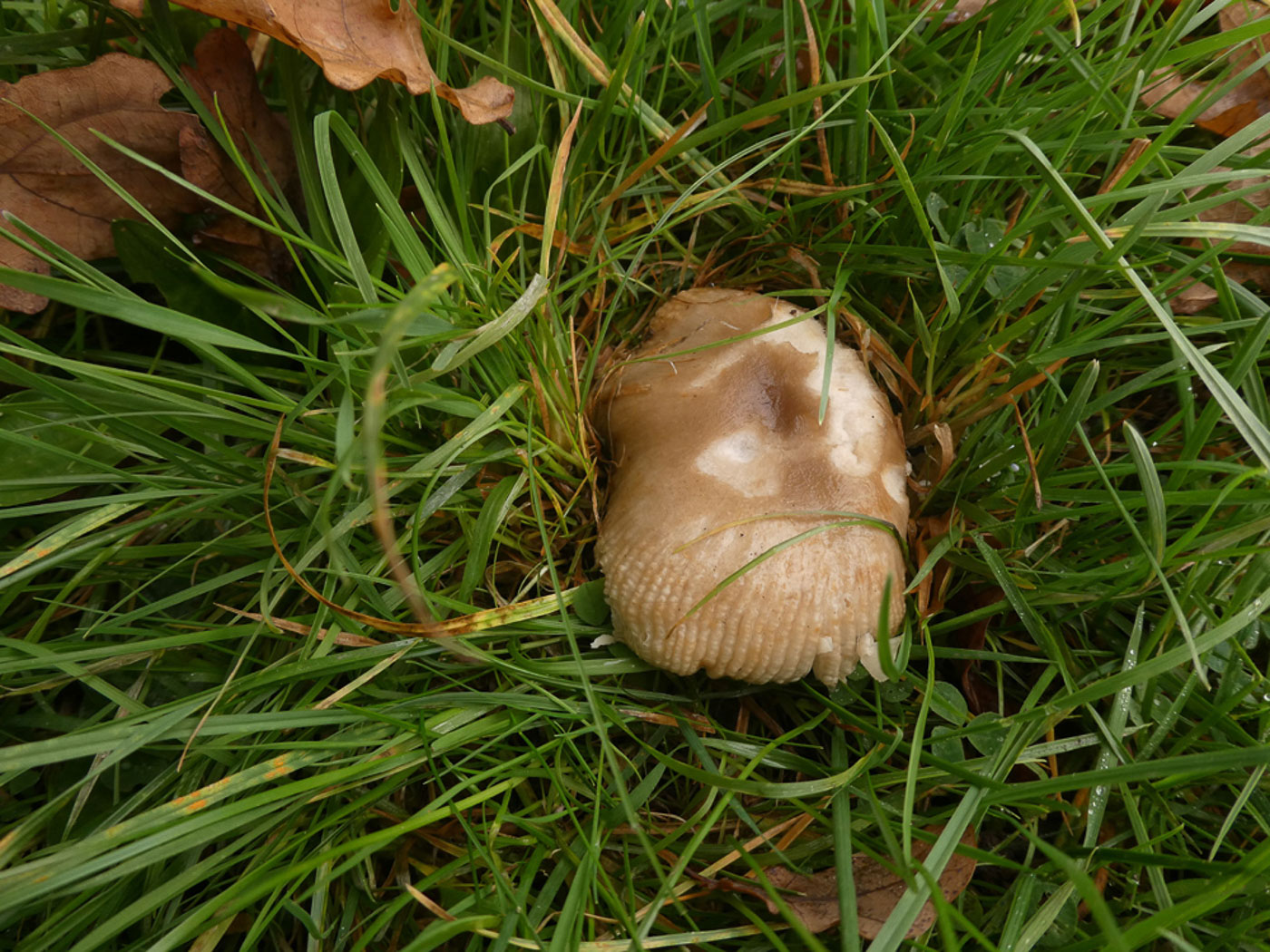 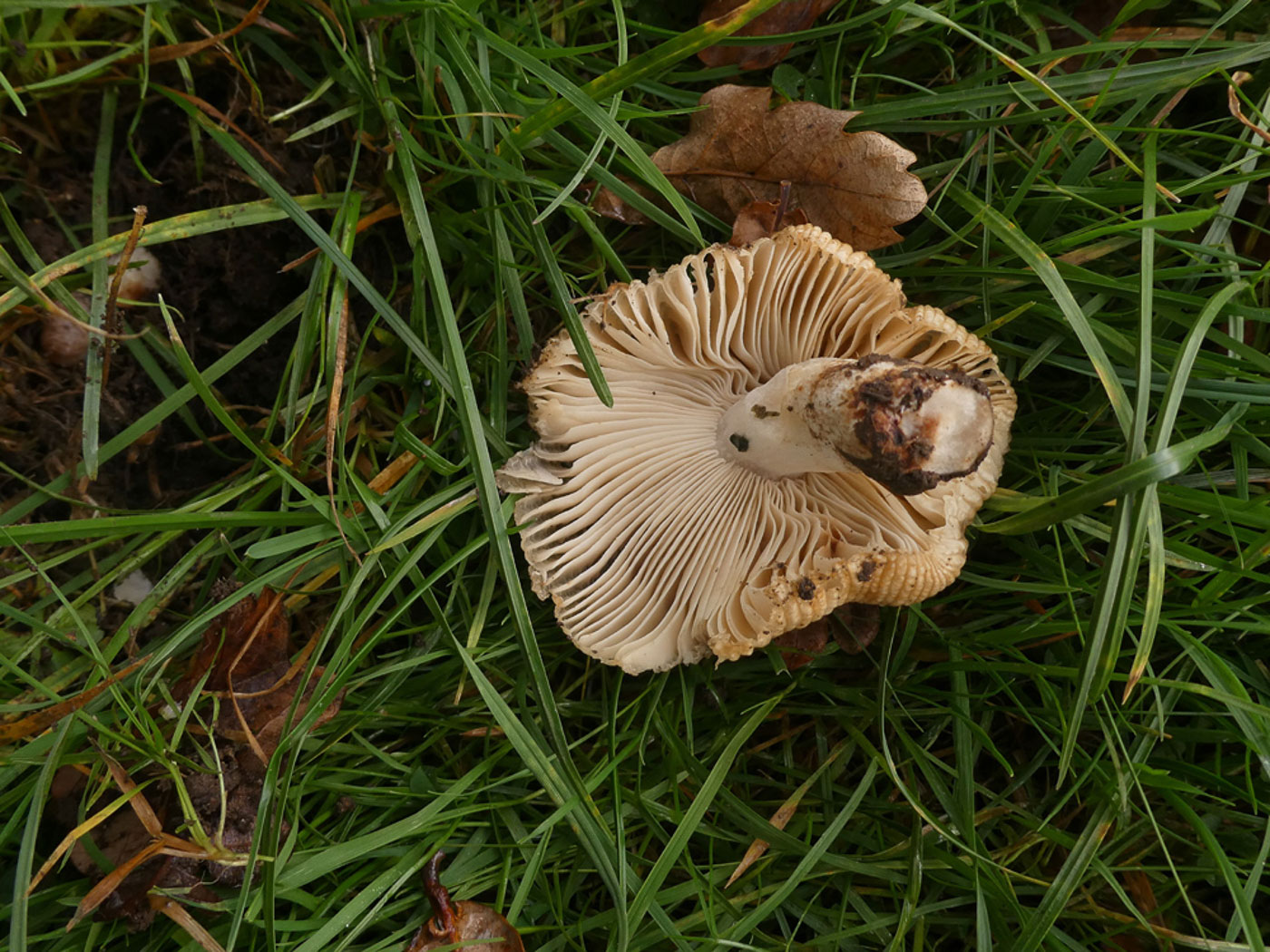 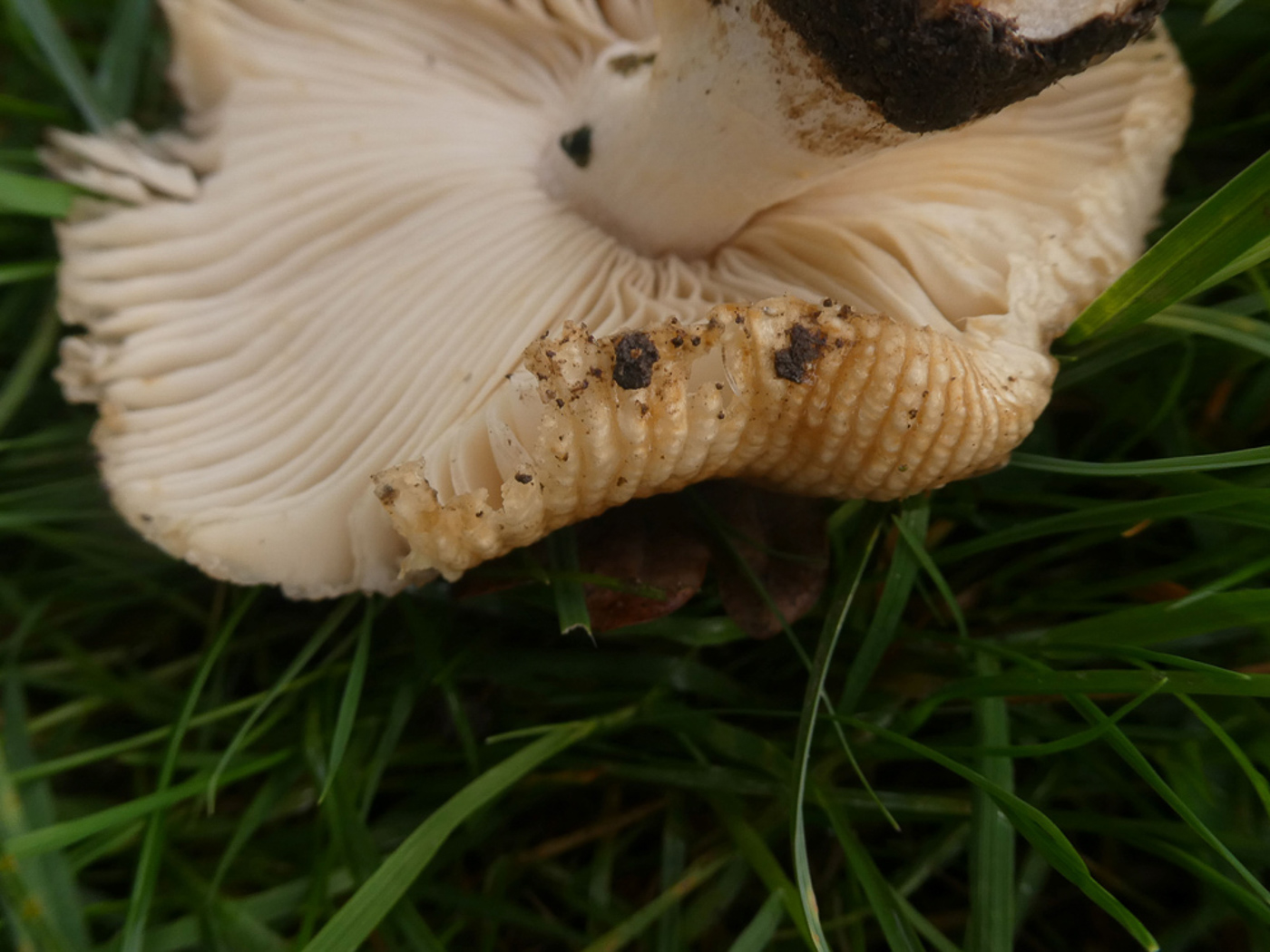 |
Oct 7, 2024. In Austenwood Common Jim Wills found this pale Russula under Oak with which it most commonly occurs. It is one of two very similar species, both belonging to a group of Brittlegills commonly nicknamed 'the smellies' for obvious reasons! Several in this group have an unpleasant cheesy / smelly socks smell and also look very similar being pale and also sticky in wet weather, occurring under Oak. A drop of Guaiac on the stem helps to separate these two, however: it turns deep blue within 10 seconds on R. amoenolens (Camembert Brittlegill and much the commonest of the group) but shows little if any reaction in this time on R. sororia. Jim also discussed this collection with Jesper Launder who confirmed his ID. |
 |
Jul 17, 2023. In Gerrards Cross under Oak Jesper Launder found these rather nondescript Brittlegills which have an unpleasant sour smell - hence a species belonging to the so-called 'Smellies'. The species is more or less identical to the much more common R. amoenolens, also an Oak associate, but a drop of Guaiac on the stem separates them: positive = bright dark blue in R. amoenolens, but negative = little or no change in R. sororia, confirmed today by Jesper. Compare the two species on Finds using the Masterlist. |
  |
Aug 1, 2021. In grassy soil under Oak at Cadmore End Penny found a couple of Brittlegills clearly belonging to a group affectionately known as the 'Smellies'! This particular species is extremely similar to the much more common R. amoenolens (Camembert Brittlegill) and it is only in fairly recent times that it was realised that the two species could be separated by using the reagent Guaiac (derived from a resin) on the stem: instantly bright deep blue in R. amoenolens but negative to very little blue reaction in R. sororia. Prior to this knowledge the name R. sororia was applied to any similar collections, but as we now realise that R. amoenolens is really common and R. sororia quite rare many of the previous records are probably incorrect. We have about 20 (doubtful) county records named as R. sororia but very few since the turn of the century (which are likely to have been checked with Guaiac) and none since 2010, so today's find was notable. Photo 2 here shows the slight colour change after Guaiac was applied, but compare this photo with R. amoenolens dated July 16th showing the really positive reaction. Both species are mycorrhizal with Oak. |
| Russula sororia forma pseudoaffinis (a very rare form of Sepia Brittlegill) |
 |
Sep 24, 2022.  In Denham village under Lime Jesper Launder found this very unusual Brittlegill - one not recorded previously in the county. Very similar to R. sororia (which in turn is very similar to common R. amoenolens - found also today by Penny) it has a darker cap and the surface is not smooth but distinctly disrupted as seen here. Both forms of R. sororia are considered rare and can be separated from R. amoenolens by the Guaiac test: instant dark blue in R. amoenolens (see Penny's photo) but with a very slow negative colour change in both R. sororia and today's forma. The ID of today's find has been confirmed with DNA sequencing, also by Danish Russula expert Felix Hampe and will be sent to the Kew Fungarium. In Denham village under Lime Jesper Launder found this very unusual Brittlegill - one not recorded previously in the county. Very similar to R. sororia (which in turn is very similar to common R. amoenolens - found also today by Penny) it has a darker cap and the surface is not smooth but distinctly disrupted as seen here. Both forms of R. sororia are considered rare and can be separated from R. amoenolens by the Guaiac test: instant dark blue in R. amoenolens (see Penny's photo) but with a very slow negative colour change in both R. sororia and today's forma. The ID of today's find has been confirmed with DNA sequencing, also by Danish Russula expert Felix Hampe and will be sent to the Kew Fungarium.
|
| Russula subfoetens (Least Stinking Brittlegill) |
  |
Jul 30, 2023. Under Oak at Turville Heath Penny first spotted one fruitbody just emerging through the thick leaf litter (photo 1), then saw a few more nearby to illustrate this species, though waited to put a drop of KOH on the stem at home to decide if this was R. foetens or R. subfoetens: golden yellow for the latter but just dirty brownish for the former. Both are members of the so-called 'smellies', are often slimy viscid and tightly inrolled when young like Paxillus involutus (Brown Rollrim). Clearly the rodents must like cheese (!) because the caps are well nibbled with little of the dirty ochre cap colour remaining here. |
  |
Jul 19, 2021. In a grassy glade at Burnham Beeches Penny found two species of Brittlegill in soil near Birch and Oak. Both were fairly damaged as is often the case when this genus first makes an appearance, being a favourite with squirrels, mice and slugs amongst other nibblers, so are not looking their best, in fact the cap surface of the large specimen here has been mostly eaten away. R. subfoetens (as its name suggests) is another member of 'The Smellies' (see also R. amoenolens 3 days earlier) and very similar to R. foetens (Stinking Brittlegill). Both species are quite large and bulky with ochre yellow–brown caps which are sticky (an unusual Brittlegill character), very brittle gills and an unpleasant rancid smell. They are best told apart by a drop of KOH on the stem flesh: golden yellow in subfoetens and dirty brown in foetens. Todays species is probably the commoner of the two in the south.
|
  |
Sep 22, 2020. Penny Cullington found this collection under Birch at Turville Heath. The species belongs to a group of Brittlegills affectionately known as 'the smellie', most of which grow under Oaks though both this one and its lookalike R. foetens occur under a variety of deciduous trees. Both are quite uncommon, have a sour rancid smell, also sticky caps (glutinous in wet weather) - unusual for the genus, and have a dull rusty reaction when rubbed with a crystal of ferrous sulphate on the stem (seen here). The easiest way to split them is to place a drop of KOH on the stem - no reaction with R. foetens but quickly golden in R. subfoetens as seen in the singleton photo. |
| Russula velenovskyi (Coral Brittlegill) |
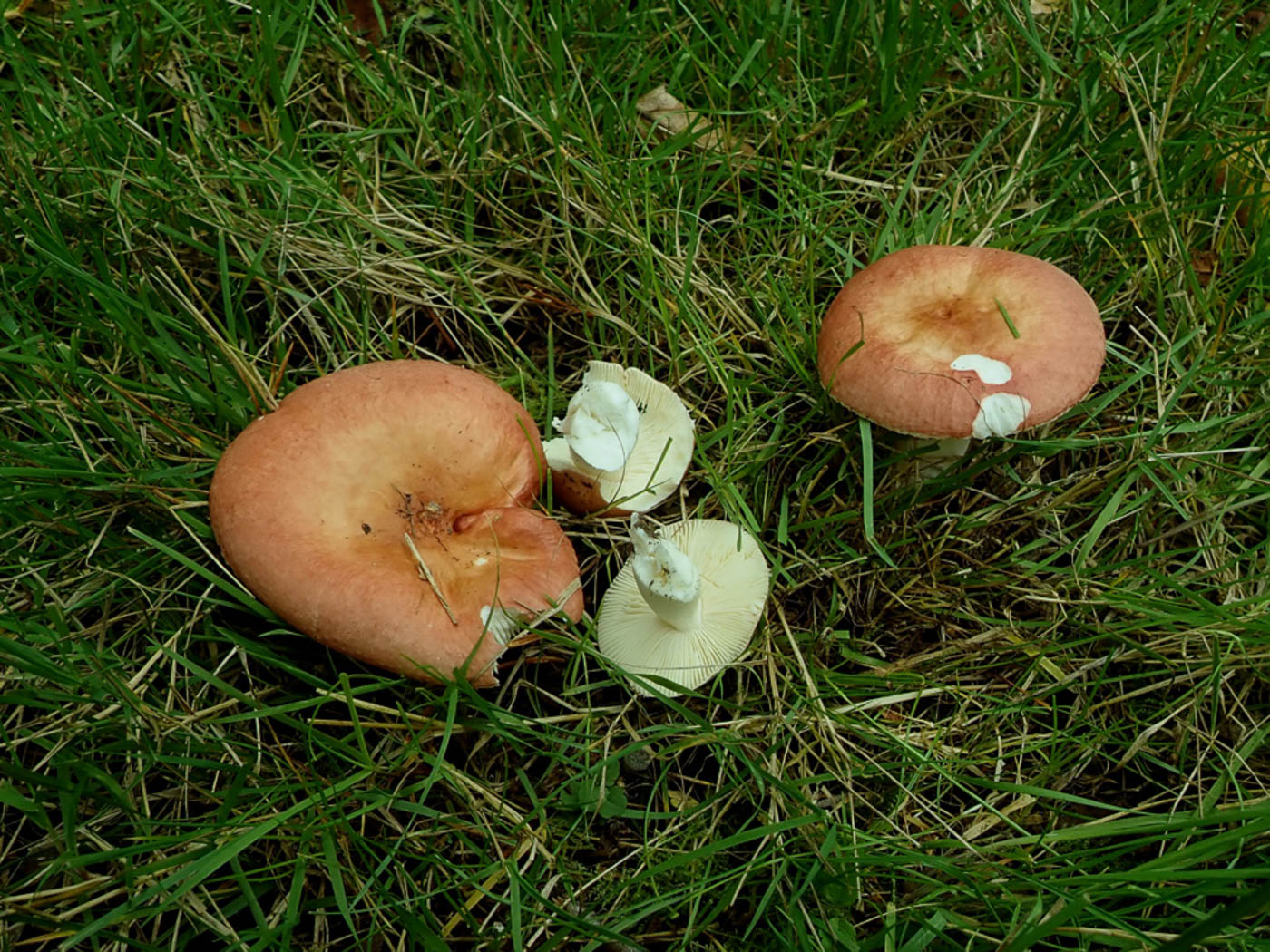
|
Oct 11, 2025. In Naphill after the end of our BFG walk which covered purely the Common, we found this photogenic collection under Birch near a pond. The coral pink cap with creamier centre, cream gills and white stem are all typical of this quite common species. The photo is Sarah Ebdon's |
  |
Jul 17, 2023. In Gerrards Cross Common under Oak Jesper Launder found quite a few of these but most were well nibbled by squirrels apart from this photogenic pair. One of many red-capped species, the species is quite common and distinctly terra-cotta to coral red rather than pink or purple and often has a broad more orange umbo though is a little sunken around this. It has a white stem and gills and occurs under various deciduous trees. A few days later in Bernwood Forest Penny found two more typical examples, also thoroughly nibbled (photo 2). |
 |
Sep 1, 2021. Under Birch in Burnham Beeches Penny found several specimens of this quite common species dotted about, then brought them together to show how the cap colour can vary. It is a small to medium species, the cap often with a paler and slightly domed orange/coral centre but it can also be much brighter red as seen on the left. The gills are pale cream and the stem usually white though sometimes with a faint pink tinge - just visible in the top specimen. (See also the collection dated July 19th for comparison.) |
 |
Jul 19, 2021. In a grassy glade at Burnham Beeches Penny found this brightly coloured and common species in soil under Birch and Oak. Features to look for which separate it from other equally common red Brittlegills in the field: the cap is shiny, has brick to coral rather than pink tones and often has a paler umbo in the centre (as seen here). Gills, which start out white, become cream as it matures. We have many records from all over the south of the county. |
 |
Sep 15, 2020. Penny Cullington found this collection under mixed deciduous trees at Burnham Beeches. One of the many red-capped Brittlegills, the cap of this species has subtle brick to orange or coral red tones and is usually distinctly paler in the centre where often slightly domed. Note also the slight pink flush on the stem sometimes present and seen here on the central young specimen. It is fairly common under deciduous trees, particularly Oak. |
| Russula veternosa (a rare species of Brittlegill with no English name) |
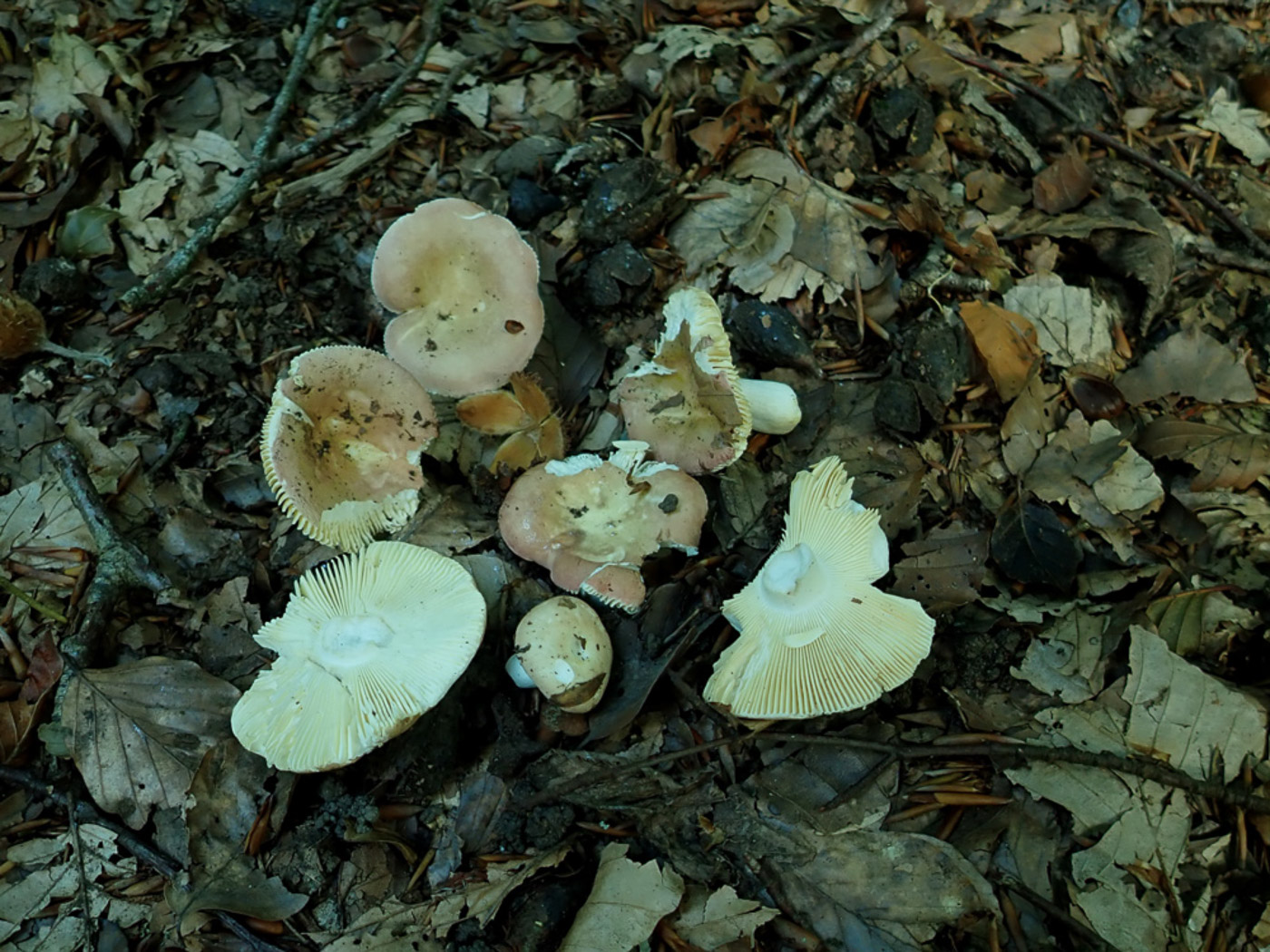
|
Sep 29, 2025.  In Gussetts Wood under Beech Penny found good numbers of this pale peachy pink Brittlegill, noting that the cap centres were yellower. She didn't recognise it so it was keyed out at home, whereupon she shared this photo with Geoffrey Kibby who agreed it was spot on for this species - one which they'd found together at Mousells Wood on three occasions several years ago. It clearly favours our Chiltern beechwoods but is considered rare with not that many UK records. In Gussetts Wood under Beech Penny found good numbers of this pale peachy pink Brittlegill, noting that the cap centres were yellower. She didn't recognise it so it was keyed out at home, whereupon she shared this photo with Geoffrey Kibby who agreed it was spot on for this species - one which they'd found together at Mousells Wood on three occasions several years ago. It clearly favours our Chiltern beechwoods but is considered rare with not that many UK records. |
Russula velutipes (previously aurora) (Dawn Brittlegill)  |
    |
Jul 15, 2023. In Downley Common Wood John Catterson found this quite common and attractive Brittlegill under mixed deciduous trees, took it home to work on and correctly identified it - often no easy task with this genus! This was a large specimen, 9 cm across, with the typical cap colours for the species: peachy pink but yellow cream in the centre, pale cream gills, flesh with a mild taste and a white stem. He also checked the microscopic characters to confirm. Photos 3 and 4 are of a much paler example found by Penny in Kings Wood Tylers Green 4 days later. The species name is somewhat confusing because at one stage it was called R. rosea, but that name was then assigned to another species which had previously been called R. lepida. It was then named R. aurora (not to be confused with R. aurea which is an entirely different species!), but then an earlier name R. velutipes was reintroduced as yet another alternative! The ensuing chaos remains with some authors favouring one name, some the other, and earlier records in confusion! Penny here follows Index Fungorum which has not yet adopted R. velutipes though this may well happen at some stage. At least the common names (Dawn Brittlegill as opposed to Rosy Brittlegill - what was R. lepida) remain constant. |
 |
Sep 16, 2020. Not to be confused with the similarly named and rare R. aurea (see photo dated Sept 13th), this fairly common Brittlegill was found in Penn Wood under Beech by John Catterson and Penny Cullington. Yet another species with red tones in the cap, this one has peach pink tones with a paler cream centre which is often slightly sunken. It has a pure white rather fragile stem and the gills are pale cream. (In some texts this is named Russula velutipes to add to the confusion!) |
| Russula vesca (The Flirt) |
   |
Jul 25, 2023. Under Oak in Bernwood Forest Penny and Paul found good numbers of this common Brittlegill though the range of cap colour was notable (hence the three images presented here). The bright salmon pink markings on both stem and gills seen here are the instant reaction to being rubbed with a Ferrous Sulphate crystal - proof positive of the ID: this is one of only two Brittlegills to show this reaction (see the other species below!). Today this test proved very useful with so much variation in cap colour. The larger paler cap in photo 3 is just beginning to show the reason for the common name here: the cuticle at the edge tends to shrink back to reveal the white gill edge like a petticoat! |
    |
Jul 12, 2021. In Burnham Beeches under Oak Penny was not surprised to find this member of the Brittlegills - a genus which tends to be amongst the first of the Autumn woodland genera to make an appearance. Photo 1 shows a rather pale pink cap where the edges are just beginning to recede thus revealing the white gills beneath (suggesting a petticoat showing under a lady's skirt - hence the common name!). Photo 2 shows this pale specimen upturned and rubbed (stem and gills) with a crystal of ferrous sulphate, together with a younger specimen having a much darker typically smoked gammon pink cap, illustrating the varied cap colour of the species. The crystal is a useful tool because amongst the many pink capped species of the genus R. vesca is alone in reacting so positively - both on stem and gills - giving a deep rusty salmon pink stain instantly to confirm its determination in the field. Photo 3 is of a more mature specimen found by Jesper Launder in Jordans village 10 days later and showing a generous and flirtatious amount of petticoat! Photo 4 is Penny's collection from Penn Wood on August 14th, also under Oak, again showing the strong reaction with a crystal. |
   |
Sep 17, 2020. Penny Cullington found this surprisingly fresh singleton under Oak at Cadmore End. Yet another red capped Brittlegill, this one is described as the colour of smoked gammon though the caps can sometimes be much paler than this particular singleton specimen. (See third photo of a collection found two days later in Penn Wood.) Another useful field clue to look for is the way the cap cuticle (coloured surface) starts to retract at the margin, increasingly with age, thus leaving a thin white rim where the gills show through - hence its imaginative common name suggesting a lady saucily showing her white petticoat! A more technical feature: a crystal of Ferrous Sulphate rubbed on both stem and gills quickly turns intensely smoked salmon pink (only one other species reacts like this but it has a green cap - R. heterophylla). Both the petticoat effect and the crystal reaction are visible in the second and third photos. (Remember: smoked gammon and smoked salmon!) |
| Russula violacea (a rare Brittlegill with no English name) |
 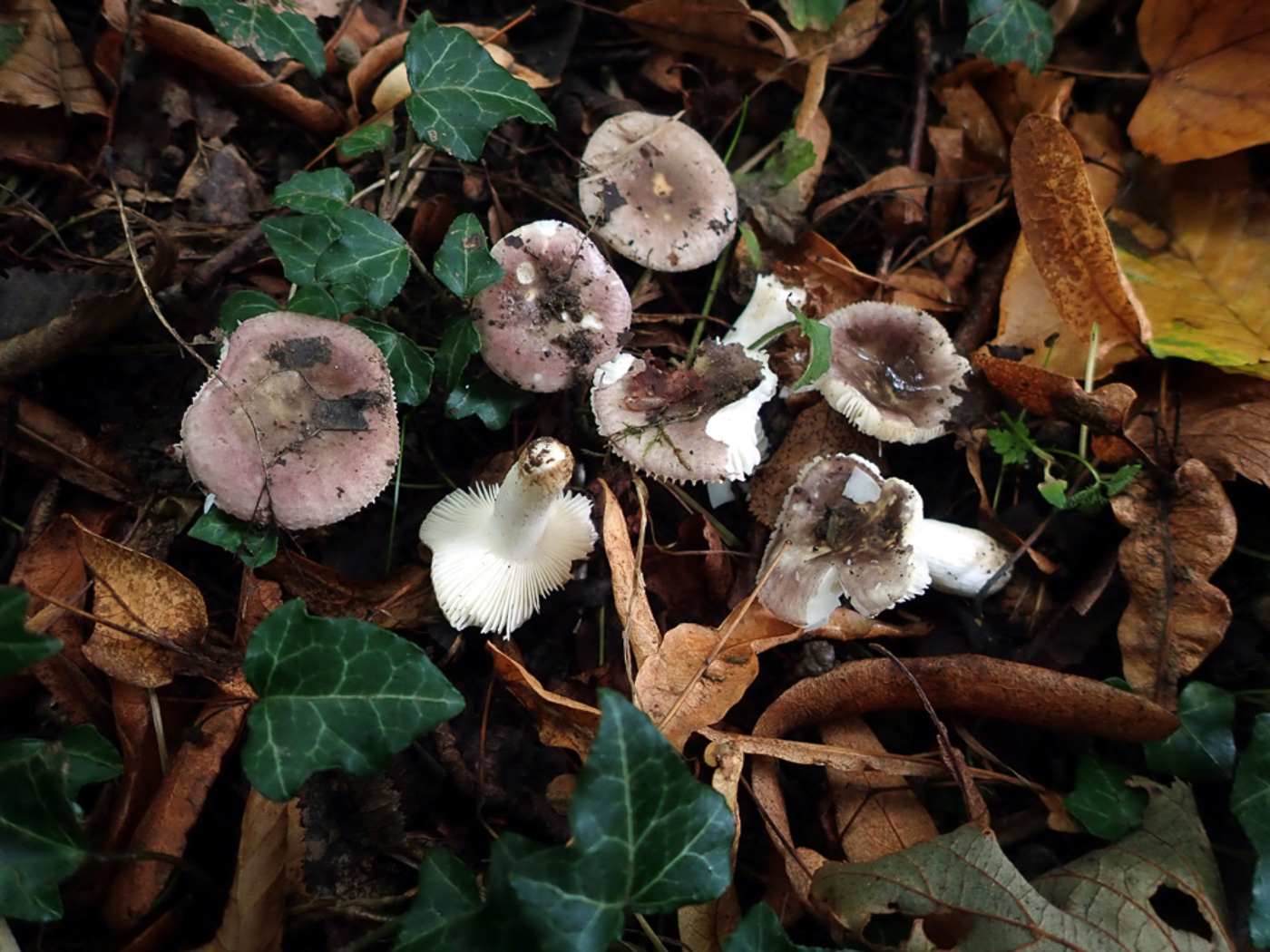
|
Sep 14, 2025.  At the beginning of August Penny collected a Russula from under Lime at Turville Heath (photo 1) which she could not confidently identify. A month later she took the dried specimen plus spore print, full description and DNA sequence to show Geoffrey Kibby and Felix Hampe (recognised gurus of this genus) who were then able to name this R. violacea, new to the county and with not many UK records - probably none verified with sequencing. She was delighted to find further specimens fruiting here today under the same tree, and though the diagnostic strong sweet smell of Pelargonium had been missing from her first collection (hence the doubt over the ID) it was comfortingly very noticeable today once contained in a pot for a few minutes. At the beginning of August Penny collected a Russula from under Lime at Turville Heath (photo 1) which she could not confidently identify. A month later she took the dried specimen plus spore print, full description and DNA sequence to show Geoffrey Kibby and Felix Hampe (recognised gurus of this genus) who were then able to name this R. violacea, new to the county and with not many UK records - probably none verified with sequencing. She was delighted to find further specimens fruiting here today under the same tree, and though the diagnostic strong sweet smell of Pelargonium had been missing from her first collection (hence the doubt over the ID) it was comfortingly very noticeable today once contained in a pot for a few minutes. |
| Russula violeipes (Velvet Brittlegill) |
 |
Jul 25, 2021.  In a roadside verge in Jordans village Jesper Launder spotted several species of Russula growing under a mix of Oak, Beech and Birch. This particular species was probably associating with Oak or Beech and in some years can be quite common. The cap has a cuticle which is rather elastic and reluctant to peel - a feature worth noting because the cap colour is somewhat variable and often bright yellow (not so here, however). The stem is where the violet colour usually presents, though Jesper's specimens seem to have violet spotting on the cap which is quite unusual. Hopefully more typical collections will be found to further illustrate the species. In a roadside verge in Jordans village Jesper Launder spotted several species of Russula growing under a mix of Oak, Beech and Birch. This particular species was probably associating with Oak or Beech and in some years can be quite common. The cap has a cuticle which is rather elastic and reluctant to peel - a feature worth noting because the cap colour is somewhat variable and often bright yellow (not so here, however). The stem is where the violet colour usually presents, though Jesper's specimens seem to have violet spotting on the cap which is quite unusual. Hopefully more typical collections will be found to further illustrate the species.
|
| Russula xerampelina (Crab Brittlegill) |
  |
Sep 30, 2020. Penny Cullington was surprised and pleased to find this rare species under a mature Pine, its host tree, at Turville Heath. Though we have quite a few county records named as this species it is likely that most of them are incorrect. Until fairly recently it was safe to name any Brittlegill which developed a smell of cooked crab and the stem, when rubbed with a Ferrous Sulphate crystal, turned dark green, as R. xerampelina. It is now known that this is a large complex of species still not fully understood. In the south we find and recognise about three of these, one of which (R. faginea dated Sept 27) grows under Beech. What we now call the true R. xerampelina (which grows exclusively under Pine) is common in Scotland but considerably less so elsewhere. It is a large robust Brittlegill with a blood red to purplish red cap with a substantial clavate stem having distinct pink red patches.
|
| Rutstroemia conformata (an Ascomycete with no English name) |
 |
May 19, 2021. At Burnham Beeches Kerry Robinson found this uncommon tiny stalked cup fungus on the central rib of a rotting Alder leaf. It occurs in late spring / early summer mainly on leaves of Alder, occasionally also of Birch, Poplar or Willow, the cups less than 5mm across but sometimes with relatively long stems. A species not often noticed and recorded, yet again this is new to the site and to the county. (Photo Claudi Soler)
|
| Rutstroemia firma (Brown Cup) |
   |
Nov 8, 2022.  In Austenwood Common Jim Wills came across these small cups fruiting in various stages of development on fallen Hazel. He thought to begin with that there must be more than one species here because they seemed to vary so much, but microscopy confirmed they were all the same - it just is a very varied species, sometimes with a stem, sometimes not. This is new for Finds though is not rare, just easily overlooked, and can occur on Oak and Alder as well as Hazel, often on branches still attached. In Austenwood Common Jim Wills came across these small cups fruiting in various stages of development on fallen Hazel. He thought to begin with that there must be more than one species here because they seemed to vary so much, but microscopy confirmed they were all the same - it just is a very varied species, sometimes with a stem, sometimes not. This is new for Finds though is not rare, just easily overlooked, and can occur on Oak and Alder as well as Hazel, often on branches still attached.
|
| Rutstroemia sydowiana (Oakleaf Cup) |
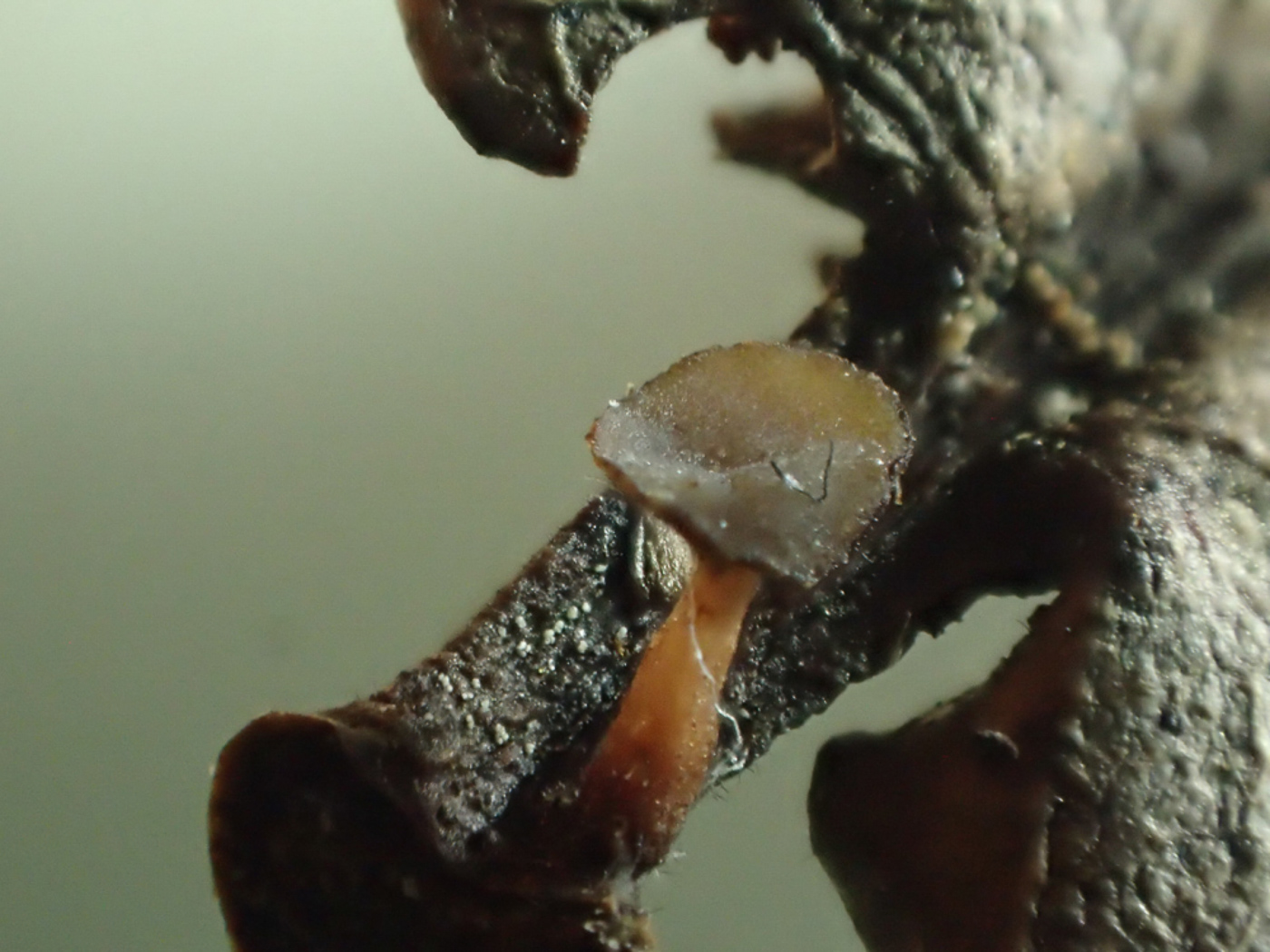
.jpg)
|
Nov 11, 2025.  In Burnham Beeches Sarah picked up a dead Oak leaf to examine for tiny fungi, then at home with higher magnification she noticed there were two more species lurking there which she'd not noticed on collection, one being this minute stemmed disc on the end of the petiole. It keyed out perfectly to this species for which we have just one previous sequenced record, from this site in 2022 when found by Sarah and identified by Derek. In fact Sarah found this same species again on our BFG walk at Stoke Common the following day. In Burnham Beeches Sarah picked up a dead Oak leaf to examine for tiny fungi, then at home with higher magnification she noticed there were two more species lurking there which she'd not noticed on collection, one being this minute stemmed disc on the end of the petiole. It keyed out perfectly to this species for which we have just one previous sequenced record, from this site in 2022 when found by Sarah and identified by Derek. In fact Sarah found this same species again on our BFG walk at Stoke Common the following day. |

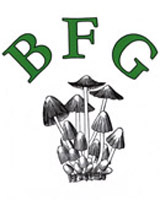










































































.jpg)
.jpg)




























































































































































































































.jpg)
.jpg)






















































.jpg)